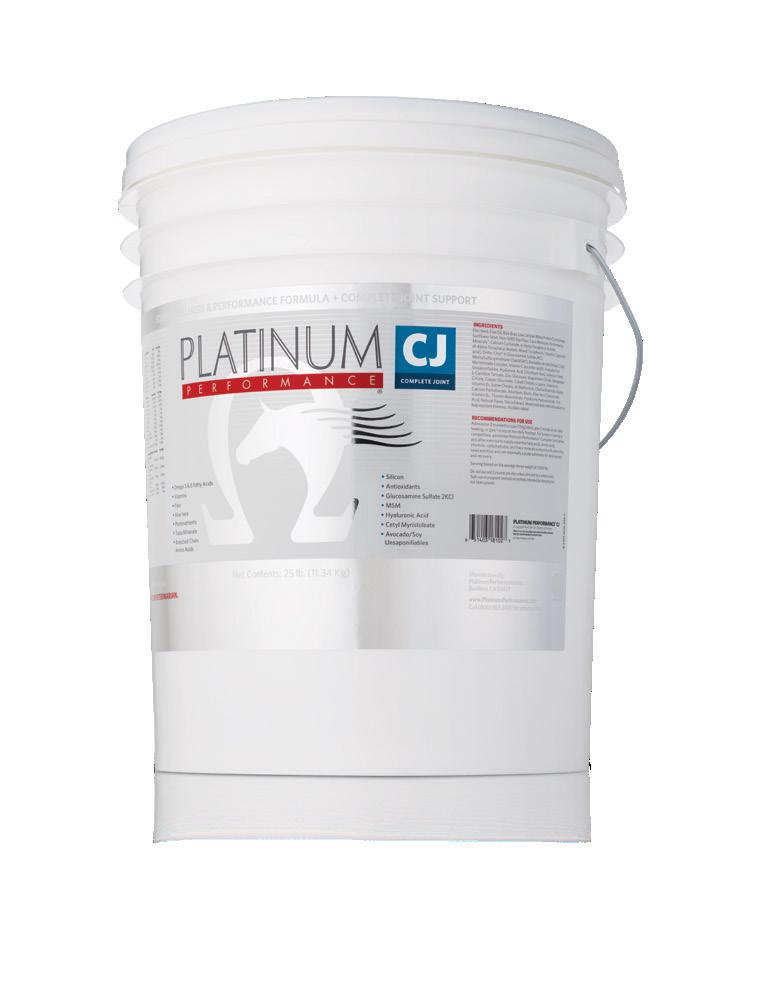Katie Duerrhammer: Work Ethic Pays off for Former Young Rider (p. 38)

What We Wish We’d Known About Dressage:

Wisdom from Top Trainers
Scott Hassler: The Modern Master Shares His Approach (p. 24)

Katie Duerrhammer: Work Ethic Pays off for Former Young Rider (p. 38)


Wisdom from Top Trainers
Scott Hassler: The Modern Master Shares His Approach (p. 24)
Your supplements:
Neigh-Lox® original pellet
Your product of choice when a healthy, comfortable stomach is the focus.
• Maintains normal gastric acid levels.
• Sustains a healthy stomach lining.
• Keeps horses comfortable during times of stress.
• Long-acting formula is recommended for horses of all ages.

ProbioticWise® powder or paste
Your product of choice when a balanced hindgut and robust microbiome are your goals.
• Captures and sweeps out pathogenic bacteria.
• Supports healing and a return to normal gut function.
• Sustains a healthy microbiome.
• Contains Saccharomyces boulardii (a true probiotic) and broad-spectrum prebiotics.
Neigh-Lox® Advanced pellet


Choose when both a healthy, comfortable stomach and balanced hindgut are what your horse needs.

• Maintains normal gastric acid levels and a healthy mucosal lining.
• Supports healthy tissues, normal pH, and balanced hindgut.
• Sustains a resilient microbiome.
• Contains a proprietary blend of Saccharomyces boulardii (a true probiotic), broad-spectrum prebiotics and ingredients that support a comfortable stomach.
e s s a g e a t D e v o n 2 0 2 3 S e p t e m b e r 2 6 - O c t o b e r 1 , 2 0 2 3
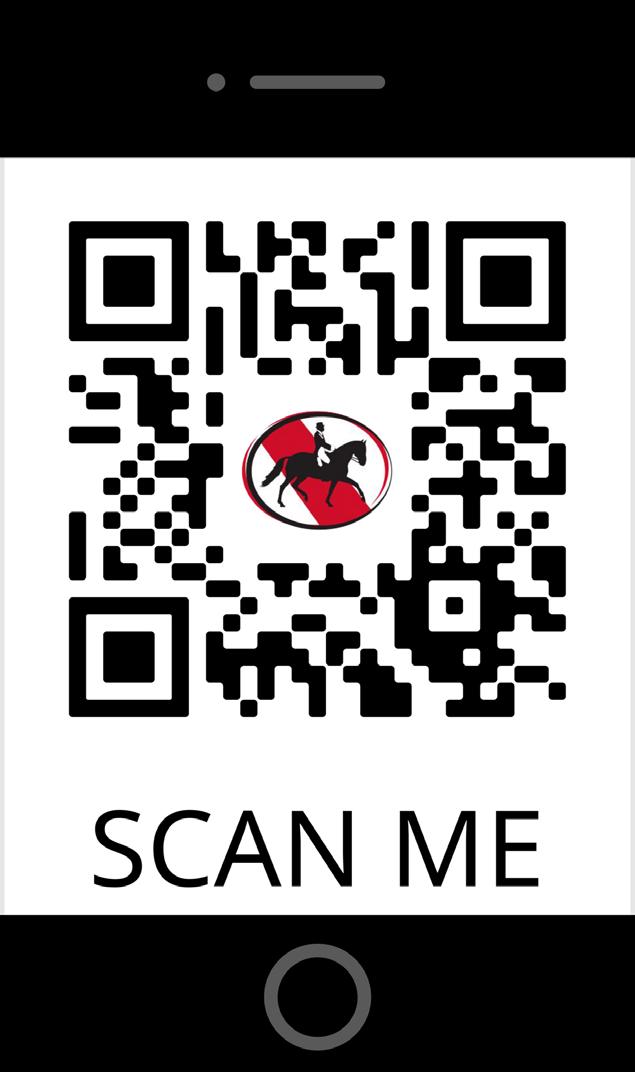
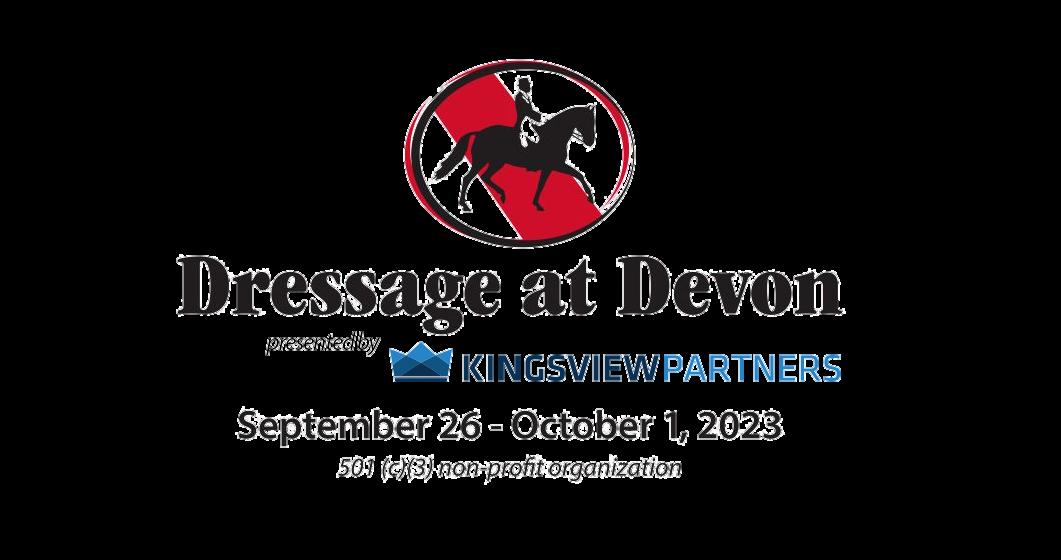


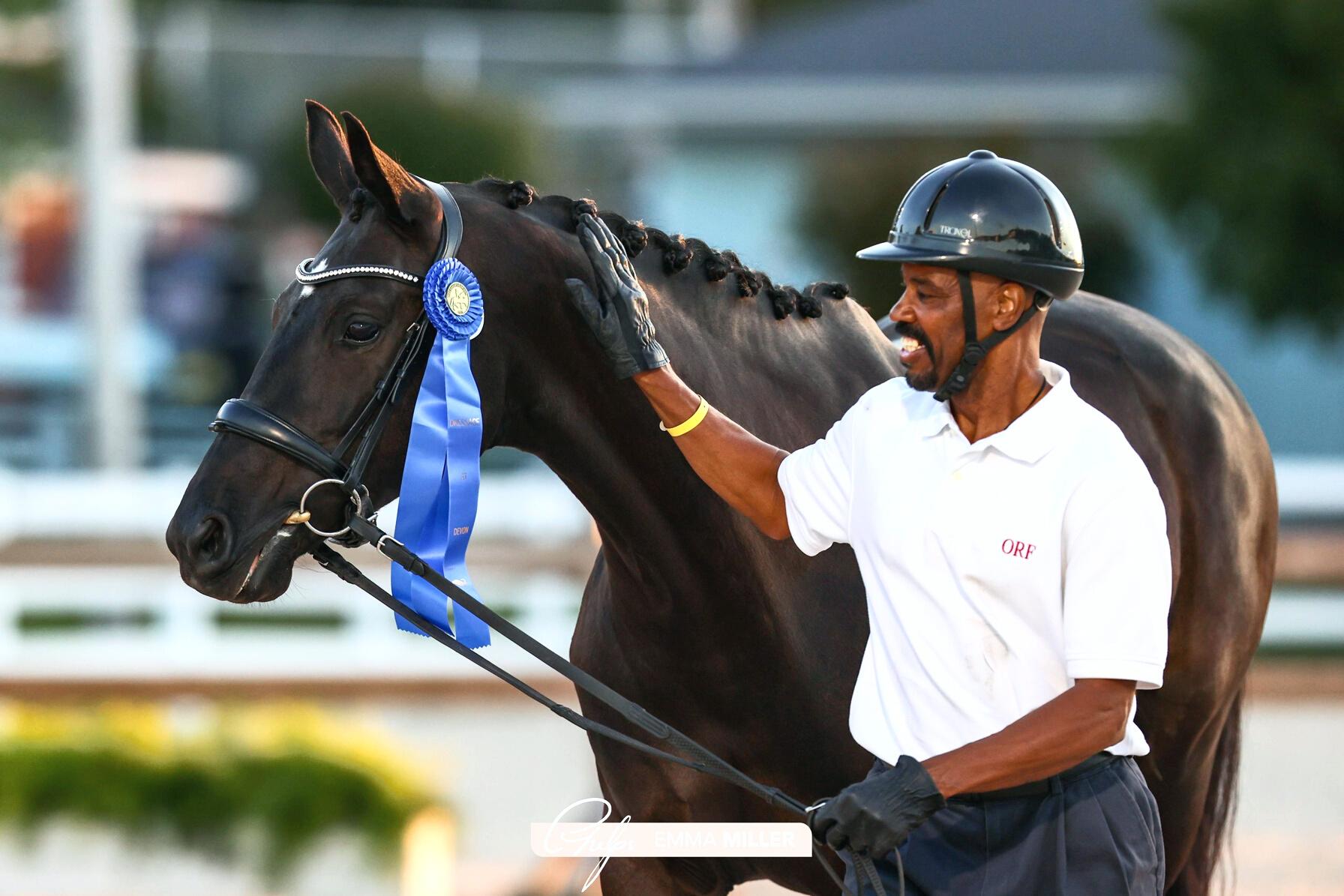
T U E S D A Y &
W E D N E S D A Y
S e p . 2 6 - 2 7
U S E F H e r i t a g e
S h o w - B r e e d
D i v i s i o n
T H U R S D A Y
S e p . 2 8

C a t h r i n e
L a u d r u p - D u f o u r
M a s t e r C l a s s
F R I D A Y
S e p . 2 9
C D I 3 * G r a n d P r i x & C D I - W S h o r t

G r a n d P r i x
S A T U R D A Y
S e p . 3 0
C D I 3 * G r a n d
P r i x S p e c i a l &
C D I - W G r a n d
P r i x F r e e s t y l e
S U N D A Y
O c t . 1
J u n i o r , Y o u n g
R i d e r , A m a t e u r , &
C D I 3 * I n t e r m e d i a t e
I F r e e s t y l e
T o l e a r n m o r e a b o u t a l l
o f t h e e x c i t i n g p a r t i e s ,
m e e t & g r e e t s , a n d
m o r e s c a n t h e Q R c o d e
YourDressage delivers exclusive dressage stories, editorial, and education, relevant to ALL dressage enthusiasts and is your daily source for dressage!
Look for these featured articles online at YourDressage.org

Proactive wellness care can help horses - and their joints - move comfortably into their golden years, extending their careers and your time cherishing them.
A Region 2 adult amateur shares why swinging her leg over her red mare feels like coming home.
A Region 7 rider shares about suffering a traumatic brain injury (TBI) and how her love of horses helped her overcome the physical and mental impacts of it.

An equestrian in Region 1 shares about being “plus-size” and “disabled”, and finding ways to escape the negative connotations people think when hearing either phrase.
It’s YourDressage, be a part of it! Visit https://yourdressage.org/ for all these stories & much more!
The Official Publication of the United States Dressage Federation
EXECUTIVE DIRECTOR Stephan Hienzsch (859) 271-7887 • stephh1enz@usdf.org
EDITOR Jennifer O. Bryant (610) 344-0116 • jbryant@usdf.org
CONTRIBUTING EDITOR Hilary M. Clayton, BVMS, PhD, MRCVS EDITORIAL ADVISORS
Margaret Freeman (NC), Anne Gribbons (FL), Roberta Williams (FL), Terry Wilson (CA)
TECHNICAL ADVISORS Janine Malone, Lisa Gorretta, Elisabeth Williams
PRODUCTION Emily Koenig • ekoenig@usdf.org
GRAPHIC & MULTIMEDIA COORDINATOR Katie Lewis (859) 271-7881 • klewis@usdf.org
ADVERTISING SALES REPRESENTATIVE Danielle Titland (720) 300-2266 • dtitland@usdf.org
USDF OFFICERS AND EXECUTIVE BOARD
PRESIDENT GEORGE WILLIAMS 421 Park Forest Way, Wellington, FL 33414 (937) 603-9134 • president@usdf.org
VICE PRESIDENT KEVIN REINIG, 6907 Lindero Lane, Rancho Murieta, CA 95683 (916) 616-4581 • vicepresident@usdf.org
SECRETARY DEBRA REINHARDT 16305 63rd Road N, Loxahatchee, FL 33470 (203) 264-2148 • secretary@usdf.org
TREASURER LORRAINE MUSSELMAN 7538 NC 39 Hwy, Zebulon, NC 27497 (919) 218-6802 • treasurer@usdf.org
REGIONAL DIRECTORS
REGION 1 DC, DE, MD, NC, NJ, PA, VA
BETTINA G. LONGAKER 8246 Open Gate Road, Gordonsville, VA 22942 (540) 832-7611 • region1dir@usdf.org
REGION 2 IL, IN, KY, MI, OH, WV, WI DEBBY SAVAGE 7011 Cobblestone Lane, Mentor, OH 44060 (908) 892-5335 • region2dir@usdf.org
REGION 3 AL, FL, GA, SC, TN
CHARLOTTE TRENTELMAN P.O. Box 381, Anthony, FL 32617 (352) 598-7704 • region3dir@usdf.org
REGION 4 IA, KS, MN, MO, NE, ND, SD
ANNE SUSHKO 1942 Clifford Street, Dubuque, IA 52002 (563) 580-0510 • region4dir@usdf.org
REGION 5 AZ, CO, E. MT, NM, UT, W. TX, WY
HEATHER PETERSEN 22750 County Road 37, Elbert, CO 80106 (303) 648-3164 • region5dir@usdf.org
REGION 6 AK, ID, W. MT, OR, WA
NOAH RATTNER 25033 SW Pacific Hwy, Sherwood, OR 97140 (503) 449-1274 • region6dir@usdf.org
REGION 7 CA, HI, NV
CAROL TICE 31895 Nicolas Road, Temecula, CA 92591 (714) 514-5606 • region7dir@usdf.org
REGION 8 CT, MA, ME, NH, NY, RI, VT
HELEN VAN DER VOORT 8 Boulevard West, PH4, Pelham, NY 10803 (917) 834-2635 • region8dir@usdf.org
REGION 9 AR, LA, MS, OK, TX
BESS BRUTON 5696 Piper Lane, College Station, TX 77845 (662) 702-9854 • region9dir@usdf.org
AT-LARGE DIRECTORS
ACTIVITIES COUNCIL
SUE MANDAS 9508 Bridlewood Trail, Dayton, OH 45458 (937) 272-9068 • ald-activities@usdf.org
ADMINISTRATIVE COUNCIL
BARBARA CADWELL 324 Benjamin Street, Fernandina Beach, FL (715) 350 1967 • ald-administrative@usdf.org
TECHNICAL COUNCIL
SUE MCKEOWN 6 Whitehaven Lane, Worcester, MA 01609 (508) 459-9209 • ald-technical@usdf.org
USDF Connection is published bimonthly by the United States Dressage Federation, 4051 Iron Works Parkway, Lexington, KY 40511. Phone: 859/971-2277. Fax: 859/971-7722. E-mail: usdressage@usdf.org, Web site: www. usdf.org. USDF members receive USDF Connection as a membership benefit, paid by membership dues. Copyright © 2023 USDF. All rights reserved.
USDF reserves the right to refuse any advertising or copy that is deemed unsuitable for USDF and its policies. Excluding advertisements, all photos with mounted riders must have safety head gear or USEF-approved competition hat. USDF assumes no responsibility for the claims made in advertisements. Statements of fact and opinion are those of the experts consulted and authors, and do not necessarily reflect the opinions of the editors or the policy of USDF.
The publishers reserve the right to reject any advertising deemed unsuitable for USDF, as well as the right to reject or edit any manuscripts received for publication. USDF assumes no responsibility for unsolicited material. All materials must be accompanied by a self-addressed, stamped envelope.
Questions about your subscription or change in address? Contact USDF Membership Department, 859/971-2277, or usdressage@usdf.org.
POSTMASTER: SEND ADDRESS CHANGES TO: USDF, 4051 IRON WORKS PARKWAY, LEXINGTON, KY 40511. Canadian Agreement No. 1741527. Canada return address: Station A, P.O. Box 54, Windsor, Ontario N9A 6J5.
38
38 Above and Beyond
Not far removed from the Young Rider ranks, Katie Duerrhammer threw herself into her first full-time instructor/trainer job, coaching a client’s kids. Impressed, the client became a sponsor—and now they’re competing on the world’s biggest stages.
By Kim F. Miller44
What We Wish We’d Known About Dressage

Those who have excelled in their dressage careers offer wisdom By Emily Esterson
50 Prepare for the Worst at the Show
What dressage show management and competitors need to know about disaster preparedness. Second of two parts.
By Judy Nauseef
56 Meet the Candidates
Get to know who’s nominated for USDF Executive Board office this year
On Our Cover
Katie Duerrhammer and Quartett at the 2022 FEI World Dressage Championships in Herning, Denmark. Photo by Jennifer Bryant.
4 Inside USDF The Interscholastic Dressage Experience
By Sue Mandas6 Ringside Letting Go
By Jennifer
O. Bryant18 Sport Horse
Off the Track and into the Ring
By Kara L. Stewart
24 Clinic
Alignment and Micro-Shaping By Beth Baumert
28 GMO
Build a Winning GMO Website By Penny Hawes
32 The Judge’s Box
Understanding Balance By Jayne Ayers
34 Free Rein
Life Happens
By Tillie
Jones62 Tack Shop Horse People Know Best
68 Salute
She Helped to Save the USDF By Katherine Walcott
Basics
8 Sponsor Spotlight
9 Collection
64 Rider’s Market
66 USDF Connection
Submission Guidelines
66 USDF Office Contact Directory
67 Advertising Index
The Interscholastic Equestrian Association offers schoolchildren the opportunity to learn and compete in dressage, even if they don’t own horses
By Sue Mandas, USDF Activities Council At-Large DirectorIrecently had the pleasure of judging the dressage portion of the 2023 Interscholastic Equestrian Association (IEA) Dressage National Finals, held in April at the Tryon International Equestrian Center in North Carolina.
The IEA was established in 2002, with hunter-seat and Western divisions. Its inaugural championship show was held the following year. Dressage was a latecomer, beginning with the 2019-2020 season.
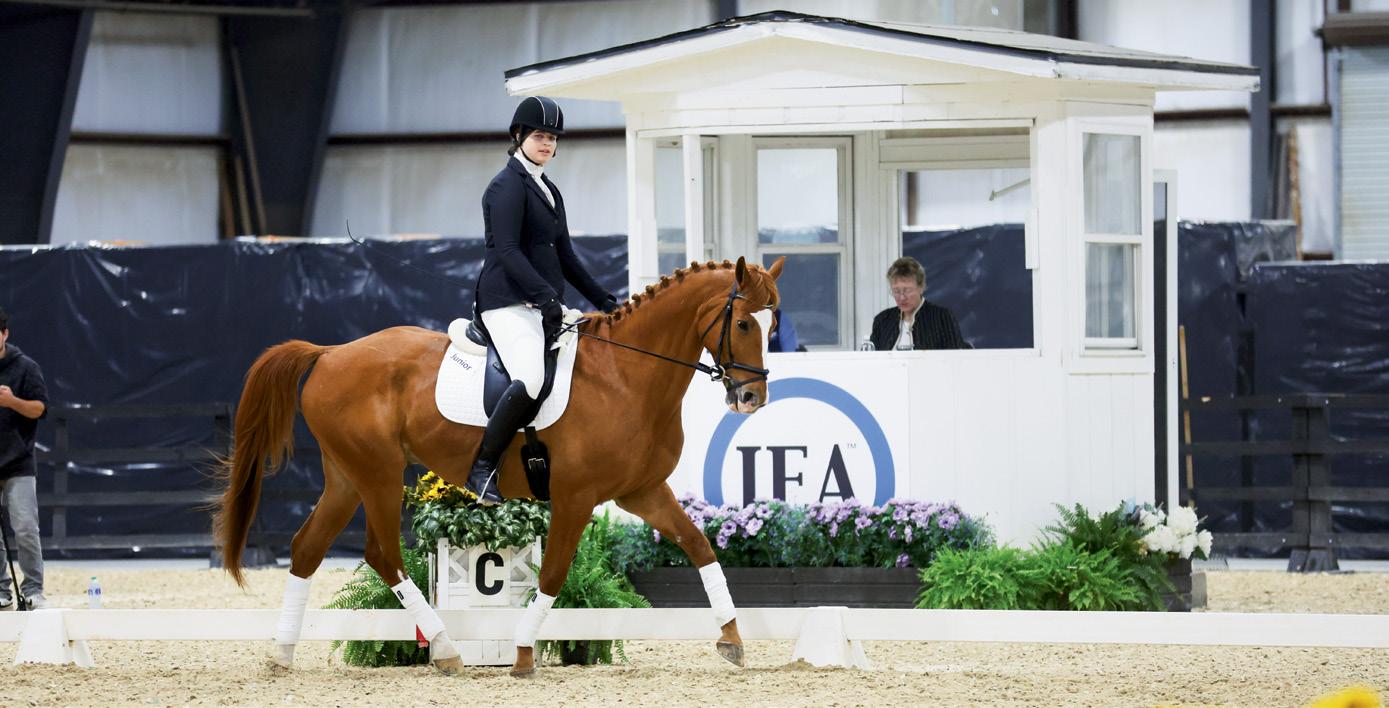
IEA dressage is for students in grades 4 through 12 who are involved in a dressage lesson plan but who don’t have the opportunity to compete. Participants do not need to own horses (most don’t); they just need to be taking lessons.
There are 11 regions in the IEA Dressage Zone. Each region’s coach forms three-rider teams in each of two grade/age groups, grades 4-8 and grades 9-12. There are three IEA dressage tests (Novice, Intermediate, and Open) and seven dressage-seat equitation (DSE) divisions, ranging from Beginner Walk/Trot to Varsity Open. The Novice test is roughly equivalent to USDF Introductory Level. Intermediate is similar to USEF Training Level. Open is comparable to USEF First Level. When riders go to IEA dressage shows, most compete in both dressage and DSE classes, one day as individuals and the other on teams.
Riders qualify for the IEA National Championships by earning points based on placings. Those who accumulate sufficient points advance to regional championships, then on to the Nationals. Horses, all tack, and
caretakers for the horses are provided by the host or home zone.
Here is the amazing part: These kids have only two minutes to ride the unfamiliar horses before going in to ride their tests or their DSE classes! The providers warm up the horses early in the day. At the Nationals I judged, the many horses varied based on the level of the competition or test being ridden.
As with Intercollegiate Dressage Association (IDA) competition, it is fascinating to see how differently the same horse goes for different riders. In one Intermediate class I judged, the same horse placed both first and last! It’s another testament to the old saying that “the rider forms the horse”—a formation that can happen in two minutes!
I have never seen such a wonderful group of horses. They occasionally expressed mild displeasure at a rider’s aids and were not always compliant, but there was not one instance of real disobedience; no rider was ever at risk of being unseated or even frightened.
Unhappy, maybe, with a wrong lead taken, but if you recognized it and corrected it, it was not held against you. By the end of the show, we no longer needed to write down a description of the horses in the DSE classes; my scribe and I knew them by name! There were so many wonderful equine souls.
This is an amazing program that gives kids the opportunity to be a part of a team. Even in the individual competition, riders’ teammates cheered them on. IEA dressage competition gives youth the chance to pursue personal goals and to experience the satisfaction that comes from consistent hard work leading to accomplishment. Kudos to the folks who dreamed this program up and who have worked tirelessly to make it a reality!
For more information about the IEA, visit RideIEA.org.

Time to say goodbye to a couple of horses—and my younger equestrian self

Horse-wise, the past 12 months have been a real adjustment period.
This time last summer, I was coming to grips with the realization that Junior, my dressage partner for eight years, was not going to be my next FEI horse after all. He had done really well at the lower levels, but it had become plain that advanced fancy prancing wasn’t in his cards.
So here I was again, effectively horseless, my last appearance in the FEI arena growing ever tinier in the rearview mirror. I really love this oddball of a horse, and I gave him everything I had—and I do mean everything—so giving up, or at least that’s what it felt like, was gut-wrenching.
Meanwhile, I started looking for another horse. I dislike horseshopping, especially when the rust starts to creep into my aids and timing, and to nibble away at my confidence, which is not robust to begin with. I ended up buying a horse that is fantastic in every way—except that I was a smidge out of my comfort zone while riding him. I chalked it up to rust and unfamiliarity—you know where this is going, I’m sure. Too late, I realized that it simply wasn’t the right match, and as I write this my talented, gorgeous horse is at a trainer’s to be sold, and I’m back in the same boat.
Never did I expect that I’d be
letting go of two horses in one year’s time. The circumstances were very different, although I see now that the reasons weren’t as far apart as they seemed at the time. Junior had been trying to tell me for a while that he wasn’t the horse for me any more, and I pushed past the signs until I couldn’t ignore them any longer. The new guy—well, he was never my horse to begin with, and I chose not to heed what my own gut was telling me. It is really, really hard to let go of a horse, even one you know isn’t right for you, when you’ve had some excellent rides and the horse nickers when he sees you and, most days, everything is sort of OK.
Letting go of Junior meant letting go of some dreams, at least for a while, and accepting the fact that the horse also deserves a say in its fate. As it turned out, another student of my instructor’s needed a lower-level schoolmaster but was cash-strapped. We struck a deal, and today she is thrilled with her big, beautiful horse who is teaching her so much. I saw the two of them
together a few weeks ago, and it was obvious: Junior is her horse now. I could have been wallpaper for all he cared. It was strange, and strangely wonderful.
Letting go of the new guy meant letting go of the notion that I am the same rider I was when I earned my USDF silver medal and thought that my gold was right around the corner. I have physical issues now that I didn’t then. I still have my equestrian skill set—in some ways, I’m a better rider now than I was then—but I struggle more with confidence issues and fear of getting hurt.
The result of all this is that I’m again looking for a horse, and I’m a little envious of our youth in dressage in this, USDF Connection’s youth issue, who probably haven’t yet tasted their own mortality. At the same time, I’m aware that the letting-go process is helping me to get comfortable in my current skin: as a rider who still has dreams and goals but who hopes this time around to find a horse that makes her feel as if she’s in exactly the right place, at the right time, in the saddle.
Jennifer O. Bryant, Editor MICHAEL BRYANT
MICHAEL BRYANT



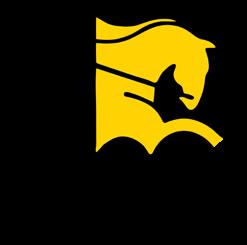





★ Pan Am Games Dressage Preview ★ McDonald Resigns as US Dressage Technical Advisor ★
★ USDF Wins Equine Media Awards ★ USEF to Require Microchips, Quiet Time for Horses ★
Lina Uzunhasan readies Furst
Fabelhaft UZN, a 2014 Rhinelander gelding owned by UZN Holding, for the horse inspection at the 2023 FEI Dressage Nations Cup Netherlands at the CHIO Rotterdam. Uzunhasan, 24, was born in the US and grew up in her parents’ native Turkey. She currently lives in the Netherlands.

Every four years, and held one year prior to the Olympic and Paralympic Games, the Pan American Games and Parapan American Games serve as a runup to—and sometimes a critical qualifier for—the following year’s Olympics and Paralympics.
The dressage competition is October 22-25. All equestrian events will be held at the Escuela de Equitación Regimiento Granaderos (Chilean army riding school) in Quillota.
Unlike the Olympics and World Championships, which are “Big
on October 25 for the individual medals.
Team USA dressage is in a fortunate position going in to Santiago because its international competitive future does not hinge on its performance there. As 2022 World Championships US dressage chef d’équipe George Williams told USDF Connection, our team’s sixth-place finish at Herning 2022 qualified the USA for the 2024 Paris Olympics (“Great Danes,” November/December 2022). Had our dressage team placed lower than sixth, the US would have had to win team gold or silver in Santiago in order to qualify for Paris.
A total of 42 countries in the Americas are invited to participate in this year’s Pan Ams. Mirroring the Olympics, the Pan Am Games equestrian program consists of dressage, eventing, and jumping. Although para-dressage is a Paralympic sport, it is not part of the 2023 Parapan Am program.

The 2023 Pan Ams will be held in Santiago, Chile, with the opening ceremony scheduled for October 20.
Tour” (Grand Prix level)-only competitions, Pan Am dressage is open to both Big Tour and Small Tour (Prix St. Georges and Intermediate I) combinations. In Santiago, the team medals will be decided by the results of the PSG and GP tests on October 22, followed by the I-I and GP Special tests on October 23. Those who advance to the individual final will ride either the I-I Freestyle or the GP Freestyle
On the US 2023 Pan Am Games dressage short list, announced July 20, were: Susie Dutta on Don Design DC, owned by Tim Dutta and the rider; Codi Harrison on her own Katholt’s Bossco; Charlotte Jorst on Kastel Denmark’s Zhaplin Langholt; Kevin Kohmann on Diamante Farms’ Duenensee; Anna Marek on Fire Fly, owned by Janet Simile; Christian Simonson on Son of a Lady, owned by Christina Morgan and Clifton Simonson; Christian Simonson on Christina Morgan’s Zeaball Diawind; Sarah Tubman on Summit Farm’s First Apple; and Jennifer Williams on Joppe K, owned by Joppe Partners LLC.
Learn more about the 2023 Pan Am Games at Santiago2023.org.
The United States ParaEquestrian Association (USPEA) was one of eight recipients of grants from the USA Equestrian Trust in 2023.
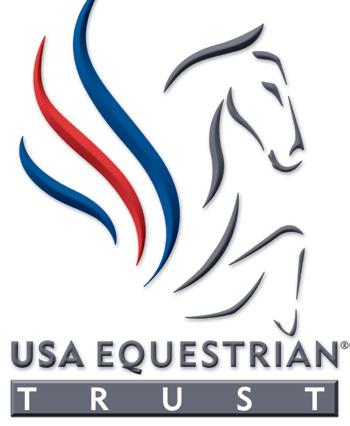
USPEA received $4,600 to create a
series of educational videos about the sport.
The USA Equestrian Trust is a private foundation based in Lexington, Kentucky, that annually awards grants to selected nonprofit organizations for the purposes of preserving or enhancing the quality of equestrian sport in the US.
Another 2023 recipient, the Retired Racehorse Project, received
a grant of $7,500 to support its annual off-the-track Thoroughbred retraining competition and educational event, the Thoroughbred Makeover and National Symposium. For more about the Thoroughbred Makeover, see “Sport Horse” on page 18 of this issue.
Learn more about the USA Equestrian Trust grants at trusthorses.org.
Rehired only since February, US national dressage advisor Debbie McDonald resigned her position effective August 1.
The two-time Olympian, 69, called her decision “difficult” and said that she had decided to step down to spend more time with her family, according to the July 12 US Equestrian (USEF) announcement.
McDonald served as technical advisor from 2019 through 2021— during which time the US dressage team won a silver medal at the 2020 Tokyo Olympics—and previously was the US dressage national development coach, from 2009 through 2019.
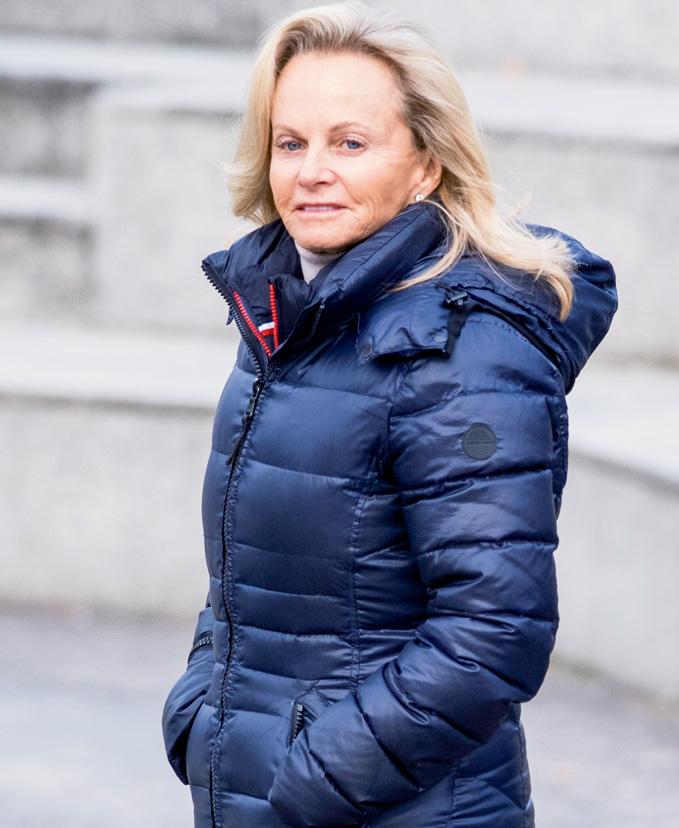
USEF chose not to renew McDonald’s contract in 2022, then reinstated her early in 2023. Although USEF had announced that her contract would run through the 2024 Paris Olympics, McDonald told The Chronicle of the Horse in a July 14 interview that “I never was going to stay through Paris anyway.”
USEF has begun searching for a new technical advisor to lead the US dressage team through the 2028 Los Angeles Olympics. The organization hopes to have McDonald’s replacement in place by December 1, according to USEF director of FEI sport Hallye Griffin. An interim dressage chef d’équipe will be appointed for the 2023 Pan American Games in Chile this October.
“It’s been an honor to work with the US dressage program over the past 15-plus years, both as a coach and technical advisor,” McDonald said in the press release announcing her resignation. “I wish nothing but success for the program and will still be involved with coaching on a limited basis. I look forward to seeing our athletes continue to succeed on the world stage.”
Kristi Bloom of Minnesota is the 2023 recipient of The Dressage Foundation’s (TDF) Jane Savoie Fund for Adult Amateurs grant. Bloom will receive $4,600 to train with Heather Salden Kurtz and Emily Miles.
Bloom has ridden dressage most of her adult life but didn’t start competing until she was 60. She hopes to earn her USDF silver medal with her horse, Jjaguar B, within the next year.
“This grant lifts a financial burden off my shoulders at a time where I need the support,” Bloom said, “as I am back in the saddle after a challenging year of health issues.”
The Jane Savoie Fund was established in 2021 in memory of the late dressage trainer and competitor’s contributions as a teacher, author, motivational speaker, and champion of adult amateurs. To be eligible, a rider must be training any breed of horse at Fourth Level or Prix St. Georges, and
should reflect Savoie’s ethos of developing each horse to its potential.
Rebekah Mingari-Stought of Ohio has received a $5,000 grant from TDF’s George Williams Young Professional Fund. This fund was established by friends and supporters of international competitor, USDF president, and US national dressage
youth coach George Williams. It provides funding to instructors and trainers aged 25-35 who have a strong desire to participate in continuing-education opportunities to provide higher-quality instruction to their students.
Mingari-Stought, 27, is a member of the Mid-Ohio Dressage Association and was the 2015 USDF Youth Volunteer of the Year. She was a working student for Kentucky-based dressage pro Angela Jackson and later became the head trainer at Timbach Farm in Indiana. Mingari-Stought took part in the USDF/USEF Young Rider Graduate Program and in TDF’s Young Rider Dream Program. She plans to use the funds to train with Anne Gribbons in Florida and to begin the process of earning USDF instructor/ trainer certification through First Level.
Learn more about all of TDF’s funds and contribution opportunities at DressageFoundation.org.

As reported on TheHorse.com, an Australian study published in the Journal of Equine Veterinary Science showed that not feeding hay before a long trailer ride increases the likelihood that a horse will develop gastric ulcers during transport.
In the study of 26 healthy horses, 14 developed moderate to severe squamous ulcers during a 12-hour trip. Horses that had been fasted prior to transport had the highest rate of ulceration, both squamous and glandular. Lower incidence of ulcers was associated with feeding hay before travel. The take-home message: Keep hay in front of your horse before and during transport, especially over longer distances.
Kimberly Snyder, DVM, PA, has been appointed the new team veterinarian for the Perrigo US paradressage team for the 2023-2024 competition season, US Equestrian (USEF) announced in July.

The position had been open since the death of former paradressage team vet Margaret Mullin, VMD, in March after a riding accident (“Collection,” July/August).

Snyder is based in Wellington, Florida, where she has had her own equine practice since 2011. She was previously an associate veterinarian at Palm Beach Equine Clinic in Wellington. She has served as an FEI veterinary delegate for jumping and dressage since 2007 and was a member of the FEI Veterinary Committee at the 2022 FEI World Championships in Denmark. Snyder was president of the Veterinary Committee for the Adequan® Global Dressage Festival in 2019 and 2020, and she was on the veterinary
surgical team at the 2019 Pan American Games in Lima, Peru.
“I hope to emulate my friend Dr. Meg Mullin in the performance of my duties,” said Snyder. “I am excited to collaborate with US paradressage and greatly appreciate the opportunity.”
National Public Radio (NPR) is an eclectic mix of subject matter, but dressage doesn’t crop up too often. This spring, however, NPR Illinois featured dressage pros Martin Kuhn and Kate Fleming-Kuhn on its “Community Voices” program.
In the April 19 segment, the husband-and-wife team, who operate the dressage training facility StarWest in New Berlin, Illinois, discussed “what it takes to compete in dressage, and the training required of horses and their owners,” according to the promo on the WUIS 91.9 FM website.
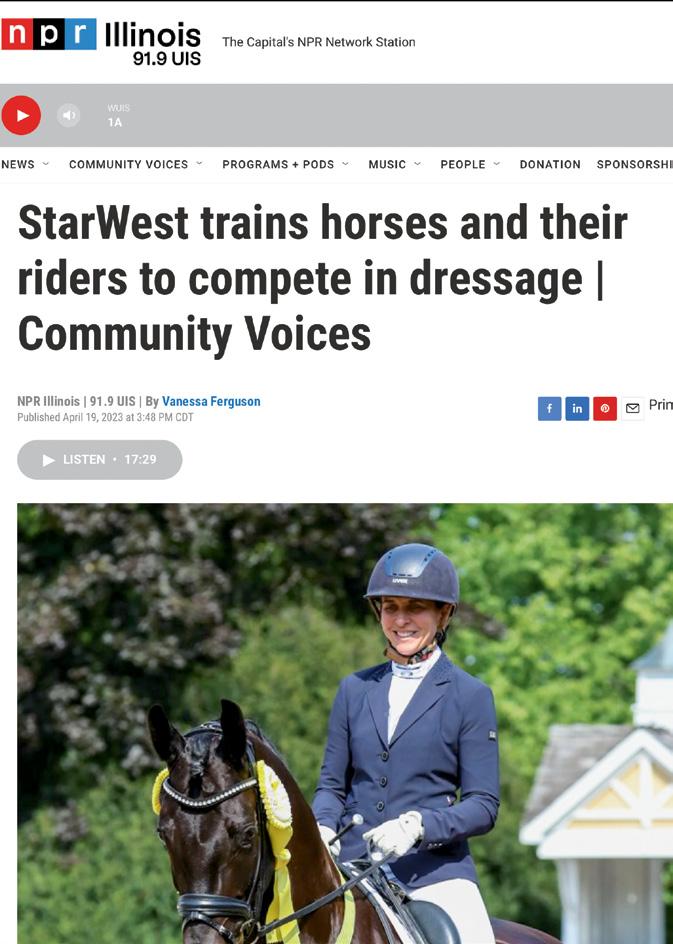
Fleming-Kuhn is a faculty member of the USDF Instructor/ Trainer Development Program. Both she and her husband are wellknown FEI-level competitors, with wins at the US Dressage Finals and other prestigious competitions.
Listen to the segment at nprillinois.org/communityvoices/2023-04-19/starwest-trainshorses-and-their-riders-to-competein-dressage-community-voices.
The US Equestrian Federation (USEF) passed a slew of rule changes at its mid-year board meeting in June. Most will take effect December 1, 2023, for the 2024 competition year.
Two rule changes of note:
Microchipping to become mandatory. Beginning December 1, 2025, all horses competing in USEFlicensed or -endorsed competitions must be microchipped with a 15-digit ISO-compliant 11784/11785 chip. The USEF enacted this rule because “the microchipping of horses is fundamental to equine well-being, especially during times of disease outbreaks, natural disasters, in cases of theft, and to protect against fraud.”
To learn more about microchipping, see “Sport Horse: The New Equine-ID System,” November/December 2020.
Lights out in show stabling. Another USEF rule change enacted “in the interest of health and the well-being of the horse” requires “minimal lighting and noise” at licensed competitions “for a minimum of six consecutive hours overnight…to assist in allowing horses adequate rest and REM sleep, which are necessary to avoid undue stress and impaired performance.”

The American Horse Council (AHC), the US national equineindustry advocacy organization, is conducting its 2023 National Equine Economic Impact Study. The study opened in April and runs through September 29.

The study currently comprises
two surveys: one for horse owners and another for owners of equinerelated businesses. A later survey will target competition organizers. All responses are anonymous.
According to the AHC, the purpose of the study is to demonstrate the value of the equine industry in national and state economies by analyzing the direct, indirect, and induced economic impacts of horse ownership, recreation, and equine-related services. Data collected will inform public and private investments in equine-related
businesses, equine health care, education, land-use decisions, tax policy, tourism, employment incentives, and more.
To encourage participation, AHC sponsors are offering 15 prizes to survey respondents, including a John Deere Z545R ZTrak mower and a year’s supply of Nutrena and Purina horse feeds. All respondents who complete a survey will receive a discount code for 15% off purchases at HorseAndRiderBooks.com.
Find the surveys at horsecouncil. org/economic-impact-study.
Awards Deadlines and Reminders
Yearbook-photograph submissions deadlines:
October 6 (rider awards)
October 27 (year-end awards; first place only). For submission instructions, see the USDF Photograph Release Form and Guidelines (download at usdf.org/docs/ awards/photoreleaseform.pdf).
Year-end awards deadline:
September 30 is the deadline for:
• Submitting birthdates for Vintage Cup, adult amateur, and junior/young rider awards
• Filing Vintage Cup status and verifying adult-amateur status
• Joining USDF for Breeder of the Year awards
• Submitting online Rider Performance Award applications
• Submitting online Horse Performance Certificate applications.
Check your scores at USDFScores.com. Contact USDF at scorecorrections@usdf.org or at (859) 971-2277 if you notice an error. The 2023 competition year ends September 30. All corrections must be reported by October 15 at 5:00 p.m. ET.
Take the Regional Championships Competitor Survey
USDF wants to hear from you! Please complete the electronic evaluation form that will be e-mailed to competitors following each Great American/USDF Regional Championships competition.
USDF congratulates the following members, who earned US Pony Clubs (USPC) national-level certification in 2022:
A Genevieve Munson, Rogers, AR
H Rio Mowbray, Shoreline, WA
B Amanda Fisher, Greer, SC
B Kaylee Van Winkle, South Lebanon, OH
C-3 Danielle Doughty, Tallahassee, FL
C-3 Sara Miller, Greenville, SC
C-3 Heidi Steeneck, Lehi, UT.
And congratulations to the following USDF members, who earned USPC dressage specialty ratings in 2022:
H-A Allison Icenogle, Readstown, WI
H-A Erin Icenogle, Readstown, WI
H-HM Christine Brown, Anaheim, CA.
Declare and Nominate
Hoping to compete at the 2023 US Dressage Finals presented by Adequan®? Horse/rider combinations must declare their intention to participate by filing a Declaration of Intent form.
The deadline to declare is midnight the day prior to the first day of your Great American/USDF Regional Championships competition (including any day of open competition before the start of championship classes). You must declare at the level(s) and eligible division(s) in which you intend to compete. There is no fee to declare. Find the declaration form at usdressagefinals.com/ declare.
In addition, nomination (preliminary entry) is required for participation in US Dressage Finals classes. The nomination deadline is midnight, 96 hours after the last day of your Regional Championship. Find the nomination form at usdressagefinals.com/nominate.
See usdressagefinals.com for the prize list and other information.

US Dressage Finals competitors who reside in one of the applicable states (WA, OR, CA, HI, AK, MT, ID, AZ, NV, UT, WY, NM, or CO) are eligible to apply for a travel grant. A rider may apply for a grant with each eligible horse entered. To be considered for a grant, you must submit a grant request with your Finals entry by checking the grant-request box. See the prize list for more program details.
The popular high-score breed awards will again be offered at the 2023 US Dressage Finals presented by Adequan®. Participating breed and performance registries will award two high-score awards in both the adult-amateur and open divisions: one award for the national levels (Training through Fourth combined) and one for the FEI levels (Prix St. Georges through Grand Prix combined). There will be one high-score award in the junior/young rider division, for the national levels (Training through Fourth combined).
To be eligible, register your horse for the awards when you enter the Finals. Learn more at usdressagefinals.com.
Material published in USDF Connection and on USDF’s YourDressage.org website won numerous honors in the 2023 American Horse Publications (AHP) Equine Media Awards contest, for material published in 2022.
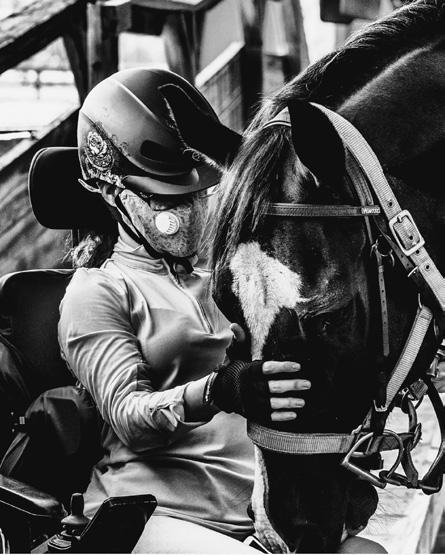

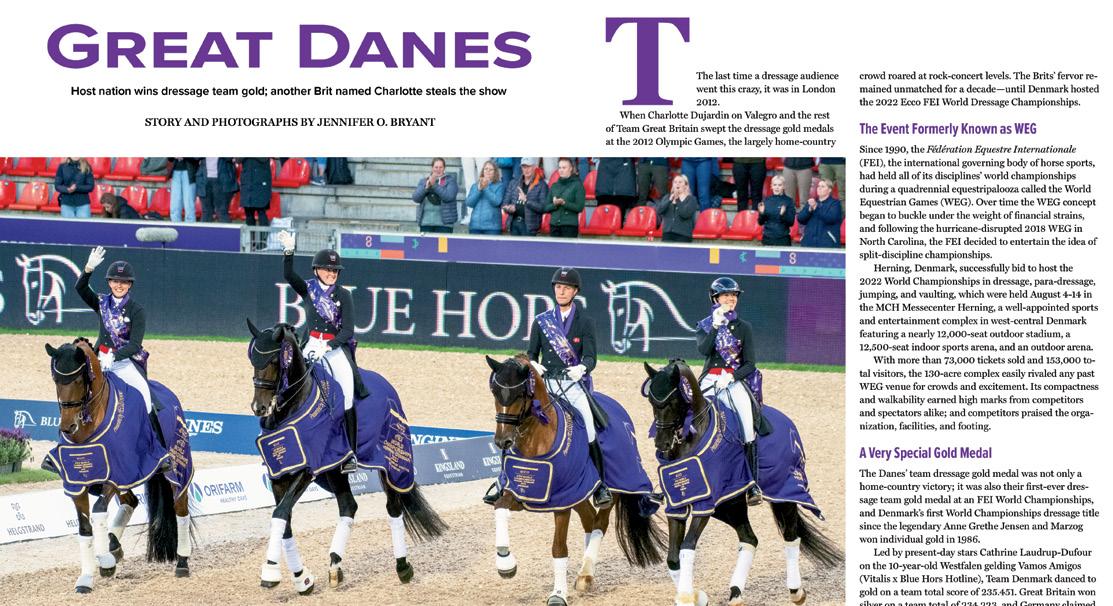
USDF Connection
First place: Association Equine Media Horse Care Single Article for “New Hope for Laminitis” by Kara L. Stewart, July/August 2022
Second place: Editorial Event Coverage Single Article for “Great Danes” by Jennifer O. Bryant, writer and photographer, November/
December 2022
Second place: Equestrian Lifestyle Journalism for “Dressage Paraiso” by L.A. Sokolowski, July/ August 2022
Third place: Association Equine Media Personality Profile Single Issue for “The Game-Changer” by Kelly Vencill Sanchez, July/August 2022 YourDressage.org


Second place: Editorial HumanAnimal Bond Photograph for “They Say to Never Give up on the Thing You Can’t Live Without; for Me, That Thing Is the Horse,” courtesy of Bryanna Tanase and published in “Persevering
to Pursue Paralympic Dreams”
Second place: Editorial Series for “World Championships 2022” by Jennifer O. Bryant, writer and photographer
Honorable mention: Editorial Photograph (print or online) for “Favory Aurelia and Bill Clements” by John Borys Photography, published in “A Day in the Life of the Tempel Lipizzans.”

Awards were presented at the 2023 AHP Equine Media Conference in Tempe, Arizona, in June. AHP is the US professional organization for equine-related media.



Council Open Forums
USEF/USDF Open Forum
US Dressage Finals Open Forum
Region Meetings
Competition Open Forum
Group Member Organizations Committee
Roundtable Discussions
Board of Governors (BOG) General Assembly
Featured Education
Competition Management Education Session
Salute Gala and Annual Awards Banquet
Registration
The deadline to receive the advance registration member discount is November 22, 2023.
Convention Members: $195 ($235 onsite)
Non-Members: $215 ($260 onsite)
Youth (21 and under): $90
Salute Gala & Annual Awards
Banquet Ticket
$120 ($145 onsite)
USDF Apprentice Dressage Technical Delegate Clinic
(Ticketed event. Must be purchased by November 21, 2023)
$175 (If registered by November 8, 2023)
$350 (Registration November 9 – 21, 2023)
Visit
Visit
From festivals, sporting events and live music to art shows, stage productions and special exhibits, you’ll find a variety of events to enjoy while you’re in Omaha.


Cirque du Soleil will be performing “Corteo” November 30 through December 3, at the CHI Health Center Omaha, which is conveniently connected to the Hilton Omaha by a sky bridge. Visit www.cirquedusoleil.com/corteo for information about the show and to purchase tickets.

USEF/USDF Dressage Technical Delegate Clinic
(Ticketed event. Must be purchased by November 21, 2023)
$225 (If registered by November 8, 2023)
$450 (Registration November 9 – 21, 2023)
‘Take a Stake in Dressage’ and join us in Omaha, Nebraska for the 2023 Adequan®/USDF Annual Convention. As devoted members of USDF and attendees of our convention, take control and do your part through active roles in USDF governance, and plot its trajectory going forward. We hope to see you there!
Register

Dressage features prominently in the Thoroughbred Makeover competition, which showcases ex-racehorses trained for second careers
By Kara L. StewartForward. Straight. Fast. These three words sum up the Thoroughbred racehorse’s training for the track. But just because these are the qualities honed for their initial career doesn’t mean that the off-track Thoroughbred (OTTB) is a one-trick pony.

Indeed, many OTTBs transition successfully from racing to dressage, among many other disciplines. And nowhere is the breed’s versatility more evident than in the Thoroughbred Makeover program.
work with ex-racers who still have so much to give. In this article, we’ll explain the Makeover process, and we’ll hear from two past Makeover dressage competitors, who share their journeys and advice.
The Makeover Explained
Thoroughbred Makeover entrants may compete in up to two of the 10 divisions offered: barrel racing, competitive trail, dressage (traditional dressage and Western dressage are judged in the same division),
retraining prior to the competition.
(A new division for 2023, Former Broodmare, is for Thoroughbred mares that recently retired from their broodmare duties. These entrants will compete separately under different rules.)
Dressage is a popular Makeover division, drawing more than 20% of entries since 2019.
From its humble beginnings featuring 23 horses a decade ago, the event has grown significantly. More than 500 trainers and horses have been accepted to the 2023 Thoroughbred Makeover and National Symposium, presented by Thoroughbred Charities of America. This year’s event takes place October 11-14 at the Kentucky Horse Park in Lexington, and will award more than $100,000 in total prize money.
Created in 2013 by the Marylandbased nonprofit organization The Retired Racehorse Project (RRP), the Thoroughbred Makeover, an annual national competition, showcases the OTTB’s trainability and talent. The competition “is intended to inspire good trainers to become involved in transitioning former racehorses to second careers,” explains RRP executive director Kirsten Green.
Those who have competed in the Makeover say that it’s rewarding to
eventing, field hunter, polo, ranch work, show hunter, show jumper, and freestyle (a free-form discipline to demonstrate skills of the trainer’s choice). A winner is named in each discipline, and judges then select an overall winner. That horse is crowned the Thoroughbred Makeover champion.
To be eligible, a Thoroughbred must have raced or trained to race within the past two years and must have no more than 10 months of
The Thoroughbred Makeover is open to juniors, amateurs, professional trainers, and teams, who compete toe-to-toe. Case in point: The 2022 Thoroughbred Makeover champion, the 2018 Kentucky-bred mare She’s a Bold One (Midshipman – Bold Contender, Strong Contender), was trained by 17-year-old Jenna Denver. Denver, of Imlay City, Michigan, was the second junior in the event’s history to win the Makeover’s top honor. Denver and She’s a Bold One also claimed the eventingdivision Makeover championship title and placed second in the dressage division.
Professional dressage, Western dressage, and eventing trainer Holly Zecchin, of Metamora, Michigan, competed two of her clients’ horses in the 2018 and 2019 Makeovers in the dressage and field-hunter divisions.
Zecchin, the current president of the Midwest Dressage Association, a USDF group-member organization (GMO), has made a name for herself as having a knack for identifying promising OTTBs.
After a few years away from the Makeover scene, Zecchin decided to seek out a prospect of her own for the 2022 event.

“I’d adopted an OTTB from New Vocations [a national racehorseadoption program] in 2013 and really wanted to find a horse from them to train for the 2022 Makeover in the Western-dressage division,” she says.
Adult-amateur dressage rider and USDF member Kelly Sulik, DVM, says that “entering the Thoroughbred Makeover had been on my bucket list for many years.” A small-animal veterinarian in Tryon, North Carolina, who has been riding dressage since childhood, Sulik had been accepted to compete at the 2020 Makeover with two horses, but both suffered lameness issues before the competition and had to be withdrawn.
“I knew I wanted to enter again, so I focused my sights on the 2022 Makeover,” Sulik says. She thought that her solid dressage foundation, combined with her years of experience with nearly every breed and equestrian discipline, would make her a strong candidate—if she could find the right horse.

Zecchin “started checking out the adoptable horses online” as soon as
she got the nod from New Vocations. Buckeye Warrior, a 2016 Ohio-bred gelding (Majestic Warrior – Hap Cat, Van Nistelrooy), caught her eye: “His conformation screamed Western dressage, and he had such a kind eye. I was hooked immediately.”
However, Buckeye Warrior was recovering from a stress fracture in his tibia. Despite a veterinarian’s reassurance that a full recovery was likely, Zecchin decided to pass on the horse. But “something kept bring-
ing me back to ‘Buckeye,’ though. Despite my initial reservations, I contacted New Vocations and made arrangements to pick him up on November 27, 2021.”
“I started looking for a horse and put out feelers with the adoption organizations,” says Sulik. “Thoroughbred Athletes Inc. [an Oklahomabased OTTB adoption organization] contacted me about Bokeelia Island, a bay gelding that had been a successful stakes winner. We agreed that
ance,” the rider says. “We waited until March to try the canter, and by then he was able to canter large circles on both leads without swapping leads with his hind end or falling into the trot.”
In May, Zecchin began taking Buckeye to local schooling shows. “I thought that if we could do one schooling show each month, he’d be well prepared for Kentucky in October,” she says. In fact, the ex-racer did so well that Zecchin decided to enter him in the Western Dressage Association of America (WDAA) World Show, explaining, “I thought competing at a big venue in late September would improve Buckeye’s chances at the Makeover in October.”
I’d work with him for the Makeover and then help the rescue adopt him out after the event,” she says of the 2012 Kentucky-bred (Medaglia d’Oro – Matlacha Pass, Seeking the Gold). “However, it wasn’t long before ‘Bo’ claimed me as his person. He’s a special one, for sure.”
Recalling the challenges of trying to prepare two horses for vastly different Makeover divisions, Zecchin decided to keep it simple for 2022, entering only the dressage division as
a Western dressage pair.
After Buckeye arrived at Zecchin’s farm, he “spent December just hanging out, turned out every day with a friend,” Zecchin recalls. “In January, I started lungeing him at the walk and trot three times a week to confirm he was sound. After three weeks, I planned to add a circle or two of canter.”
But Buckeye struggled to canter on the lunge, so “I began riding him instead, letting him figure out the bitless bridle and exploring walking and jogging figure-eights with some bal-

The 2023 Thoroughbred Makeover and National Symposium will be held October 11-14 at the Kentucky Horse Park in Lexington. All events are open and free to the public, including educational seminars and panel discussions dedicated to the care and retraining of off-track Thoroughbreds. Seminars and the October 14 Makeover Finale event will be livestreamed, as well.
Find the schedule of events and other information at the Retired Racehorse Project’s website, TheRRP.org.
Buckeye’s performance at the WDAA Worlds exceeded her expectations: He won both the WDAA Basic Test 3 Open Championship and the Basic Open Division Championship.
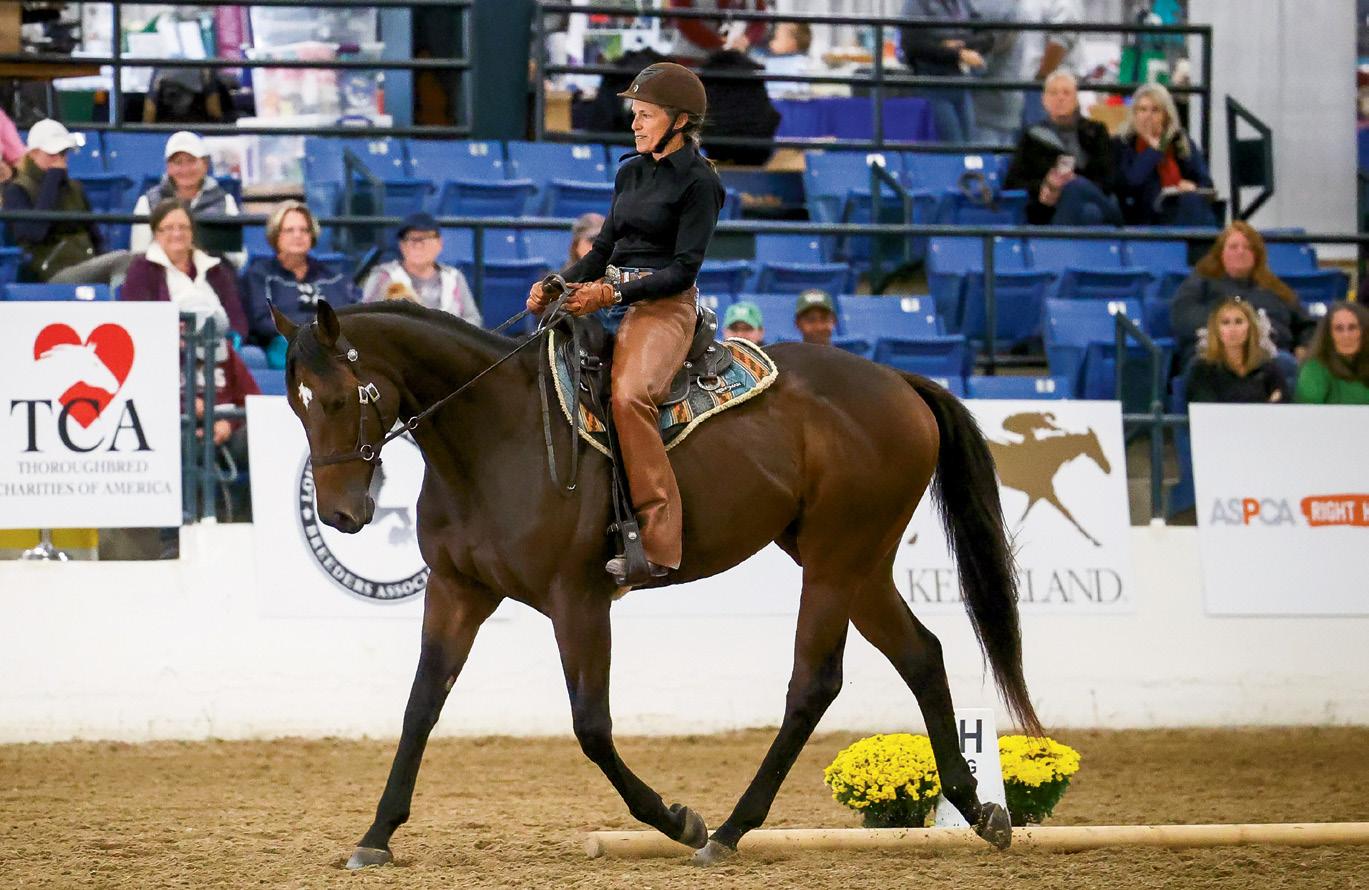
Bokeelia Island’s initial retraining got off to a rockier start. Soon after he arrived in North Carolina in early 2022, Sulik realized that that something was off.
“Bo was stiff and carried his head high, which isn’t uncommon in an OTTB,” she says, “but there was something deeper to it.”
Doing basic ground work with Bo, Sulik realized that the horse struggled with balance and “also didn’t trust himself to stay in balance in motion. Because of that, we started at the very beginning—at a standstill—helping him learn to bend, flex, and release. The biggest result was helping him learn to trust that he was safe in the movement and in his body.”
After several weeks of slow and progressive ground work, Bo learned to bend, lower his head, and relax, first at a halt, then while walking and trotting in hand. “With every step, we focused on being in balance and relaxed,” Sulik says.
Eventually, Bo learned to trust his balance, and it was time to ride.
“When I got on him the first time, we were in the round pen,”
IN BALANCE: Adult-amateur dressage rider Dr. Kelly Sulik and Bokeelia Island at the 2022 Thoroughbred Makeover


Sulik recalls. “There was all sorts of commotion and distraction around him—cars going by, and even a cat crawling around in the tree that hung over the round pen above his head! And yet he was super quiet and took it all in stride.”
At the end of the ride, as Sulik dismounted and stood in the round pen with him, “I felt like Bo was asking me to take a selfie of us. It was like he wanted me to remember the moment he claimed me as his person.”
“In the early stages of training a horse, and especially an OTTB that has been using his body in a completely different way, introducing the foundations of classical dressage is like physical therapy,” says Sulik. “By teaching them to bend and flex, first at the poll and in the jaw, then stretching down, it helps them learn to use their bodies in different ways. Once they start to feel the reward in their body and learn that stretching feels good, they start to seek that by themselves.”
For Zecchin, dressage was also a way to help evaluate Buckeye’s soundness.
“Because of Buckeye’s history and injury, I was concerned about his soundness under the stress of regular training,” she explains. “Focusing on rhythm and relaxation, and always riding him in balance, gave me confidence that he really was 100% sound.”
Dressage competitors at the Makeover perform a dressage test and a demonstration ride. First comes the
test—for the 2022 Makeover, US Equestrian Training Level Test 2 or WDAA Basic Test 1. Next, competitors perform their self-designed five-minute demonstration rides, which (as in dressage freestyle) are an opportunity to highlight horses’ strengths. On the last day of the Makeover, the top five finalists in all divisions perform a demonstration in the Finale, which can be set to music.
Zecchin “put a lot of thought into choreographing Buckeye’s demon-
The Makeover veterans we interviewed for this article says that many ex-racing Thoroughbreds make excellent dressage mounts.
“I love the Thoroughbred work ethic and their sensitivity,” says 2022 Makeover dressage winner Holly Zecchin. “I’ve found that Thoroughbreds have natural impulsion that’s critical for dressage, and they’re sensitive to riders’ subtle cues. The trick is channeling those two traits into the athletic frame with the balance that results in desirable performance. Of course, riders have to focus on guiding and motivating through positive means, because being adversarial with a Thoroughbred never works.”
RACING TO SUCCESS: 2022 Thoroughbred Makeover dressage champions Buckeye Warrior and Holly Zecchin
Adult-amateur dressage competitor Holly Sulik, DVM, says that OTTBs are “intelligent, very athletic, easy to train, and they thrive when they have a job to do.” She adds that most are “great travelers because they’ve been taken so many places during their racing days.”
What about the stereotype of the OTTB as a super-hot horse? “Some are,” says Sulik, “but I have found that if they are going to truly act silly, it usually only lasts about 15 minutes; then I am able to get their attention and channel that energy into something productive.”
As part of its Thoroughbred Incentive Program, The Jockey Club, the US Thoroughbred registry, offers Adequan®/USDF All-Breeds awards and also sponsors high-score breed awards at the US Dressage Finals. Learn more at tjctip.com/About/USDF and at usdf.org/awards/all-breeds.
Ready to look for an ex-racer of your own? Many organizations work to support the mission of placing OTTBs in new homes and careers. A few of the best known:
Communication Alliance to Network Thoroughbred Ex-Racehorses (CANTER): CANTERUSA.org
Retired Racehorse Project: TheRRP.org
Thoroughbred Aftercare Alliance: ThoroughbredAftercare.org
Thoroughbred Charities of America: tca.org.
ronment. Just being there with Bo at the Kentucky Horse Park, Sulik says, made her feel like a winner.
Happily, both pairs achieved superb results. Zecchin and Buckeye won the 2022 dressage division championship, earning a score of 76.731% for their Western dressage test. Sulik and Bo were fourth in dressage, with a score of 76.379% at Training Level Test 2.
At the competition, “You’re surrounded by hundreds of other trainers who understand the dedication and hard work it took to get there,” says Sulik. And “seeing the huge positive effect on the Thoroughbred industry is so uplifting.”
ence at the Makeover, the horse’s physical attributes aren’t as important as their trainability and calm confidence.”
Your OTTB may have handled the atmosphere at the country’s biggest racetracks, but he still needs to learn how to go to a horse show.
“Take your Makeover prospect to as many locations for practice and competition as possible,” Zecchin advises. “It will strengthen your bond with your partner and help you develop a plan for handling their special emotional needs in new situations.”
stration ride to emphasize his lovely, cadenced gaits and suppleness.” Sulik says that “Bo has a beautiful trot and elegant lateral movement, so I designed his demonstration ride to showcase this with shoulder-in and leg-yield segments.”
Zecchin and Sulik describe the Thoroughbred Makeover as a supportive and encouraging competition envi-
Want to try your hand at retraining a retired racehorse?
Pick up a copy of the awardwinning book Beyond the Track: Retraining the Thoroughbred from Racehorse to Riding Horse, by Anna Morgan Ford with Amber Heintzberger. Ford, the Thoroughbred program director at New Vocations Racehorse Adoption Program, has experience with both ex-racing Thoroughbreds and Standardbreds.

We asked our Thoroughbred Makeover veterans what advice they’d give USDF members who are interested in giving the competition a try.
“One of my biggest tips is to take the time to understand your horse before you really start training,” says Sulik. “Another is to remember that the road to the Makeover is a process, not a destination. It’s likely things won’t go how you plan, like how Bo needed to start from a literal standstill in our early training.”
Yet to be successful, entrants have to produce results in a finite amount of time.
“You only have 10 months, so every day counts,” Sulik says, “but there’s a bit of a Catch-22: You have to be focused on your training with the goal of the Makeover, but at the same time not be worried about the limited time frame. Just go with the flow, and work with what comes up.”
“If you’re considering doing the Makeover, I urge you to read the rules,” Zecchin says. “Really study your intended division rules, including the score sheets, and consider what will be asked of you and your horse.”
The horse’s temperament is key to success, says Zecchin. “In my experi-
If you’re looking for an opportunity to grow with a new equine partner while together developing a solid dressage foundation, entering the Thoroughbred Makeover may be the perfect future focus point.
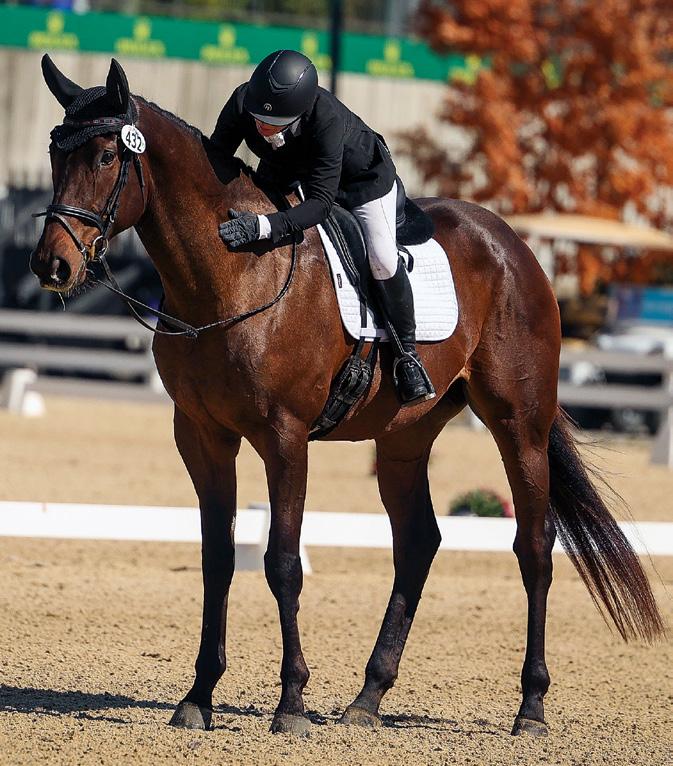
“Committing to entering the Makeover reminded me a bit of vet school,” Sulik says with a laugh. “It will be your life for the next ten months! Dive in and enjoy the process. You’ll be glad you did it.”
According to the RRP’s Green, the Makeover “has become an integral part of the aftercare industry, driving demand for Thoroughbreds who are completing their racing careers and offering participants the community and support needed to ensure they’re successful with their horses.”
And even if you don’t end up competing in the Makeover, or if you don’t come away with a top placing? You’ll still end up with the best reward of all: a great horse and partner.
Support the US Dressage Finals by making a tax deductible gift. Patron gifts will be recognized in the event program*, the yearbook issue of USDF Connection , and receive a commemorative gift of appreciation.
Patron levels of giving are:
• Platinum $2,500+
• Gold $1,000 - $2,499
• Silver $500 - $999
• Bronze $250 - $499
*Gifts received by October 4, 2023 will be recognized in the event program.
To make your contribution please visit USDF’s secure online giving site at w w w.usdressagefinals.com
For more information please contact us at donate@usdf.org
• Friend $100 - 249 or (859)971-2277
Top trainer Scott Hassler explains how he influences the horse in order to create a seamless, harmonious partnership
By Beth BaumertScott Hassler has had a lifetime of success in the sport of dressage. He began by winning a team bronze medal at the 1985 FEI North American Young Riders Championships (now NAYC), then came to national prominence during 15 years as head trainer at the sporthorse breeding and training facility Hilltop Farm in Maryland. During his time at Hilltop, Hassler became a leading authority on sport-horse
horse breeding competition and the Young Horse ranks.
The mid-2000s were a turning point for Hassler. In 2005 he was named the inaugural US Equestrian national dressage young-horse coach, a position he held until 2015. In 2006 he left Hilltop to establish Hassler Dressage at Riveredge, Chesapeake City, Maryland, with his then wife, Susanne Hassler.
his training secrets to USDF Connection readers. He was happy to oblige, as dressage is his passion. I met up with Scott in Wellington, Florida, and we had a great conversation about training.
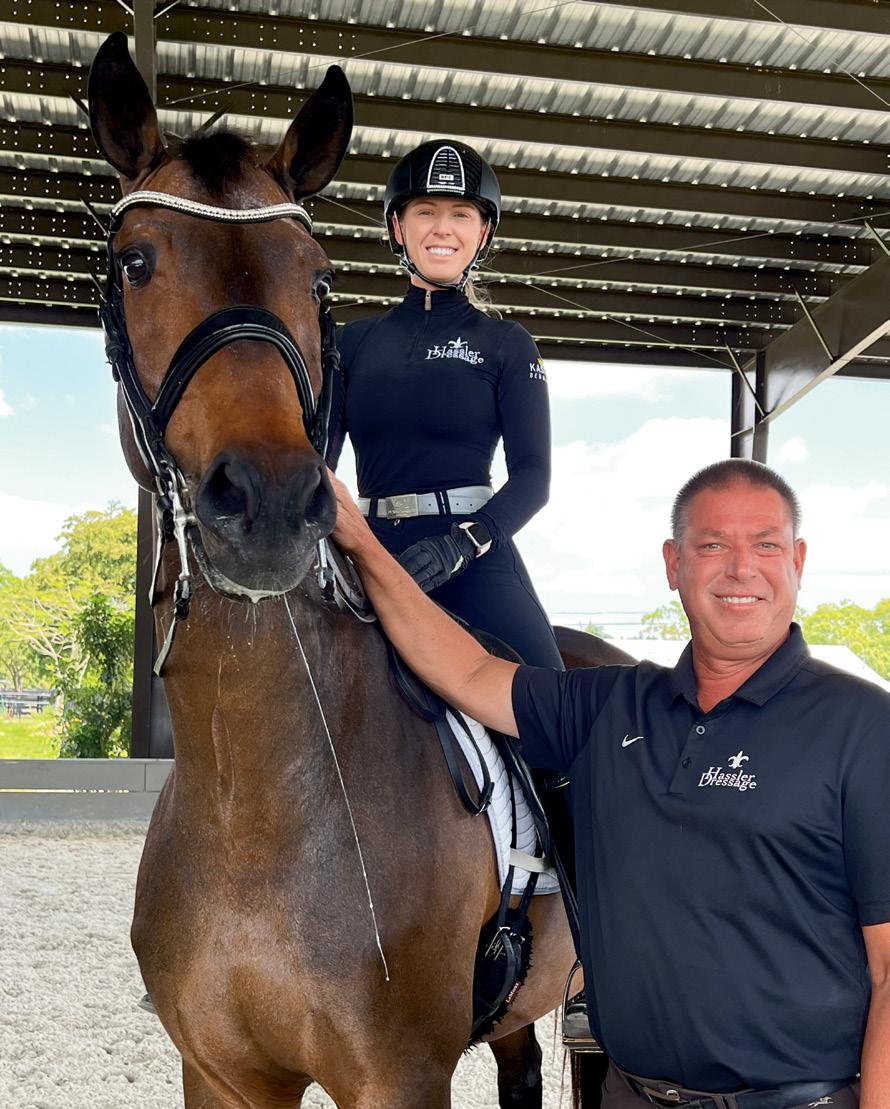
Beth Baumert: Can you tell us about an aspect of your training that has made you so successful?
breeding and served as a member or chair of the USDF Sport Horse Committee. He was instrumental in helping to establish the USDF Sport Horse Prospect Development Forum as a bridge between in-hand sport-
Today Hassler Dressage is based year-round in Wellington, Florida, with Scott Hassler serving as cohead trainer alongside his daughter Sara Hassler. In recent years he has become increasingly involved in training and coaching top-level riders as well as horses, with students including 2019 Pan American Games dressage individual gold medalist Sarah Lockman (now Tubman). He has coached Sara Hassler to wins including the 2020 USEF Under 25 Grand Prix “Brentina Cup” Championship, and many combinations he has coached have qualified to compete at the US Dressage Festival of Champions. He has also coached US eventing Olympians Phillip Dutton and Boyd Martin in dressage.
I’ve been watching Scott Hassler teach for many years now, and his lessons are always exceptionally thoughtful and “on the mark.” So I hoped he would be willing to divulge some of
Scott Hassler: For me, the numberone thing is the constant effort to understand the horse in front of me. I always want to be the best I can be and keep learning, and the key is understanding the horse. I want to be able to diagnose what’s going on. What is the horse feeling? Why is he struggling? Why is the rider feeling what she’s feeling? There’s always a reason, and too often riders jump to the conclusion that the horse is “resisting.” He might be stuck, or leaning, or his reactions may be delayed, but those things aren’t resistance. To me, it is resistance only when the horse has a negative answer to an aid—when the horse is saying no instead of “I’m trying.”
When a horse is trying, we’re doing well. When the horse says no, my mother [the late dressage instructor/ trainer Jill Hassler-Scoop] would always say, “Tough love.” I want to be absolutely sure that my horse is physically well; but if he is, I don’t accept the word no. I don’t accept no to anything in life. I accept “try.” I want the horse to try for me. I want a horse that is energetic, forward-thinking, “through,” pliable, and able to relax and stretch with easy aids.
The underlying answer to your question is that I try very hard to diagnose why a horse might find some-
thing difficult. Where’s the problem? Is it lateral work? Is it collection? Is the horse tight? Confused? OK, then why? That’s my approach.
This is a wonderful educational philosophy that applies to people, as well.
Exactly! We chose this sport because of the lifelong learning. I have a general system that I try to follow, but the underlying theme is to figure out the individual in front of me and make a training plan around that individual. It’s a true addiction. I love feeling that I understood the horse very well, and that he feels better and more competent today than he did before because of his training.

The next step is proving it. If I just had to coach my horse through something he was insecure about, I might take a walk break and then ask myself: How is the walk? Is it tense? Or is he relaxed and cool? When I pick up the reins and try again, my horse might say, “Hey, I understand now.” That’s my addiction—diagnosing and then proving that I understood the horse and that I helped him understand the task at hand.
Going back to my original thought about resistance, we might ask: Was the horse really resistant, or did he just not understand, or was he stiff somewhere? It’s too easy to call negative behavior resistance. I love getting to the real culprit and finding out why the horse is having difficulty. That’s the real goal.
The other day I heard you talking about “micro-shaping.” Can you talk about that?
Yes. These ideas tie together. Microshaping is the ability to use your aids to shape and align your horse in tiny ways so you achieve suppleness. That involves using your seat and legs! You want to ride as creatively and as thoroughly with your legs as you do with your hands. That’s a real challenge to riders. We are, by nature, addicted to what we do with our hands, but we tend to be lazy and not thorough about how we
ride with our legs. Ask yourself if the pressure points with your legs are as refined as they are with your hands. It’s actually human instinct to use the hands more because we learn eye-hand coordination from birth. Exactly. But our advanced riders don’t even need to think of riding more with the seat and leg, because it’s instinct for them.
They’ve learned that it’s the only thing that works. Yes, they’re experienced. But the general rider and reader of this article may need to remember this. The bottom line is to think of the horse’s needs and to think of our aids. If I’m stiff and gripping with my reins or my legs, I’m only getting the job done; I’m not making things better. That’s why I like the terms “microshaping” and “alignment work.”
And the rider who is thinking this way has a horse that accepts the leg, right?
Yes, especially if you have the innately tense horse that can lure you into a mellow, calm ride versus truly accepting the leg. On sensitive horses, we’re inclined to not ride with the leg, but we need to because that’s ultimately what ends up settling them. You have to be able to shape the horse by putting your leg on and saying, “Here I am,” without force. A change in the the pressure of my leg or the mere presence of my leg shouldn’t create tension in the horse.
What’s the horse’s answer when you put your leg on? Does he scoot?
That’s a terrible answer. Does he ignore your leg? That’s a terrible answer. Does he put his ears back?
That’s another bad answer. Does the jaw get stiff? Another bad one.
What’s a positive answer?
You feel your horse grow with the exact same rhythm, suppleness, and contact. He gives you animation that is gorgeous and effortless.
Another related problem is when the horse loses the quality of the gait in lateral movements such as shoul-
der-in or half-pass. When the gait becomes less elastic or flatter, it’s not really a shoulder-in or half-pass; it’s a poor-quality trot going sideways. You need to be a good coach for your horse and not buy into that.
What’s the bottom line with regard to the leg aids?
Consciously try to ride as well with your legs as you do with your hands. Alignment works because of microshaping. When you can change the shape of the horse with your legs, it makes us ride more thoroughly with the leg.
Tell me more about the terms alignment and straightness. Straightness is too often thought of as a straight line. One might think that if they can ride a straight center line, then the horse is straight. I know a lot of horses that are straight in that way, but they’re uncomfortable, braced in the hand, and not swinging in the back. I like the word alignment better than straightness. When your horse is aligned, he’s comfortable.
But straightness should be the same thing as alignment, right? Absolutely, but the word straightness is often misunderstood. Alignment, for me, is a better word than straightness. And achieving alignment involves micro-shaping.
Here’s another way to think of the “micro” part of that term. I’ll use the example of a half-pass at Third Level, which is where this movement is introduced. A Third Level halfpass is much less steep than a Grand Prix half-pass, and that’s on purpose—because horses have to learn to coordinate, balance, and develop the connection and suppleness. But we don’t think enough about riding a half-pass that’s easier than the Third Level half-pass. We do have the option of riding even smaller angles in half-pass. Horses learn by a sensation. You can do a very slight halfpass with even an inch of shifting the shoulders or the hindquarters to give the horse the idea.
Bottom line, I like the term micro-shaping because it makes us think of riding with the leg more and with greater sophistication. With one leg, I can create a bit of suppleness in the horse’s back, and he feels my seat and my leg as a soothing exercise rather than a 50/50 trap. By this I mean that the horse may feel trapped between the legs if the rider keeps both legs on with equal pressure. If the pressure is, say, 70% inside leg and 30% outside leg, the horse’s back can soften and shape more without the horse’s feeling locked between the legs; it also helps the rider to be softer through the seat, back, and hips. The ration of pressure can vary in whatever degree—80/20, 60/40, 90/10—the rider needs in order to achieve suppleness and throughness.
How do you know as a rider that you’ve been successful in aligning your horse?
I have a few key exercises.
First, I think often we ride on the wall too much. Take your horse off the wall and ask yourself if your alignment remains the same. If you’re riding true alignment, everything is bent equally throughout the horse’s topline. The poll, the neck, the back, the pelvis—they should all be on the same arc with equal bending, as if on a circle. Whatever alignment you’ve chosen should stay the same when you leave the wall.
A second test is to change the tempo. Most horses will try to change the alignment when you change the tempo. They might push a shoulder out or straighten behind. Doing tempo changes and transitions within alignment is one of the best proofs of throughness and aiding. It proves that you have total access to your horse. And the horse remains in good balance both left to right and front to back.
When your horse is “through,” how light should he be?
Lightness is what I call a caution term. A lot of riders have lightness
and nothing else. If we want lightness, we have to apply it through tasks; and if the tasks are performed well, we can say that it was true lightness. Too many people think, “My horse is light, so I’ve got it!”
I want lightness, but I also want throughness, and they don’t always go together. Your horse can be light but not through. Make sure your horse’s whole body feels light, not just the feeling in the contact. If you want to prove that your horse is truly light, ride transitions or lateral work with that lightness.
You say that a horse can be light but not through. Can a horse be through but not light?
Yes! One example might be when my horse needs to adjust his balance a bit. That’s not a lack of throughness. When we watch high-level performances, they have to be through, but they don’t have to be completely light. Sometimes your horse might need a little help in learning how to use a hind leg or the back better, and maybe he’s not super light. Of course, the ultimate goal is that the horse is through and light, too.
And there are degrees of lightness that vary among horses. How do you know where to draw the line when your horse is too heavy? Maybe you could walk us through how you determine whether it is or is not OK.
If I can do things with the horse’s body within the contact—I can flex the poll, and the neck and back are pliable—if I have that adjustability but I feel just a little more than I want in the hand, that’s not so bad. When I can’t do anything with the body, then something is “locked,” and that’s the first step to resistance. So if you can’t half-halt, and if micro-shaping isn’t possible, there’s too much in your hand, right? Exactly. That’s why I love microalignment work, because it encourages your horse not to lock anywhere. Horses lock in a few areas: the poll, the back, and the jaw. If any area is
locked, nothing good can come from it. We’re done. The transmission is gone, and you’re just grinding the gears. You’re only overpowering your horse. If your horse locks somewhere, just stop. You can’t continue. What do you do?
You reset. Step back, and go back to basics. Get back to rhythm, suppleness, and elasticity, and start building again. Alignment work makes your horse pliable and unlocks the back, poll, and jaw. Tasks are usually pretty darned easy when you can align your horse.
If you watch the warmup arena at Aachen or an Olympic Games, you see top riders step back all the time. And if you, as a rider, actually do it all the time, it only takes a minute or less. A rider might go back to canter-walk-canter transitions, and then everything is fine. Sure. It’s like a refocus. Maybe just putting in a quiet halt to say, “Hey!” Reboot. Refresh.
Great riders do that constantly, and I think many people aren’t aware of that.
It’s true. That goes back to another beautiful word: transitions. And that goes back to one of my favorite phrases: “I can only call it a transition if I want to do it. Otherwise it’s a fix.” When you put your horse away, ask yourself how many transitions you did and how many fixes. I hope the number of transitions was much greater. Fixes don’t make a horse comfortable, but transitions help the horse. A related phrase is: “Be proactive, not reactive.” I’m doing what I’m doing because I want to, not because I have to. I’m not reacting to a negative feel. I’m purposely, proactively training my horse with transitions. That’s great. Any other phrases in your toolbox?
“The more expression, the more availability needed.” That means: When I have expression, my halfhalts and my aids really need to work. The horse has to be tuned to you. You have to build to expression. That’s
what a top, give-you-chills Grand Prix horse gives you—transitions that are crisp, adjustable, and on the aids. A horse that has expression and no adjustability is what we used to call a horse with an “auction trot.”
We still call it that.
Yes, and it refers to a trot that you can’t do anything with. It looks nice, but there’s nothing there. Purposely, proactively train your horse. Say, Now I’m going to supple him and do some alignment work. Now I’m going to add power. I’m riding transitions because I choose to. And speaking of transitions, that’s what a dressage test really is: a sequence of beautiful transitions!
I love that!
We need to train in the same way: riding seamless transitions with beautiful aiding and throughness.
Baumert is a USDFcertified instructor/ trainer through Fourth Level, a USDF L program graduate with distinction, and the author of When Two Spines Align: Dressage Dynamics and How Two Minds Meet: The Mental Dynamics of Dressage. She is the current president of The Dressage Foundation. For many years she owned and operated Cloverlea Dressage in Columbia, Connecticut, and served as the technical editor of Dressage Today magazine. She divides her time between Connecticut and Florida.
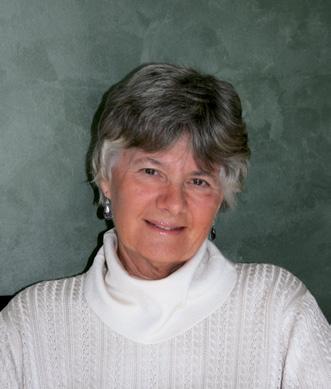
Awebsite is the face of your USDF group-member organization (GMO). An attractive site that’s well-organized and up to date can be an effective “shop window” for prospective members, as well as a valuable resource for existing members. In this article, we’ll cover the basics of website organization, design, and content, with input from experienced GMO officers and webmasters.
With social media capturing more attention, especially from younger people, why should your club even have a website? There are several reasons, including attracting
new members, engaging current members, publicizing events, and highlighting the local equine community.
Websites typically have functionality beyond what’s possible with social-media apps. A Wix site (glassed.com) is an important hub for the members of the Michigan-based USDF GMO Great Lakes Area Show Series – Educational Dressage (GLASS-ED), says club secretary Carmen Medina.




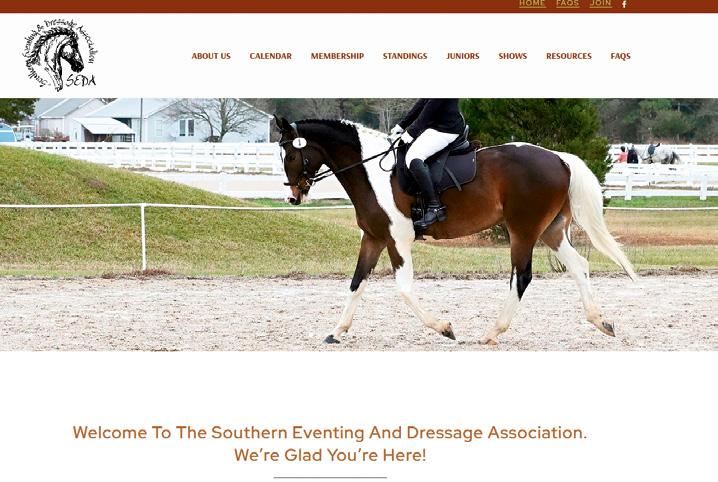
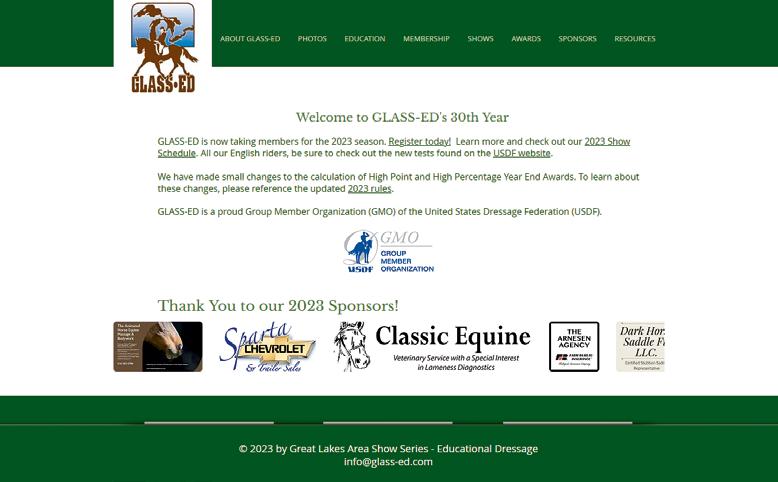
According to Medina, the top three functions of the GLASS-ED site are membership onboarding and renewals (“about 75% of membership forms and payment come through the site”), promotion
of and registrations for clinics and other educational events (“all clinic submissions are made online”), and everything to do with the GMO’s shows (“all details for each show, from show bills, registration forms, ride times and results, are posted on our site”).
The ideal website makes it easy for users to find the answers to common questions. In the case of a GMO, those questions probably include: How do I join or renew? When and where is the next schooling show? How do I qualify for yearend awards?
There is a fine line between providing too much information and not enough, and how the information is organized has a lot to do with it.
“I have a three-click rule,” says Nicole Miller, vice president of and webmaster for the Southern Eventing and Dressage Association (sedariders.org). Website users “should be able to find what they’re looking for in three clicks…. That’s why, on our home page, we have a bunch of boxes with quick links. If people don’t want to go through the navigation, they can scroll down and click on one of the pictures. All the main urgent news is on the home page, so people can just go look at that one page. They don’t have to click into anything else.”
What’s on the menu? To make navigation simple, consider setting up your GMO’s website with content “buckets”—menu items pointing users toward such informational categories as Membership, Competitions, Juniors, and Education. Not
all information fits neatly into one category, so beyond such basic menu items as About, Membership, Calendar, Newsletter, and FAQ (frequently asked questions), a site may also have have drop-downs, submenus, and internal links to more detailed pages.
However, “You’re trying not to make too many drop-down menus and tons of pages on the website…. You don’t want to get people lost on the website if you can avoid it,” cautions Lehigh Valley Dressage Association vice president and webmaster Sherry Morse (lvda.org). Plan site organization carefully, by “trying to figure out where the average user is going to look for things to start.”
Multiple menus can work if they’re well organized. The SEDA website has a top bar menu (a menu bar that displays above the main header on the site’s landing page) consisting of the most frequently used links: Home, FAQ, Join, and a link to the GMO’s Facebook page.
In the header itself is the site’s main menu: About Us, Calendar, Membership, Standings, Juniors, Shows, Resources, and FAQ. Within several of those menu items are submenus; for instance, under Membership are links to Member Directory, Forms, and Newsletters.

If your GMO comprises multiple chapters, links to the individual chapters are helpful. Displayed on the home page of the Virginia Dressage Association’s (VADA) website (virginiadressage.org) are the VADA chapter logos; each logo is in a clickable box that links to that chapter’s site. The California Dressage Society (CDS; california-dressage.org) and the Potomac Valley Dressage Association (PVDA; pvda.org) handle their chapter links a little differently, by listing chapters in the drop-down menu of their About pages, then including links to each chapter as well as all forms and documents for those individual chapters.
Many GMO websites also utilize
North America’s Premier Equine Exposition & Equestrian Gathering
• An Unparalleled Educational Program.
• The Largest Horse-Related Trade Show in North America.
• The Marketplace Consignment Shop.
• The Fantasia (sponsored by Absorbine) — Equine Affaire’s signature musical celebration of the horse on Thursday, Friday, and Saturday nights.
• Breed Pavilion, Horse & Farm Exhibits, Horses for Sale and Demonstrations Enjoy meeting horses of all breeds, colors, and disciplines!
• Equine Fundamentals Forum — Educational presentations, exhibits, and activities for new riders and horse owners.
• The Versatile Horse & Rider Competition — An exciting race through an obstacle course with $5,500 at stake!
• Adoption Affaire — Fall in love with your next horse at the Adoption Affaire.
• Drive A Draft — Experience the thrill of a lifetime and learn to drive a draft horse!
• A Horse for Heroes — Enjoy equine assisted activities and therapies for veterans, active-duty, and first responders, through Operation Horses and Heroes.
• The Great Equestrian Fitness Challenge (NEW) — A fun new activity for equestrians to exercise their barnyard skills and win prizes, no horses needed!
• Youth Activities and much, much more!
For all you need to know, consult equineaffaire.com or call (740) 845-0085.
Mike Major
Julie Goodnight
Brandi Lyons
Jason Irwin
Chelsea Canedy
Steffen Peters (Dressage)
Jeanne McDonald (Dressage)
Phillip Dutton (Eventing)
Andrew Welles (Hunter/Jumper)
Greg Robinson (Ranch Horse, Reined Cow Horse)
Mark Bolender (Mountain Trail)
Stacey Giere (Driving)
Bronwyn Irwin (Pole Bending)
Lynn Newton (Western Dressage)
Carl Bledsoe (Easy Gaited Horses)
Matt McHugh (Trailer Driving)
Sam & Kellie Rettinger (Draft Horses)
Jim Masterson (Equine Bodywork)

Marty Whittle (Equi Yoga)
Copper Hill Vaulting Team (Vaulting)
…and many more to be announced!
footer menus, which can be a useful place to add links to organizations such as USDF, social-media pages, a “Contact Us” form, or your club’s FAQ page.
The Host with the Most Which website hosting service and platform you choose can have a big impact on both the aesthetics and the functionality of your GMO’s site. Companies such as GoDaddy, Bluehost, and HostGator have lower-cost hosting options (under $10 per month), while hosts such as SiteGround, Kinsta, and WPEngine have higher monthly costs but offer more complete technical support and often guarantee that their sites will be secure, accessible, and quick to load nearly 100% of the time.
Some platforms, such as Wix and Squarespace, are self-hosted: A monthly fee covers both the website hosting and the use of the platform, which typically includes access to a number of premade design “themes” (templates) that can be easily customized, thereby offering a fairly quick and easy way to get a professional-looking site up and running. However, the majority of sites using a content-management
system (CMS) (over 65%, according to Hubspot.com) are built using the WordPress platform.
WordPress is a huge player in the world of websites. It offers almost unlimited variety in themes, plugins, and site-management options. WordPress’s flexibility gives it enough bells and whistles for a professional designer to develop a beautiful and sophisticated site, but it can be simple enough to enable a volunteer from your GMO to handle the regular maintenance.
“Most of the things now, if you’re using WordPress, are not difficult to manage,” says Miller, “but you do need someone you can bounce questions off of, because it’s not always easy for someone who does not have a website background. There is a little bit of code we need to know— nothing complex, necessarily. But it helps going in if you have some idea what some of these things are; it doesn’t always work the way it should out of the box.”
Some GMOs are fortunate enough to have a member who is a professional website designer serve as
The USDF offers annual website awards to GMOs, recognizing “best user experience” in four membership-size categories. Judges evaluate the following criteria: GMO information, number of clicks, links, menu, navigability, Help/FAQ, membership information, look and feel, and promotion of the club’s local horse community.

Winners are recognized during the GMO awards presentation at the Adequan®/USDF Annual Convention and in the yearbook issue of USDF Connection. Learn more and download the nomination form at usdf.org/awards/ service/gmo.asp.
their webmaster. Others pay outside pros for the service. In either case, routine site maintenance and updates often fall to a volunteer or the club’s marketing committee.
Of the GMOs we surveyed for this article, about half told us they have a professional webmaster (who in some cases is a club member who volunteers their time and talent). Forty percent paid for professional website creation, and the remainder relied on a board member or other volunteer to create the site.
Making all pertinent information easily accessible on a website is a major factor in user experience (UX), but aesthetics also plays a huge role. Consider these findings on website use as reported on Forbes.com:
• A website visitor forms an opinion about the site in 0.05 second.
• Half of internet users say that website design influences their opinion about a business. And 57% of users won’t recommend a business with a poorly designed website.
• If they consider a website’s layout to be unattractive, 38% of users won’t engage with the site.
• Almost half (48%) say the number-one factor in evaluating the credibility of a business is its website design.
There’s a lot riding on how your site looks and how engaging it is.
People have short attention spans. In addition to wanting a website to look good, we also want it to load quickly. We form split-second opinions, and if we don’t like what we see, we move on. As proof, here are some more eye-opening statistics from Forbes.com:
• 47% of users won’t wait longer than two seconds for a website to load.
• Website users spend an average
of 5.59 seconds looking at written content on a site.
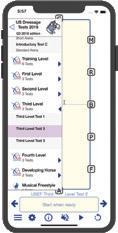
• The average time spent on a page is 54 seconds. But: Including videos can increase the time spent on a webpage by 88%. The average time spent on a page with video is six minutes.

• 88% of users won’t return to a site after a poor experience.
• If they don’t find what they’re looking for within about five seconds, 61% of users will leave the site and go elsewhere.
With mobile phones currently generating 60% to 70% of web traffic, it’s important that your GMO’s site looks as good and works as well on mobile devices (of all types and platforms) as on a desktop computer, laptop, or tablet. And given the lifestyle of many horse people, your site may be even more likely than most to be accessed via mobile—in the barn, at shows, or in other settings lacking Wi-Fi and otherwise impractical for computers and other larger devices.
While mobile users expect a site to load in under three seconds, they also like to watch videos. This often requires a balancing act between including videos, which capture people’s attention, and optimizing loading speed, which videos can hamper.
Good management of the “back end” of a website is critical in ensuring a smooth loading and viewing experience for users, says the LVDA’s Morse.
“Having a plan not just for the front end of the site but the organization of information on the back end is huge for me,” she says. “Without that organization, it’s almost impossible to keep things running smoothly on the front end, whether it’s grouping logo files, show-related files, or awards files. It needs to be organized from the get-go.”
Miller encourages GMOs to back

up their sites regularly “because hackers abound, and all it takes is something not getting updated, and you get a hacker in there and your site’s down. So make sure whoever your host is will do regular backups for you. That’s an important thing to do because stuff happens.” For instance, “the software automatically updates, and it might not play well with another piece in the software, and then your site’s down until somebody can fix it.”
To an e-commerce site, analytics are everything: data indicating where site visitors are from, how long they stay, how they found the site, and so on. These metrics can be helpful to a GMO’s website, but they may not be as critical for your club’s purposes.
“We don’t really have a need for that at this time,” Miller says of the SEDA website. “If our membership would suddenly tank for whatever reason, then that would be something that we would have to look at.”
In addition, the dominance of social media has lessened the importance of website analytics, Miller says.
“Social media is the way most people are getting their information, and the website is kind of the backup,” she says. “Actual site traffic is often down compared to what it used to be when people used [websites] as their main source to get all the information that they needed, so it’s hard to just look at your site traffic. You have to look at what your social-media influence is, as well, because it all ties together for how people are getting the information that they need about your group.”
Whether your GMO is hoping to capture a USDF GMO Website Award (see “USDF Recognizes Winning GMO Websites” on the opposite page) or simply wants to boost its online presence, having well-managed content on an attractive and inviting site is the winning ticket.
And keep in mind that, even after a website rollout or redesign, regular updates and touch-ups are needed to keep your club’s site fresh.
“Websites are always in evolution. It’s not like a ‘one and done’ and we don’t touch it after that,” says Miller. As her GMO’s webmaster, “I appreciate people’s feedback and always ask for feedback. What makes sense to me [in terms of organization] doesn’t necessarily make sense to somebody else. So if there’s a way to present information that’s going to be easier for people to find, then I’m all for that.”
Penny Hawes is a writer, rider, and coach from Virginia. When she’s not working, you can find her hiking with her daughter, scouting around for antiques with her husband, or hanging out with her assortment of horses, cats, and dogs.
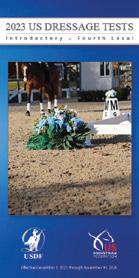
Balance is a fundamental concept in dressage training and riding. A deep understanding of balance is necessary both in guiding a horse’s correct gymnastic development and for success in competition.


The ability to recognize the elements of balance—which change as a dressage horse moves through the levels—is a skill that all good dressage judges must have. Many performance problems seen in competition are the result of the horse’s not being in the balance required for the work at the level and test it is doing, or of not being able to work consistently in an appropriate balance. But balance can be one of the more elusive concepts that trainers, riders, and judges have to deal with, and so this topic is worth some detailed discussion.
Balance and the rider. To be comfortable in the saddle and to be able to influence the horse effectively, the rider must always sit in balance with the horse. Doing so requires a stable, elastic seat that is centered over the horse’s own center of gravity. This way, the horse can receive clear, subtle aids from the rider and can develop the physique necessary to progress in its training. The horse
and rider can function as a harmonious team.
Longitudinal balance. In nature and in its early training, the horse carries more of its weight (as well as the weight of the rider) over its front legs. As dressage training progresses, the horse shifts more weight to its hind legs. This change in the longitudinal balance occurs as the horse develops increased engagement and collection, producing what we call an uphill balance. The resulting lightness of the forehand leads to an increase in mobility and self-carriage— which are possible because the hind legs are doing more of the work of supporting horse and rider.
In educating dressage judges, we ask them to look for a level balance at Training and First Levels. When the horse is traveling in a level balance, it appears to be carrying equal weight on all four legs. The trajectory of the forward motion is straight ahead. When a horse is carrying too much weight on its front legs for these levels (which we call being on the forehand), it appears to be traveling downhill or to be leaning on the rider’s hands, as if the horse needs a fifth leg out front for support.
As correct collection develops through the levels, the trajectory of the thrust of the stride should appear to be increasingly uphill. For success in the highest-level movements, such as piaffe and pirouettes, the horse must be able to take a great deal of the weight onto its hindquarters and to maintain that balance consistently. It can be even more difficult for the horse to maintain that highly collected balance in such movements as the canter “zigzag” in the Grand Prix test. Lateral balance. The horse’s lateral balance is also key in dressage training. On straight lines, curved lines, and lateral movements, we want the horse to appear to be using its left and right sides equally. I say “appear” because actual measurements with force plates tell a much more complex story. But judges and riders know that a horse that is “falling on the inside shoulder” on a circle, lacking alignment on a straight line, getting crooked in a transition, or losing rhythm in a lateral exercise is not maintaining proper lateral balance.
Balance and the dressage tests. In dressage competition, the judge wants to see that the horse is in the

longitudinal balance appropriate to the level. If your test sheet contains comments such as “fell on forehand,” “be more uphill,” “downhill,” or “carry more behind,” the judge is letting you know that there were problems with the longitudinal balance.
The horse is expected to maintain an appropriate longitudinal balance in all the movements and transitions. This is not an easy task! Often we see or feel moments in which the horse cannot quite keep its balance and as a result comes against the rider’s hands, either in an obvious way (by bracing the neck or tossing the head) or more subtly (by momentarily using the reins for support). The judge’s comments will reflect the perceived loss of balance—“came against hand,” “unsteady,” “lost rhythm,” “tempo changed,” and so on.
It can happen that the rider is left wondering what the judge saw that wasn’t ideal. If, say, the judge writes “balanced” for a short line of countercanter or for a canter depart but gives only a score of 7, the rider has no idea why 30% of the possible points were taken away. If the comment on the test reads “lost balance” but the horse did not stumble or dive suddenly onto the reins, the rider may not understand what the judge saw. More precise language would be helpful to the competitor. “Fell on forehand,” “braced,” “lost collection,” or “became crooked” are only a few of the many possibilities under the “lost balance” umbrella.
Balance is closely related to the idea of self-carriage, even at Training Level. Superbly executed transitions—in which the rider has the same light feel in the hands in the preparation, execution, and exit— show the consistency of balance that makes a winner. It’s a glorious feeling when you are in the saddle, and it’s a picture of harmony when observed from the ground.


As I was preparing to write this article, I attended the 2023 FEI World Cup Dressage Final in Omaha. As I watched the performances, it was clear that correct and exquisitely consistent balance produced the selfcarriage and harmony of the horses at the top. Although all of the horses were at a very high level, it was balance that separated the winners from the others.
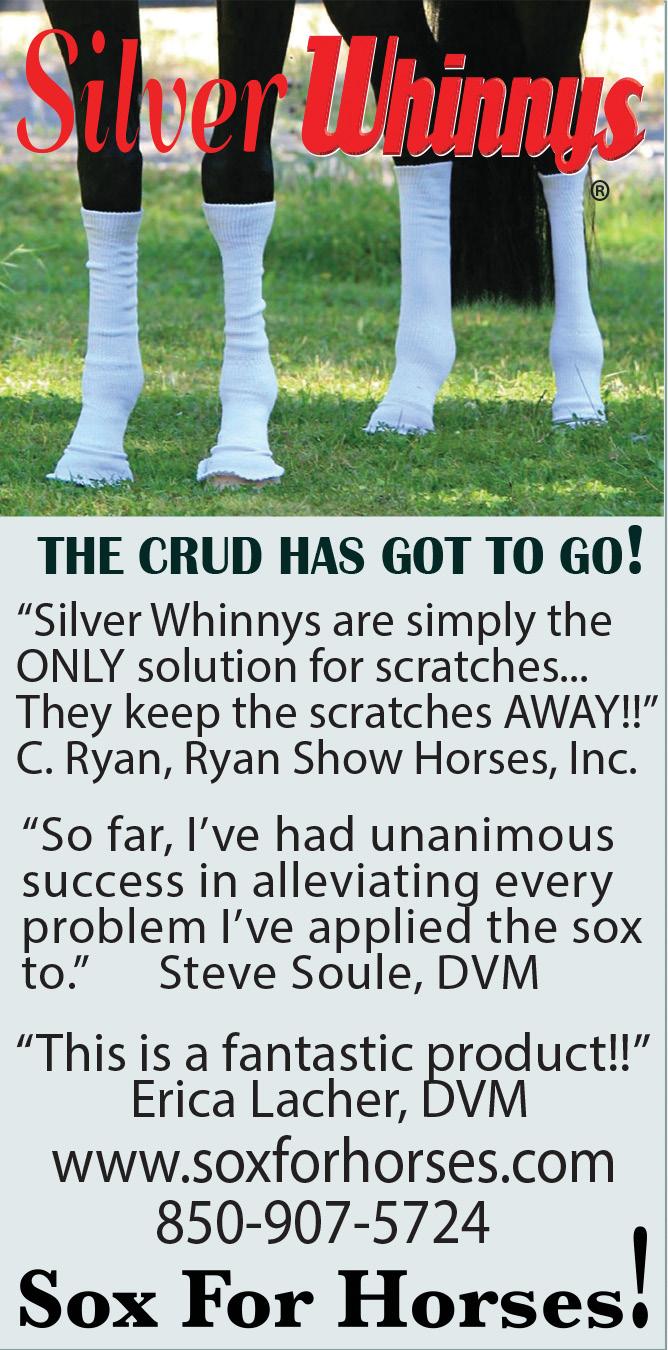
For over a century, the Dehner name has been proudly worn by young and old alike.

Feel for yourself the comfort and fit that have made us one of the most sought-after boots in the business!
Log-on today to view our full line of boots and shoes
US Equestrian “S” and retired FEI dressage judge and USEF “R” sporthorse breeding judge Jayne Ayers, of Pewaukee, Wisconsin, has been a USDF L Education Program faculty member since the program’s inception. She is a member of the USDF L Program Committee and a former longtime member of the USEF Dressage Sport Committee.

NOVEMBER 9–12, 2023 • KENTUCKY HORSE PARK featuring $120,000 in prize money

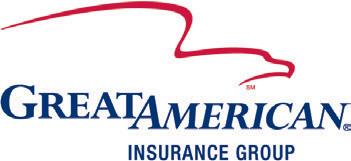

To help alleviate some of the financial burden for those traveling the greatest distances to the US Dressage Finals, USDF is making up to $50,000 in travel grant funds available to eligible competitors.
FOLLOW THE ACTION ON
1. Declare – Complete a Declaration of Intent for each level and division for which the horse/ rider combination may qualify. usdressagefinals.com/declare. Horse/rider combinations must Declare by midnight on the day prior to the first day of their Regional Championship competition (including any open class days before the start of the championship classes).
2. Qualify at one of the Great American/USDF Regional Championships.
3. Nominate – Nomination is required for participation in US Dressage Finals classes, whether qualifying through placing in a Regional Championship class or by Wild Card Eligibility. usdressagefinals.com/nominate
The Nomination (preliminary entry) deadline is midnight, 96 hours after the last championship day of your Regional Championship.
The Nomination fee paid will be applied to the total amount due at Closing Date. Nominated entries that do not receive an invitation will receive a full refund of nomination fees paid minus the $10 processing fee per nominated class.
Priority for all stabling requests (including stabling in heated Alltech Barn and for double stalls) will be based on the date of receipt of the completed entry and allotted per region.
4. Enter – Entry Opening Date is is September 21, 2023. Entry Closing Date is October 16, 2023 midnight Eastern Time. The nomination and entry processes can be completed concurrently.
For additional qualifying, declaration, nomination, and entry information visit usdressagefinals.com

Our columnist’s sights were set on an elite Young Riders competition tour when her career took a unscheduled detour. Now she’s running her own dressage training business.
By Tillie JonesIdidn’t come from a horsey family. My dad was taught that horses are for work, so he found the concept of horses being used for sport quite unorthodox. My mom was a “city girl” who feared horses.
I was drawn to horses from a young age. When we visited my grandma, I would sneak over the fence to a neighbor’s pasture to feed the horses my leftover carrots from lunch. Unfortunately, my family lived in the city, so it wasn’t often I had the chance to interact with horses.
expertise, and I became competitive in the junior and young rider divisions. I felt great joy while feeling my way through issues and finding ways to help the horse understand what I was communicating, but I never thought that teaching riding would be in my future. I didn’t know if I’d feel the same joy teaching others, and I doubted my ability to put “feel” into words.
As I got older and rode in several high-stakes competitions, I set rather intense goals and held myself to
the Florida season. I was devastated, but it was the break I needed to find a purpose beyond excelling in the show ring.
With our trip home coming earlier than expected, we didn’t have a facility to return to. I was anxiously looking for options when a friend in Nebraska offered me the opportunity to rent an equestrian facility that she had previously managed. With less than a month to go before the move date, my parents and I scrambled to figure out what we needed in order to operate a dressage facility successfully.
My decision to become a dressage professional did not come easily. When I left Florida for Nebraska, I feared that I would feel alone in this new venture. I feared that people in my life would be disappointed that I was putting my riding career on pause. I feared that I’d let people down and that I wasn’t experienced enough to become a professional. When I left for Florida at the beginning of the season, I never expected that in a few months I’d launch a career as a trainer and business owner.
Luckily, my mom’s childhood babysitter taught riding lessons, and they just so happened to be dressage lessons. For my seventh birthday, my parents surprised me with one lesson, which quickly became many more.
I rode every horse I was allowed to sit on, and in every dressage competition and lesson I could. As I progressed, I focused on improving as a rider while soaking up my trainer’s
ever-higher standards. My expectations for my performance became unhealthy, and I noticed my mental health declining as I focused on the result instead of on the journey. The pressure of succeeding in competition took the joy out of riding.
In 2022, my final year in the Young Riders division, I had aspirations to qualify for the European Tour when my horse sustained an injury that sidelined us for the rest of
Looking back, I’m glad that life has turned out the way it did. I have found joy in horses and riding again, with a new perspective and appreciation for the sport. I’m so grateful to have supportive people in my corner, encouraging me that I am enough.
By taking the risk of starting my own equestrian training business, I’ve grown immensely in ways I wouldn’t have otherwise. I’ve enjoyed this new role, figuring out beneficial routines and nutrition for the horses, building a clientele and a supportive barn family, teaching the next generation, and understanding my horses better than before. I have started competing again—but now I ride alongside my
students. It makes showing that much sweeter, seeing the smiles on their faces after they finish their tests and noticing the improvements between rides. I’m excited to see what the future has in store.
I’m just getting started. I’ve made many mistakes along the way, and I have a lot to learn. But I’d like to help other young dressage pros by sharing a few tips that have made my own transition easier.
• It’s OK to ask for help and not
Tillie Jones is a 22-year-old USDF silver medalist. In May 2022, after a stint as a working student for international competitor and mentor Olivia LaGoyWeltz, she opened her dressage training facility, Serenity Rose Equestrian Center LLC, in Lincoln, Nebraska. She ran the business while finishing her bachelor’s degree in psychology from Nebraska Wesleyan University, from which she graduated this year. In her first year as a dressage professional, she coached a student to two top-five placings at the US Dressage Finals.

Jones is a US Dressage Festival of Champions veteran and an FEI North American Youth Championships medalist, as both a junior and a young rider. Currently she trains virtually with LaGoy-Weltz and in person with Emily Miles. Jones’s goals include moving up to the FEI U25 division, earning her USDF gold medal, and developing her new young horses up the training scale.
Follow Jones on Instagram @ tilliejdressage and on Facebook @ Tillie Jones.
to have all the answers. There are professionals in this sport who are willing to help and who want to see you succeed. Don’t be afraid to contact them.
• Trust your intuition. You’ve been in this industry long enough to know right from wrong. If something feels wrong, trust your gut.
• Don’t sell yourself short. When it comes to building clientele or setting rates for board and training, know your worth.
• Choose clients who will fit well in your program. Recognize that building a business takes time.
• Find your team. Connect with trustworthy farriers, veterinarians, saddle fitters, trainers, clinicians, local farmers, and “barn family.” Look for people who have similar goals and interests. Do your research. Connect with those who will help you through adversity.
• Join Facebook support groups, especially the Young/Young-Ish Equine Professionals Forum. There are many lovely professionals in this group who share similar goals and have been through similar situations.
• Take care of yourself. Others are counting on you to lead and to be 100% present. Meditate; do yoga; be mindful; take a day off. Create boundaries between work and home life. It’s not selfish or lazy to take a day off!
• Social media is a prevalent piece of our culture and generation. Use it to promote your business and what you stand for. Create a website and Instagram and Facebook pages. Have fun with it. Be creative, post reels, and be lighthearted.
• Support other professionals and businesses in the community. Help neighbors and other riders without the expectation of receiving anything in return.
• Apply for grants and scholarships. The Dressage Foundation and local dressage associations
offer multiple opportunities to young professionals.
• Have a backup plan. Go to college or take some classes if it’s right for you. Don’t put all your eggs in one basket. This sport is unpredictable. Having a backup plan isn’t planning for failure; it’s planning your future.
• Understand that being a professional and running a barn are not easy. Anticipate long days and limited time off, as with any new business. It takes a lot of hard work, money, and time, but it is well worth it.
• Be patient. It takes several years to get a new business off the ground. Don’t get discouraged.
• Take risks and go out of your comfort zone. You may fail before you succeed—but you must take the jump first.
Today I am the trainer and owner of Serenity Rose Equestrian Center LLC, Lincoln, Nebraska. I’ve surrounded myself with positive, supportive, and like-minded individuals who have made the journey even sweeter. It’s a future I never predicted, but I’m right where I’m supposed to be.
• Fit, fashion, and function: Choosing riding boots for dressage
• Adrienne Lyle: Why you need to raise your training standards
• Equine ulcers: Latest diagnostics and treatments
• Holiday gift guide
Not far removed from the Young Rider ranks, Katie Duerrhammer threw herself into her first full-time instructor/trainer job, coaching a client’s kids. Impressed, the client became a sponsor—and now they’re competing on the world’s biggest stages.
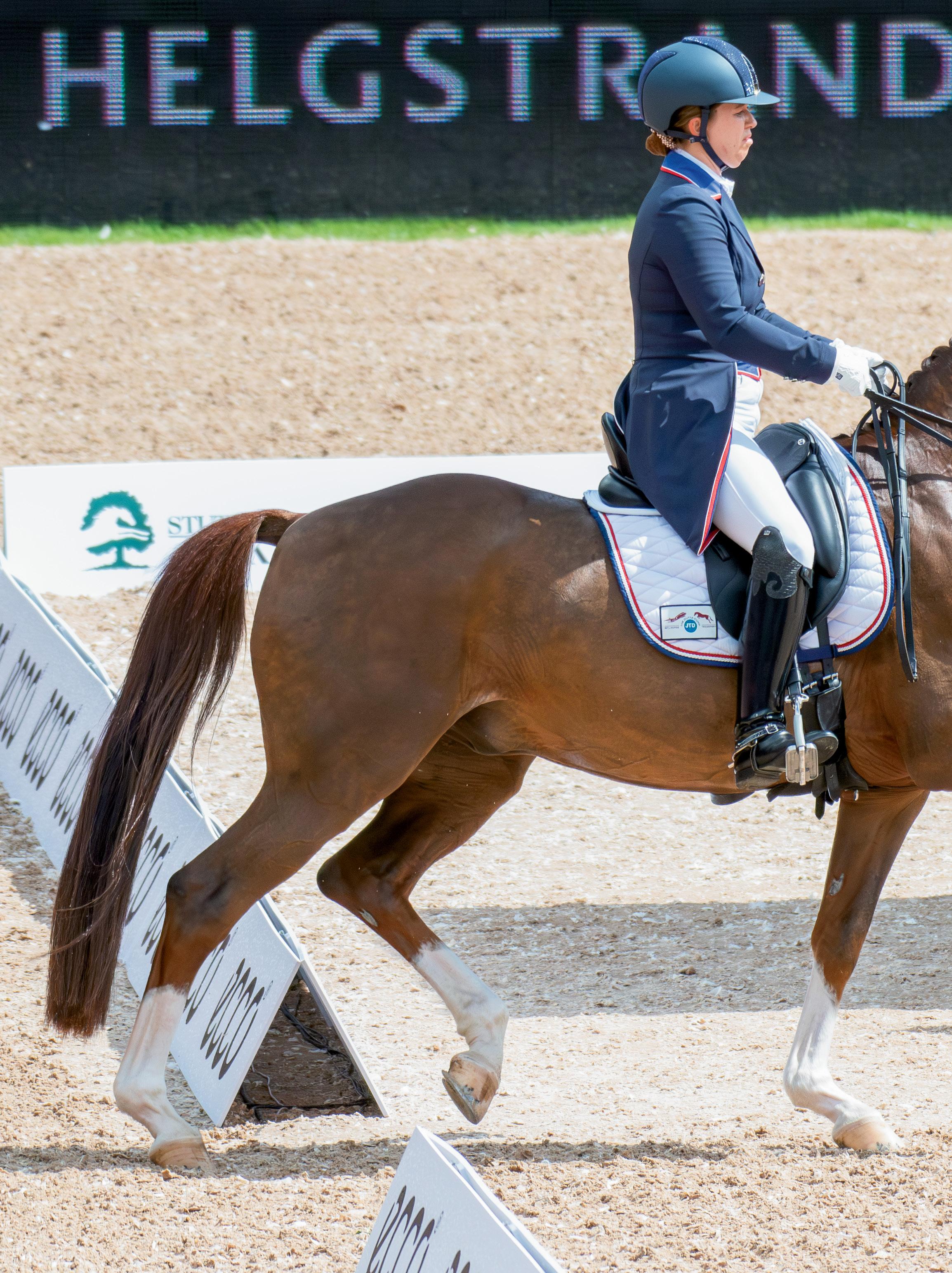 BY KIM F. MILLER
BY KIM F. MILLER
robably something in communications.”
That’s what Katie Duerrhammer figures her career would have been, had she stuck with her decision to get out of the horse world 13 years ago and finish college.
She may not have earned a degree, but her communication skills have come in pretty handy, after all—the key, she believes, that opened the door to international dressage success beyond her wildest dreams.
Duerrhammer, 35, says that as a dressage pro, the priority is “not always what’s important to you; it’s what’s important to your client.” Determining that priority requires “clear lines of communication and that you really, truly understand what your client’s goal is and what that means to them. Not understanding and not really valuing what is important to your client or student is a mistake.”

Her ability to listen and her willingness to commit to a client’s vision would in a few short years reap rewards that Duerrhammer—and even the client herself—had never thought possible.
In 2010, after winning USDF Region 7 Young Rider team and individual dressage gold medals at the 2008 FEI North American Junior and Young Rider Championships (now North American Youth Championships, or NAYC), Duerrhammer (née Johnson) was taking a break from the sport. Burned out after the competitive grind of her young-rider years and weary after a demanding year abroad as a dressage working student, she was contemplating quitting horses entirely.
Then the phone rang.
It was US dressage Olympian and then US Equestrian national dressage technical advisor Debbie McDonald, for whom Duerrhammer had been a working student as a teenager. A woman had contacted McDonald, seeking a good dressage trainer to coach her two young daughters in their own NAYC pursuits at the family’s farm in Littleton, Colorado, near Denver. McDonald thought it would be a good opportunity for Duerrhammer.
After years in the sport, McDonald recognized dedication when she saw it. Duerrhammer recalls McDonald telling her that “you hand-walked my horses like it was your Olympic sport.” The compliment came after the young
southern California native had approached McDonald at a show about becoming a working student.
“I hand-walked her horses from dawn to dusk,” Duerrhammer says. “I was so happy to be there, I never said a peep, and I didn’t care that it wasn’t glamorous.”
That drive and willingness to work showed up early. Under the tutelage of her mother, the dressage professional Elizabeth Johnson, young Katie Johnson’s equestrian career began with a pony named Oreo. Her first horse was an off-track Thoroughbred, with whom she progressed to targeting the NAYC, but the horse wasn’t quite up to the task at that level.
Short on horsepower and funds, Duerrhammer felt her Young Rider dreams slipping away as she faced her last year of NAYC eligibility. At her parents’ urging, she called about sale-horse listings in the California Dressage Society newsletter in the hope that someone would lend her a suitable ride.
One seller, Pam Schachter,
stepped up, lending the eager girl her 14-year-old Dutch Warmblood gelding, Millennium. After just two weeks together, the pair placed second in a San Diego CDI. Three months later, Duerrhammer was standing on the NAJYRC gold-medal podium.
Duerrhammer, who grew up in El Cajon, California, east of San Diego, began teaching riding at 16 and worked as an equestrian professional after high school while juggling a full load of community-college courses. “On weekends,” she recalls, “I coached amateurs who wanted to take lessons once a week on their Quarter Horses. I trained somebody’s horse to cross the water, another to work through his food aggression, and a Tennessee Walker to gait better.” There wasn’t much money in it, “but I learned that every single horse and person can teach you something.”
The schedule was grueling, and after a year Duerrhammer decided to take her dressage education to the next level, landing a position as a working student for Helmut Freiherr von Fircks at Gestüt Nymphenburg in Germany. She rode, taught, competed, worked as an FEI groom, and managed the farm’s staff of grooms. A planned three-month stay turned into a year away from home—and from her boyfriend, Gerhard Duerrhammer.
When she returned home, Duerrhammer hung up her spurs— for good, she thought—to resume her education and to spend more time with Gerhard Duerrhammer, whom she later married, in September 2021. But you know what they say about the best-laid plans.
When McDonald suggested that Duerrhammer explore the job opportunity, the young woman hesi-
tated. She now had a year of college under her belt; she wasn’t keen on leaving California for Denver; and she wasn’t sure she wanted to get back into the horse world. But she agreed to travel to Colorado to meet the client, Kylee Lourie, and take a tour of Lourie’s TyL Farm.

“I went there thinking I was not going to like it,” Duerrhammer admits. “But some people you just click with. I love teaching, and the kids were incredibly nice—really hard-working, and they really wanted to learn. And, with Kylee, it was just so clear how enthused and committed she was.”
It was Duerrhammer’s heart, not her head, that made the decision.
“I’m a go-with-my-gut person, and I could tell they were people who were 150,000 percent in. And that’s how I am.”
The job at TyL Farm was as a dressage instructor/trainer and coach; support of Duerrhammer’s own riding career was not part of the deal. But the young trainer
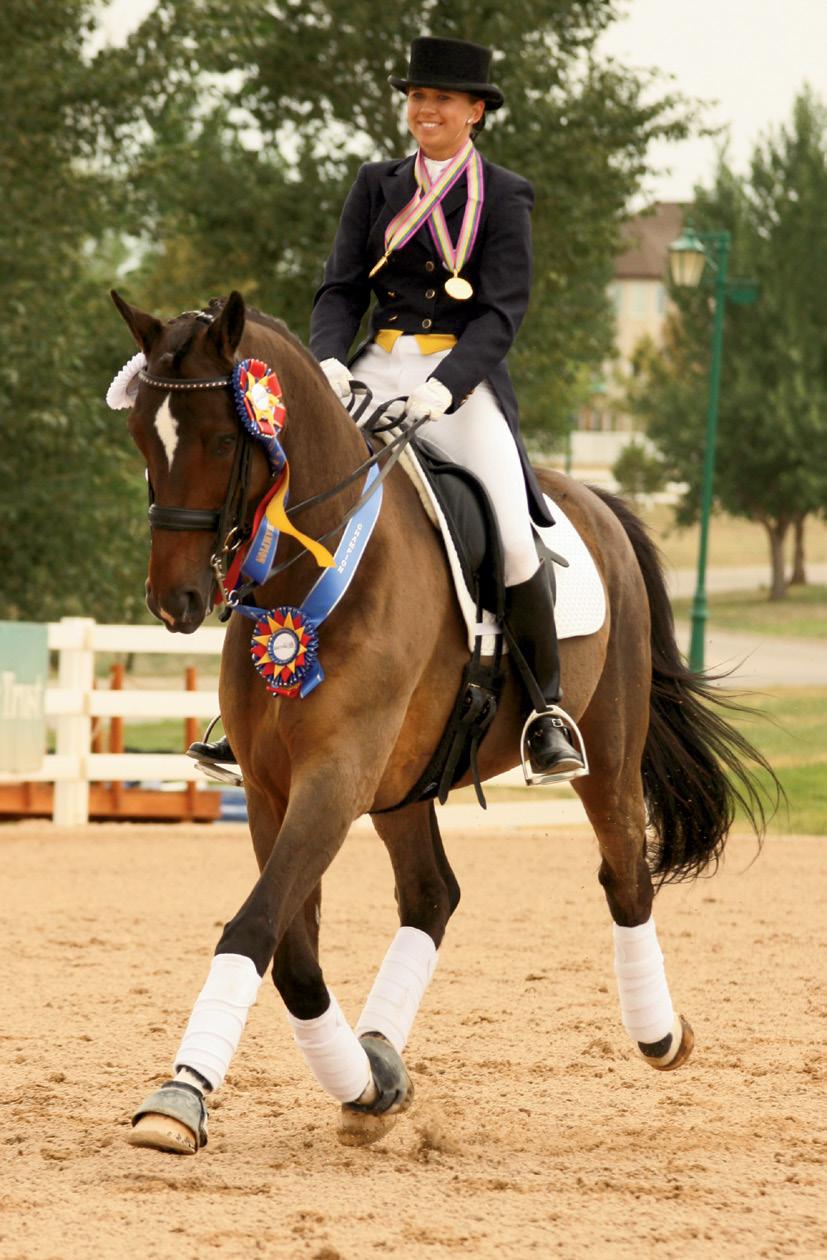
impressed Lourie with her commitment to her students.
“I really fell in love with how much I could trust her, because she put my daughters first, you know?” Lourie told USDF Connection in August 2022. Of course, Duerrhammer also demonstrated an obvious talent for dressage, coupled with a fierce desire to improve and excel. The combination caused Lourie to rethink their professional relationship.
As Lourie told USDF Connection last year, “I decided I believed in her enough to want to see if we could get her to the Olympics, but not by buying a finished horse. So we started buying young horses.”
The conduit to those young horses was the fourth pivotal player in Team TyL: Adrienne Lyle.
Perhaps the best-known of McDonald’s protégés, Adrienne Lyle began as a working student for the Olympian in Idaho and has gone on to become one of the USA’s biggest current dressage stars. Lyle is a two-time Olympian herself and most recently was the highestscoring American at the 2022 World Dressage Championships in Herning, Denmark, aboard Betsy Juliano LLC’s Salvino. Today Lyle and Duerrhammer are both based at Lourie’s facilities, summering in Colorado and wintering in Wellington, Florida, each operating her own dressage-training business but both working together as teammates.
Thanks to Lourie’s support, Lyle began coaching Duerrhammer and also began helping to find horses for Duerrhammer and for Lourie, who is herself an accomplished adult-amateur dressage rider. One of those horses, the 2008 Deutsche Sportpferd (DSP, or German Sport Horse) gelding Quartett (Quaterback x Dream of Glory), was
actually purchased as a mount for Lourie; and the owner continues to ride him, even as Duerrhammer developed him to Grand Prix.
The two riders share not only the horse, but also the process. Lourie says she especially appreciates it when Duerrhammer walks her through a training struggle.
“I love hearing, ‘We tried this and that,’” Lourie says. “I get to learn so much.”
Which brings us back to the communication that Duerrhammer says has been key to her career success. As Lourie explains, “Sometimes Katie needs to tell me things because we need to make a decision, but she also tells me things so I can enjoy the journey. She tells me about an issue she’s been working through in her lessons with Adrienne, and the details about the ups and downs with each of the horses.”
Besides Quartett, the current string also includes Duerrhammer’s other international Grand Prix mount, Paxton, a 2011 Westfalen gelding (Dante Weltino OLD x Don
Marco). Paxton was Duerrhammer’s team silver-medal-winning partner at the 2022 CDIO5* Rotterdam, Netherlands.
Now the resident rider, trainer, and coach for Lourie’s TyL Dressage business, Duerrhammer currently has charge of a total of eight horses, four of which are specifically intended for her to develop and compete at the elite levels. In the pipeline for the future are a yearling and two foals, Duerrhammer says.
Less than two years after entering the Big Tour ranks, Duerrhammer found herself in a pinch-worthy position: as the rookie member of Team USA for the 2022 FEI World Dressage Championships in Herning, Denmark, with Quartett. What’s more, one of her teammates was Lyle, her own coach.
Duerrhammer’s performance with “Ted” in Herning checked all the boxes: With a Grand Prix score of 70.839%, the pair broke the 70% threshold (thereby achieving Duerrhammer’s personal goal for the
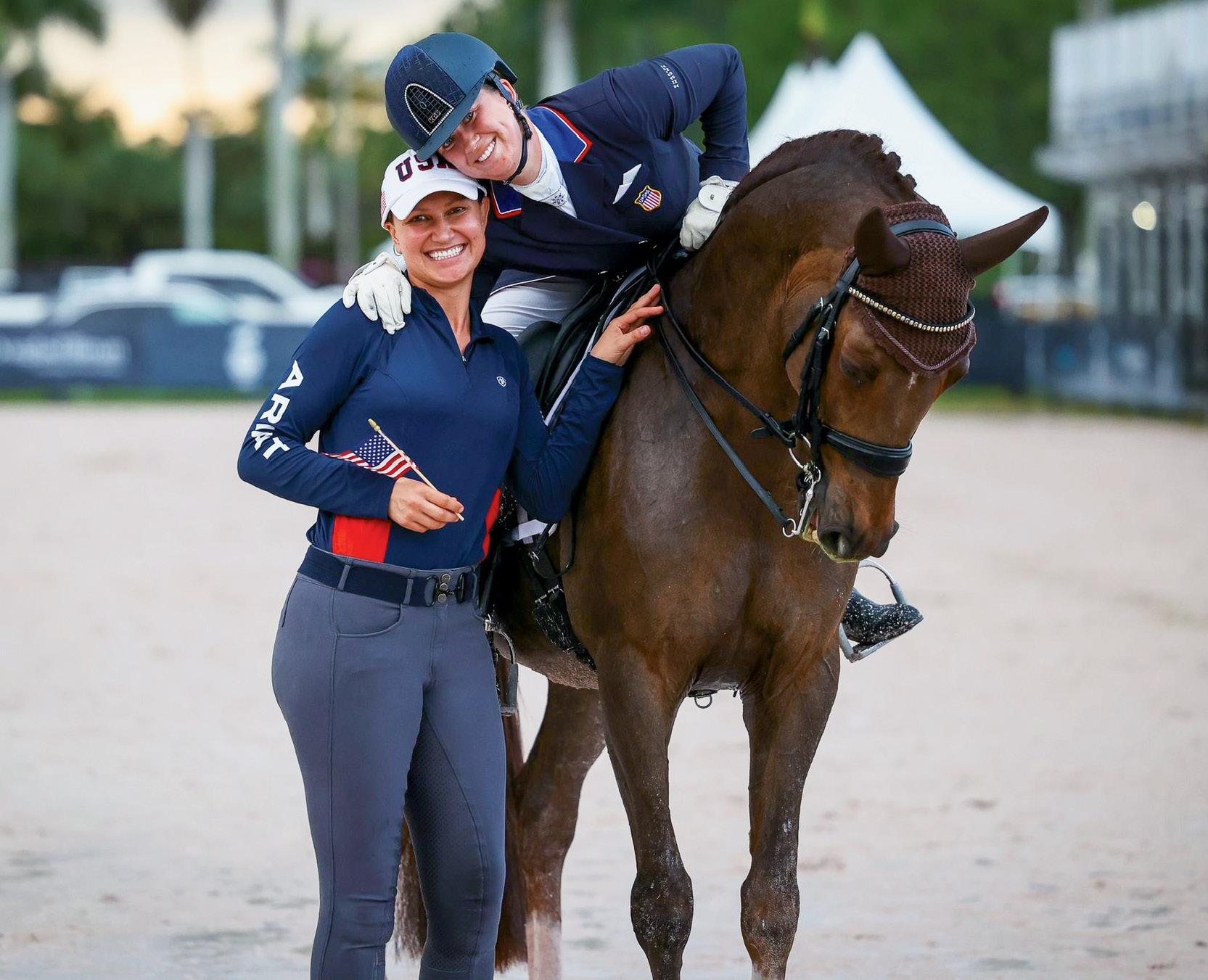
competition) and helped Team USA to a sixth-place finish, which secured its qualification for the 2024 Paris Olympics. US FEI 5* dressage judge Anne Gribbons, who was on the panel at Herning, praised Duerrhammer’s “secure” and “confident” test, noting that “there was wonderful harmony” and adding, “That’s a very promising rider” (USDF Connection, November/ December 2022).
“It was kind of a dream of ours to have a team horse and owner and build them together,” Duerrhammer told USDF Connection in Herning. “I feel like it was extra-special to have the first horse we really accom-
plished this on be one that she’s actually ridden a lot,” she said of Lourie.
TyL stands for “Thank You, Lord,” a phrase that Lourie has described as a gentle nudge toward everyday humility and gratitude. It’s part of the corporate culture in Lourie’s professional life, as CEO of the softwaresystems company Nextworld; and she considers an “attitude of gratitude” to be crucial in finding joy in the sport of dressage.
Our sport “has so many letdowns and things you can’t control,” Lourie says. “You have to enjoy the journey,
and that is only enjoyable if you have teamwork.”
“I absolutely believe that we are better together, but a lot of barns don’t necessarily operate that way,” Lourie continues. “We are pretty picky. We don’t let anyone come to the barn that we don’t see as a team player for the entire team.”
Besides Duerrhammer and Lyle, Team TyL is nurturing the next generation of dressage stars, including young riders Emma Asher, Quinn Iverson, and Christian Simonson. Iverson and Simonson are students of Lyle’s, while Asher rides with Duerrhammer.
The group functions as “one giant team,” Duerrhammer says. “If we’re having a late day and there’s still a lot to do, the kids do jobs that are not theirs. They hang out outside of work, and they ride together so there is always someone there to comment or lend support, physically or emotionally, in the good or bad times. This is the team atmosphere that we don’t normally see in dressage.”
“It’s an attitude that, if I’m not winning, then you’re winning, and that makes it really healthy and really fun,” Duerrhammer explains. Instead of thinking, “If that person is good, they could be better than me,” it reframes the narrative as, “I could be that good, too, and we could be better together.”
“It’s how Adrienne and I train together,” she explains. “The better she is, the better I can be because we are sharing our knowledge.”
At press time, Duerrhammer and Lourie were gearing up for their two remaining main goals of 2023: to have a successful showing at the US Dressage Festival of Champions in August, and then to make the US
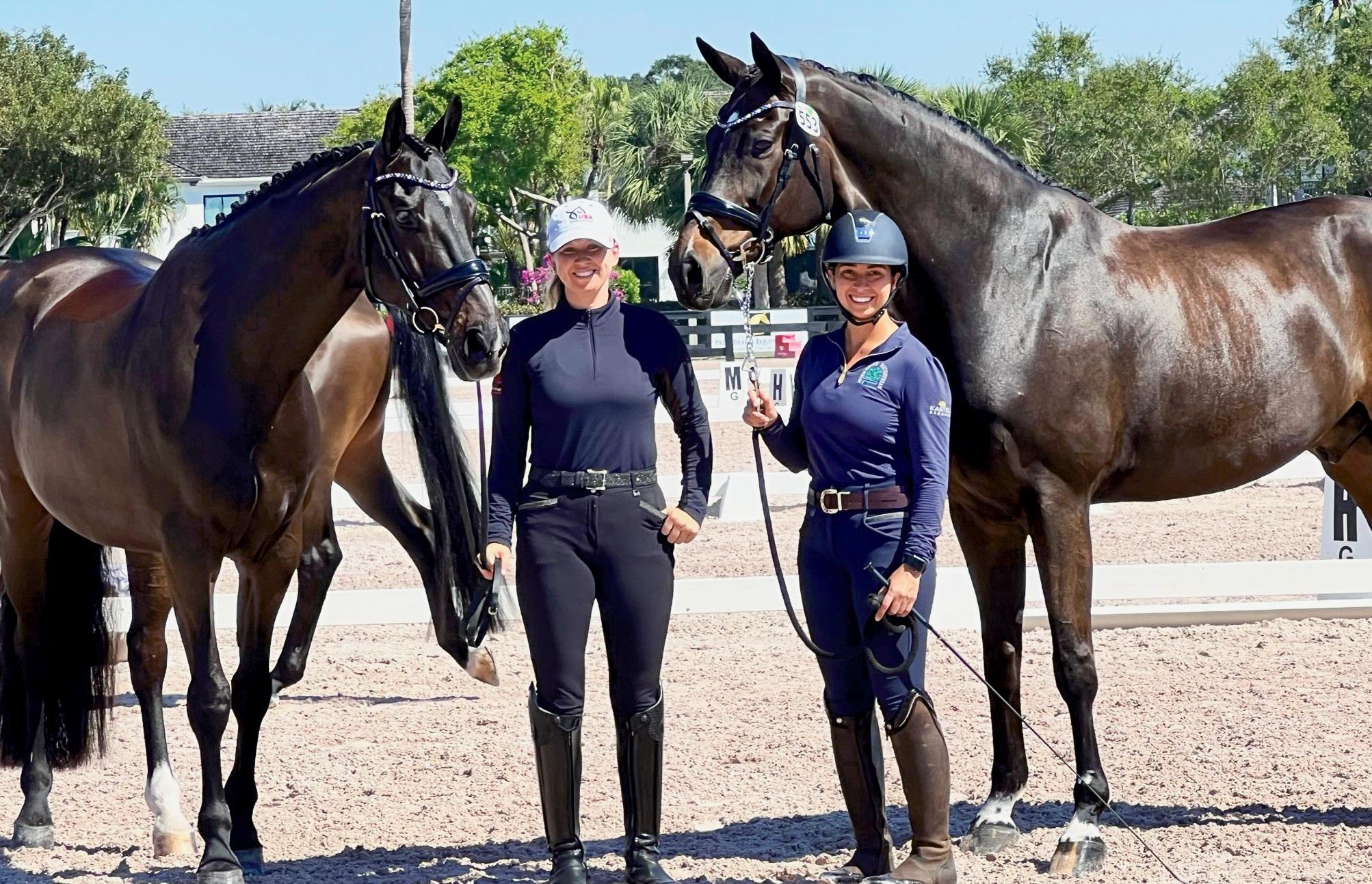
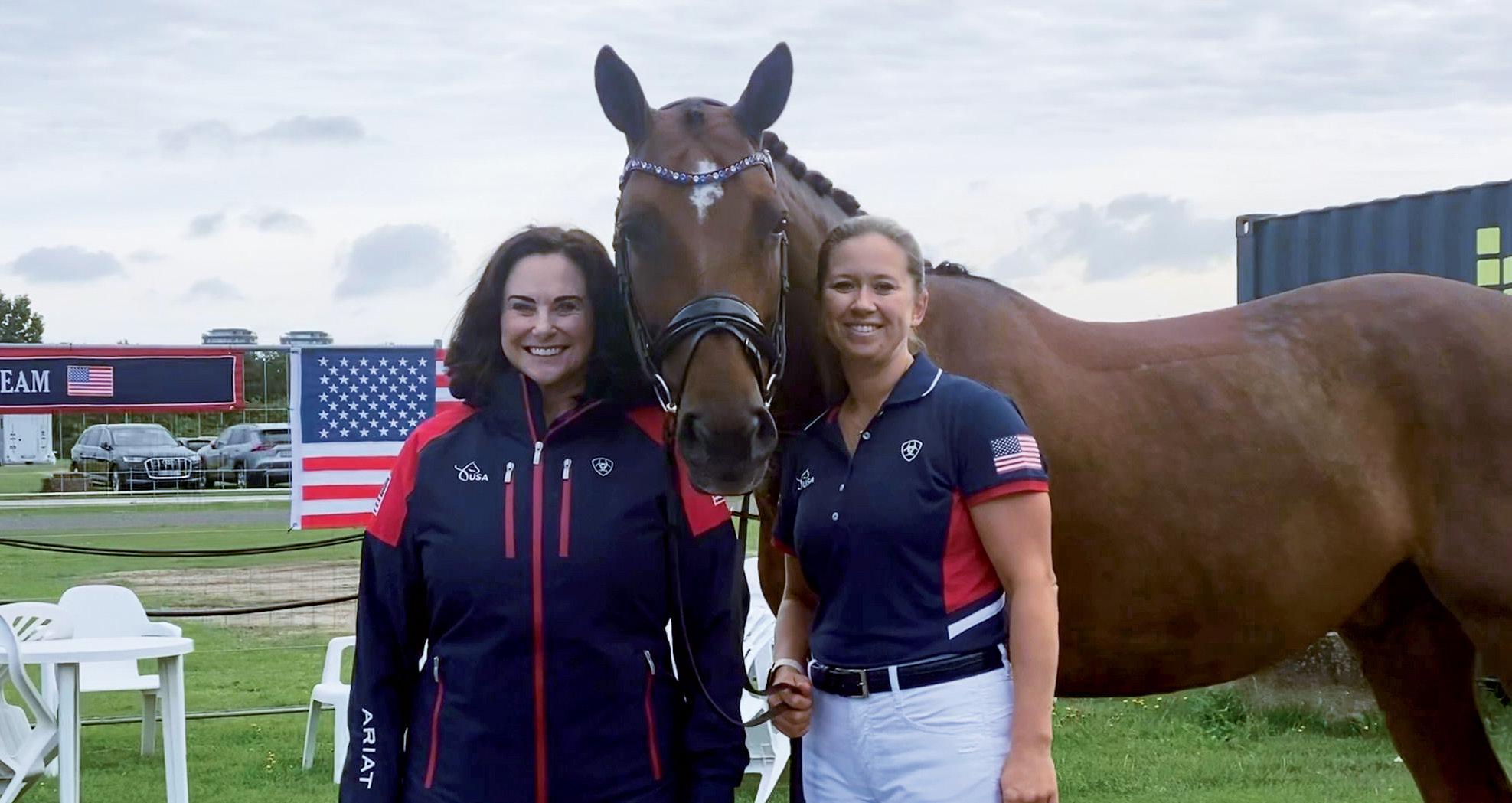
Pan American Games dressage team this October. The next Really Big Goal, of course, is the one they’ve dreamed of from the outset: to see Duerrhammer canter down center line on one of Lourie’s horses at the 2024 Paris Olympic Games.
Rider and sponsor seem just as thrilled with the partnership today as they were in the beginning, when “Katie’s integrity as a person made me trust her in going beyond our original agreement,” Lourie says. “It’s pretty exciting to be involved with Katie and with the level of horsemanship excellence that begins with Debbie McDonald and Adrienne.”
Meanwhile, Duerrhammer says, she remains astonished at her own meteoric rise up the dressage ranks.
“I pinch myself more and more,” she says. “Even if you asked me five or six years ago if I ever imagined being where I am now, I would have said you are crazy!”

As a former young rider herself, Katie Duerrhammer enjoys giving back to youth in dressage. In January, she joined the roster of wellknown coaches at the 2023 USEF Robert Dover Horsemastership Clinic, an intensive educational experience for top dressage riders under the age of 25.

“It was really rewarding to work with such a good group of girls,” Duerrhammer says. “They were very open to new ideas, and open-minded and honest toward learning to communicate with their horses better. They were great about saying, ‘Here’s what I struggle with. Do you have any ideas?’”
Although she herself is a double Young Rider gold medalist, she has since learned that “it doesn’t matter” whether you win an FEI North American Youth Championships medal, in terms of future success.
“At the end of the day, nobody’s career was made in the Juniors or Young Riders,” she says. So “don’t get caught up in having the fanciest or most expensive or highest-scoring horse.”
Kim F. Miller is a California-based freelance writer and the senior partnerships manager at Haygain.
Instead, she advises, focus on what is likely to leave the most lasting impression on potential future clients or sponsors: your behavior.
“What they notice in that phase of life, especially if you are in any kind of spotlight, is who you are and how you act,” Duerrhammer says. “Know that someone is always watching. What you say and what you do always have to match. Debbie [McDonald] told me that as a working student.”
Approach the transition from young rider to dressage professional with a dose of humility: “At that age, no one is a good-enough rider to have that be their career.” Excellent grooming and organizational skills, not riding prowess, are more likely to help land a job with a top pro who could serve as a mentor, Duerrhammer says. So “be worth investing somebody’s time and training in. Be open to wanting to learn, and have a great attitude.”
On the job, be a resourceful self-starter. “If you see someone that’s having a problem, think about how you could help them solve it,” Duerrhammer says. As she did when she began working for Kylee Lourie, who’s now her sponsor, align your actions and goals with your client’s goals: “Ask how you can provide a service that benefits someone, rather than always asking how it will benefit me.”

Those who have excelled in their dressage careers offer wisdom
BY EMILY ESTERSONTHE FOUNDATION: Eventer Laine Ashker once yawned at the idea of dressage. Now she competes at the FEI levels when she’s not jumping all the things.
en thousand rides, 20,000 hours, or a lifetime in the saddle. However you choose to measure the amount of time it takes to gain expertise in dressage, it is undeniably a long process.
Those who have spent many years learning this always-fascinating, often-difficult, occasionally-frustrating, and ultimately-rewarding sport have much hardwon wisdom to share with the next generation of dressage enthusiasts. For this article, we asked a selection of judges, instructor/trainers, and amateur riders what they wish they’d known about dressage when they were embarking on their own journeys through the levels.
The “three mysteries of dressage,” according to US Equestrian “S” dressage judge Maryal Barnett, are: Will I ever be able to sit the trot? Will I ever be able to get my horse on the bit? Am I ever going to be able to truly collect my horse?
Barnett, an instructor/trainer and former USDF L program faculty member from Holt, Michigan, recalls scribing for the late Maj. Gen. Jonathan Burton when the Roemer Foundation/USDF Hall of Fame member put her on the spot by asking her to describe the three most important things in riding dressage. He then answered his own question: “The seat, the seat, and the seat.”
Barnett herself was judging a lot locally at the time, and she agreed with Burton’s assessment. “I thought, Oh my god, [riders] can’t sit the trot. How are you going to be able to do anything humanely, do the movement, if your seat is not there?” She wants aspiring dressage riders to know that the way to develop a good seat is first to know what a good seat looks like, and then to take lunge lessons with a knowledgeable instructor.
Although Barnett has ridden since her aunt put her on a horse at the age of four, she did not know that dressage existed until she and her then-husband took their two children to the 1961 Michigan State Fair, where future Roemer Foundation/USDF Hall of Famer Chuck Grant gave a dressage exhibition.
“I had never seen anything like that, and it hooked me,” Barnett says. She soaked up as much dressage education as she could, taking lessons and clinics and attending judges’ forums. Her own competitive career stalled for a while, but she kept at it and eventually reached the Grand Prix level, winning numerous awards along the way.
Even if a dressage enthusiast has no interest in becom-
ing a dressage judge, “you will learn so much” from auditing the USDF L program, Barnett says. “There is so much information, in that it is an accumulation of everyone who has been on the faculty. It’s the knowledge I had to fight for in my life, rather than it being presented to me.”
Likewise, the USDF Instructor/Trainer Development Program workshops have much to offer, even if a rider or trainer does not aspire to earn instructor certification.
Thanks to the proliferation of online videos, educational opportunities exist today that were unheard of when Barnett was climbing the levels. She cautions, however, that students of dressage must be knowledgeable enough to identify experts who follow the established basic principles. She explains: “When I talk about basics, I mean the pyramid of training. Everyone should know and understand that.”
Dressage can be all-encompassing, but Barnett recommends cultivating other interests and friends who are outside the horse world. At dinners at the competitions where she judges, she makes a point of trying to sit next to non-riders “so we can talk about things other than horses.”
“S” judge Natalie Lamping has learned the value of patience and preparation in producing both correct training and high-scoring dressage tests.
“Things take time,” says Lamping, of Ocala, Florida, a USDF bronze, silver, and gold medalist whose silver medal was the first one ever awarded. “You have to be patient, and you have to teach the horse to wait. Everyone is trying to catch up to the horse; that’s when horses take over and become short in the neck and overbent,” she says. When the horse anticipates, “you will end up playing catch-up with your horse, and it gets worse as the movements get harder.”
Preparing to show should be a thorough, detailed process, says Lamping, who adds that she doesn’t often see a truly well-executed test. Before competitors go down center line, she says, they need to learn the test, read the directive ideas, and truly understand what is expected of a horse and rider at that level.
Another frequently missing piece is the understanding of how each dressage test builds on the previous ones. Competitors who skip over tests often have missing skills, says Lamping, who shares test-riding advice on her Facebook blog, LampPost.
He taught high-school English before he became a world-class eventing competitor, so it’s not surprising
that 1974 World Eventing Championships veteran Denny Emerson, of Strafford, Vermont (How Good Riders Get Good; Know Better to Do Better; Begin and Begin Again), brings a thoughtful, intellectual approach to an otherwise adrenaline-fueled sport.
Eventing in the 1960s and ’70s was pretty rough and ready, Emerson says, with most riders not truly understanding what the dressage phase was about. As a result, he says, “There were flexed jaws that were levered on to make the horse obedient.”
In Emerson’s 53 seasons at preliminary or above, he has learned the importance of gauging his mounts’ anxiety during training.
“A horse would rather be left alone,” he explains. “When humans train or teach horses to do things, the horse first of all has to be physically strong enough to handle the pressure. A horse can only do what it is strong enough to do, and then it can only do what it has been taught to do.”
We train horses through pres-
sure. When we ask a horse to bend, to go forward, and to half-halt, we are applying pressure, both physically and psychologically. Emerson now understands that “when those pressures go past the anxiety threshold, you may get the horse to do it; but if you make the horse nervous, you have won the battle but lost the war. An anxious horse doesn’t learn well.”
Emerson tells impatient equestrians to consider how long it takes to become a doctor, or a lawyer, or an engineer. Acquiring a horsemanship education is likewise a long, slow, time-consuming, difficult activity. There are no shortcuts— something he finds younger riders may not want to hear. “Part of that has to do with age; kids are fierce and have competitive fervor,” he says. “They lose sight of what’s going on, and they might not listen.”
He has also learned that not every horse possesses the physical ability or the temperament to perform high-level dressage. So “if you are struggling, take a look at the horse you are sitting on. What
are his abilities for the sport you are doing?”
Laine Ashker, of Chesterfield, Virginia, wishes she could turn back the clock to when she was a teenaged Pony Club member and eventing enthusiast who was offered the opportunity to train with the late German dressage master Georg Theodorescu for a few months. She turned it down, saying that she wanted to be an eventer, not a dressage rider.
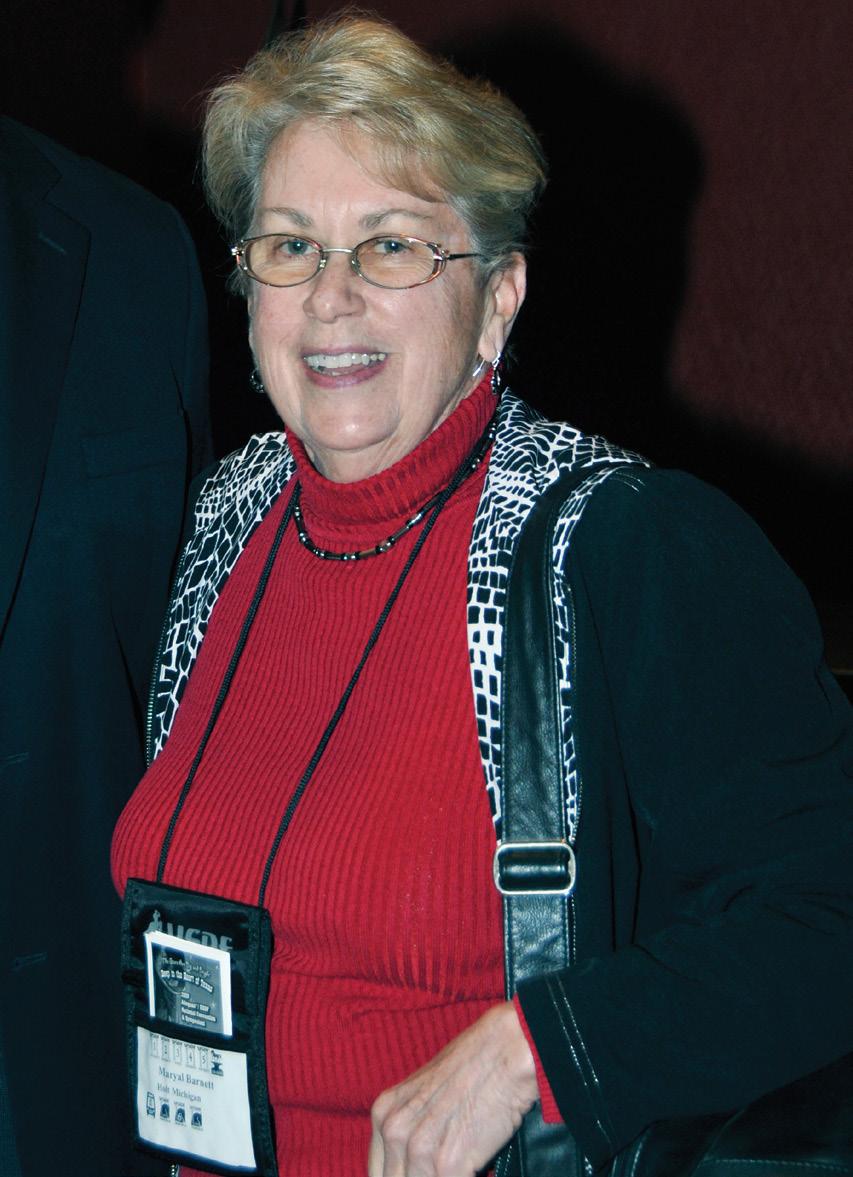
“I am still kicking myself for that,” Ashker admits.
Ironically, although Ashker did indeed become a successful eventer, competing through the five-star level at Kentucky, Burghley, and others, she has also become a “dressage queen” in her own right, earning her USDF gold medal in 2019 aided by coaching from Canadian dressage Olympian Jacquie Brooks.

“Dressage has taught me so much about fitness, nutrition, and balance,” Ashker says. “It’s been a learning and humbling experience.”
She describes dressage as the art of patience. “There are a ton of
different exercises and a whole different symbiosis and harmony—a lot of ‘less is more.’ For example, I didn’t understand what a proper half-halt was, and that you have to do way less.”
That epiphany came courtesy of Olympian and Roemer Foundation/USDF Hall of Fame member Michael Poulin. Ashker was training her mount Atlas in piaffe when Poulin told her that she was kicking too much. “We eventers ride with two active legs,” Ashker says, referring to the way she approaches a jump. But for piaffe, Poulin explained, “I needed to use my leg, but it needed to be a whisper. In dressage land, you use whispering aids.”
Along the way, Ashker gained a new appreciation for top dressage riders’ skills.
“It’s incredible what they do. It doesn’t come from force. It comes from patience, really good training, relaxation. That’s one thing people miss in getting expression. It comes through relaxation.”
It was Brooks who gave Ashker the self-confidence to problem-
solve issues that she encountered in dressage training. Atlas wasn’t easy to ride in the flying changes, and Brooks “asked me how I would work through it with an event horse.” Ashker responded by saying she’d try a bit other than a snaffle for schooling purposes, and a Waterford triple ring proved just the ticket.
Finally, if Ashker had it to do over again, she would tell her ambitious younger self that success in dressage may take a while.
“I’ve taken years to become an overnight success,” she says. “You just have to keep plugging away.” Ashker won her first CDI at the Mid-Atlantic Dressage Festival in Virginia in May.
When Arizona State University associate professor Mary Jane Parmentier got started in dressage, she didn’t grasp the fact that the levels and the tests are training guides, not just patterns used in competition.
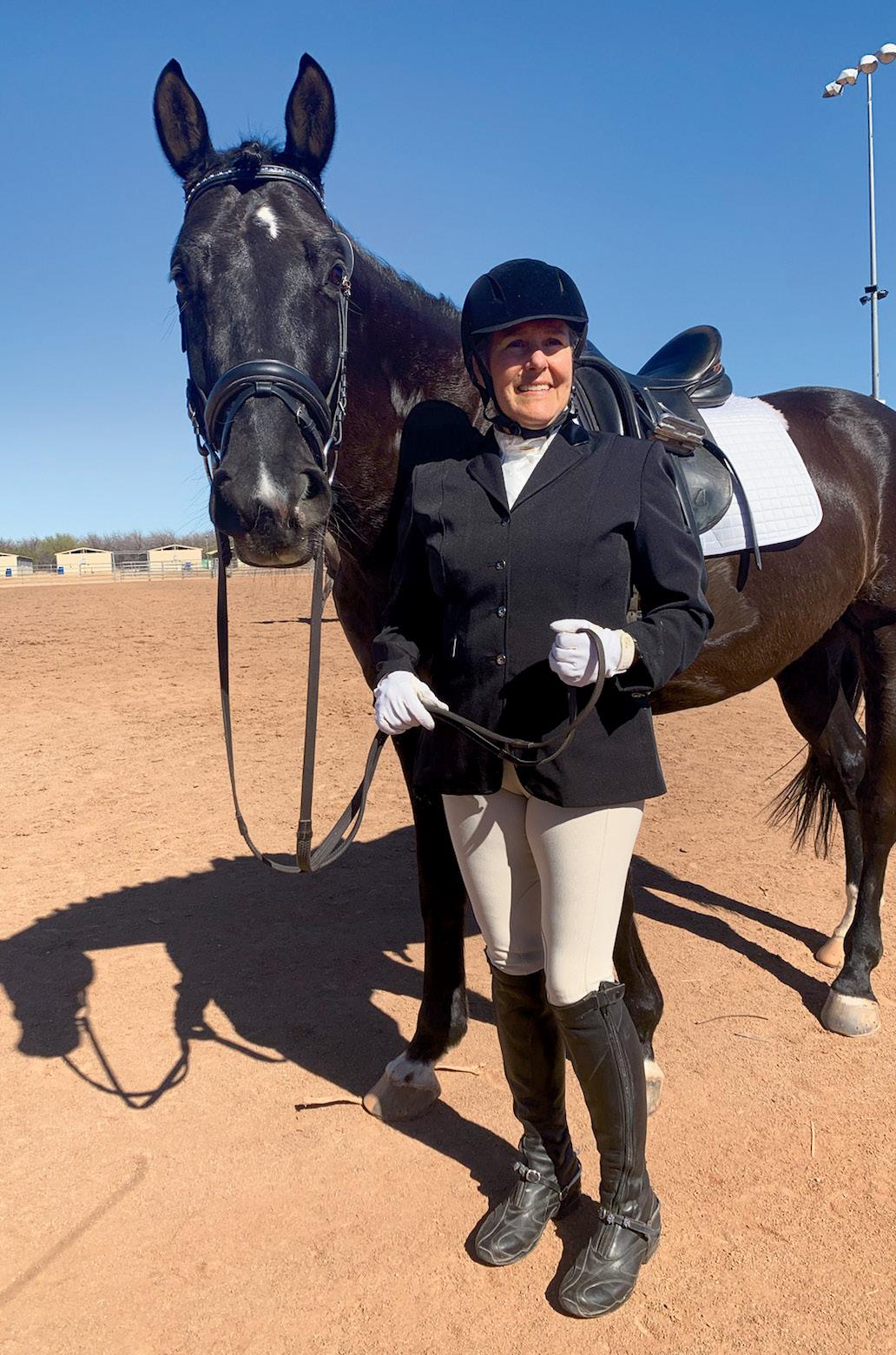
“The levels are designed so that you’re training a Grand Prix horse,

and I didn’t really understand that,” says Parmentier, who has brought her Polish Warmblood, Tango-S, to Fourth Level from a four-year-old, going “through every test and every level” in the process.
Parmentier got the dressage bug at 15, when she worked with a trainer who was short-listed for the Olympic team, which gave the girl the opportunity to groom for her coach at US Equestrian Team Foundation headquarters in Gladstone, New Jersey. Later, Parmentier purchased a Quarter Horse named Dundee and moved to Colorado, where she rode with dressage pro and judge Janet “Dolly” Hannon.
“I learned a ton working with Dolly,” Parmentier says.
Parmentier has also learned the value of schoolmasters—welleducated dressage horses, but ones that aren’t necessarily easy to ride. When she moved to Phoenix to take the job at Arizona State, she began riding at Central Arizona Riding Academy with Ulrich Schmitz and
Dorie Vlatten-Schmitz, who allowed her to show their schoolmaster, Bennigan, through Intermediate I.
“Bennigan was not always round, but I learned a ton on him,” Parmentier says.
Dressage can be hard work, but New Mexico-based amateur rider Holly Dietz, DVM, has learned that if the fun goes out of it for horse or rider, then the pair is on the wrong path.

“It still has to be enjoyable. If you drill them too much, it becomes no fun, and that’s when injuries occur,” says Dietz, a former reproductivespecialist veterinarian for the Albuquerque- based sport-horse breeding facility Horses Unlimited.
Instead, “The key is to get a little bit every day, and every time you ride ask for a little bit more,” she says. “It has to be fun.”
Dietz, who has ridden reiners and jumpers during her lifelong involvement in the horse world, has
brought several horses up the levels in dressage, has won numerous Great American/USDF Regional Championship titles, and most recently has shown her Hanoverian mare, Daxia, at Intermediate I.
Training a horse is “all about the little things,” says Dietz. “It’s all about the forward and the connection. It takes time to develop that, but then the rest comes easy.”
Studying the judges’ comments on her test sheets has helped Dietz to learn and likewise to improve her scores. She calls showing an important part of the dressageeducation process because it “gives you critiques about what they saw, and then you realize what the details are that you need to work on. For example, when they comment about the hind end being out, or comment on shoulder-in [being] one-track to the inside, you start to connect the judges’ comments to feel….I love going back and looking at my test at
the end, and I’ll think, ‘Oh yeah, I felt that.’”
Above all, dressage veterans say they wish they’d understood the importance of patience in developing themselves as riders and their horses as willing, capable partners. They would strive not to let an educational opportunity slip by, and they would value their own horsemanship instincts and also pay closer attention to what their horses are trying to tell them.
Emily Esterson is the author of The Ultimate Book of Bits and writes about horses for various publications. She is an eventer and a dressage enthusiast who competes her Connemara cross, Rivendell’s Olive Lucy.

 BY JUDY NAUSEEF
DEVASTATED: Massive wind-driven rains from a severe storm flooded arenas and toppled structures at the Great Lakes Equestrian Festival grounds in Traverse City, Michigan, in August 2021, on the eve of that year’s FEI North American Youth Championships dressage competition
BY JUDY NAUSEEF
DEVASTATED: Massive wind-driven rains from a severe storm flooded arenas and toppled structures at the Great Lakes Equestrian Festival grounds in Traverse City, Michigan, in August 2021, on the eve of that year’s FEI North American Youth Championships dressage competition
Severe weather and natural disasters don’t happen only when people are at home. Sometimes Mother Nature unleashes her wrath when people and horses may be especially vulnerable: at a dressage show.

“I have had a tornado or microburst hit Ox Ridge Hunt Club [Connecticut] on Friday evening before a weekend show,” says longtime competition manager Debra Reinhardt, a Connecticut native who now resides in Loxahatchee, Florida. “Hurricane Floyd hit in the middle of the USDF Region 8 Championships/NEDA Fall Festival in Massachusetts. I have had six inches of rain drop in an hour, and there was a major thunderstorm during last year’s Regional Championships.”
At the 2021 FEI North American Youth Championships (NAYC) at the Great Lakes Equestrian Festival (GLEF) grounds in Traverse City, Michigan, a forecast storm the eve of the dressage competition struck with unexpected intensity. Torrential rain turned arenas into lakes. High winds toppled judges’ boxes, uprooted trees, hurled the jumbotron into one of the rings, and shredded the VIP tent. The facility lost power and water. Thankfully, no one was hurt, and after a postponement the competition went off as planned.
In the last issue, we gave you tools to help you to be weather-aware and prepared in the event that severe weather or a natural disaster affects your farm or equestrian facility (“Prepare for the Worst,” July/August). Now let’s turn our attention to what show management and competitors can do when nature’s worst bears down on a dressage show.
Dressage competitors may tend to think of show management as the people who process the entries, hire the officials, oversee the stabling, and hand out the ribbons. But the manager’s job carries a great deal more responsibility than that.
During severe-weather events and other situations, it is show management that must prepare, act, and make decisions that could potentially affect the safety of everyone at or traveling to the show grounds. Those events, as we discussed in the last issue, range from from hurricanes and floods to tornadoes, wildfires, derechos and straight-line winds, thunderstorms, blizzards, ice storms, and dangerous air quality—such as that resulting from the smoke from Canadian wildfires that had already affected much of the US as this issue was preparing to go to press. [
There can be challenges even under “normal” weather conditions, such as what Reinhardt, who also manages the annual US Dressage Finals in Kentucky, terms the “four seasons in four days” phenomenon, with rapidly changing conditions that have forced show officials to deal with summerlike temperatures one day and, 48 hours or so later, freezing arena footing and slippery conditions from sleet and snow.
When a severe storm devastated the grounds at Traverse City, Michigan, in August 2021, the community banded together to ensure that the show would go on for the kids at the 2021 FEI North American Youth Championships. Read the full story at yourdressage.org/2021/09/01/ persevering-through-the-stormthe-2021-fei-north-american-youthchampionships/.
The US Equestrian Federation (USEF), our country’s equestrian national governing body, produces an Incident Response Resource Guide (downloadable at usef.org) for those who manage USEF-licensed competitions. The guide makes a passing reference to severe weather but is geared toward equine and human accidents and other such issues, Reinhardt points out.
“USEF does not give us specific instructions to follow in cases of environmental disasters,” she says. USEF rules help to point the way forward, but “It is our experience that tells us what to do.”
When such a situation occurs, show managers rely heavily on team members’ experience in handling all sorts of crises, as well as their knowledge of the show grounds, input from local emergency services, and other factors.
“We are always watching the weather, and we have lightning and weather warnings on our phones,” Reinhardt says. “If bad weather is
coming, usually the show manager and safety coordinator will meet with the facility’s manager and/or footing person. We decide how to handle the footing, possible flooding, et cetera. Our primary concern is the safety of the horses and participants.”

Weather patterns aren’t 100% predictable, but show managers who know an area well are able to make some judgment calls based on their experience.
As a longtime manager of shows at the HITS Saugerties grounds in New York, Reinhardt has learned that “if a storm is coming from one direction, you are going to get hit, but if it’s coming from another it will miss you. This happens at Saugerties all the time. We have mountains around us, and there are patterns of storms which [look] really bad on the weather radar but will not hit us because of the mountains. However,” she continues, “there is one condition that, when I see it coming, I know we are going to get hit.” In such cases, “I prepare the announcer to get people back to the barns, and if I have trail-
er-ins, I find stalls. Everyone takes shelter. Once the storm has passed, we give announcements to tell riders the restart information. This is a typical scenario that happens most of the time at shows with bad weather.”
Most show managers are quick to comply with USEF’s recommendation that competition be stopped in the face of severe-weather warnings, lightning or thunder, and so on; and that it not resume until 30 minutes have passed without severe weather.
When conditions are bad enough, the competition schedule may have to be altered substantially. (There is a USEF general rule detailing the process in such cases. If in extreme circumstances USEF rules cannot be followed, show management calls an emergency USEF phone number to request permission to alter the rules as needed to cope with the situation.) Reinhardt has had lots of experience with this, too, including at last year’s Region 8 championships at HITS Saugerties.
Severe thunderstorms with flooding rains fired up the first morning of competition, and “at 7:15 a.m. I called a riders’ meeting, using my announcers and staff to get everyone there,” she recalls. After discussion and consultation with competitors, HITS personnel, and the “HITS footing guru,” Reinhardt suspended all competition until mid-afternoon, running only championship classes “in the rings that HITS knew would be the best.” But after the storms passed, “the rest of the weekend ran smoothly!”
Pulling off such huge changes requires constant communication among show management, staffers, volunteers, officials, and competitors—lots of announcements and e-mail and text messages regarding schedule changes, ring changes, or other necessary rules-bending—such
Here’s a list of disaster-preparedness resources mentioned in this article, plus a few more that show management and dressage competitors can use to stay as safe as possible during the show.
AirNow (airnow.gov): Enter a ZIP code, city, or state in the search box to get air-quality information for that locale. In response to the recent air-quality issues in the US caused by Canadian-wildfire smoke, the US Equestrian Federation (USEF) promoted the use of the AirNow site and “strongly recommends, in situations where the Air Quality Index (AQI) reaches 151 or above, that an organizer consider suspending or cancelling competition.”
Equine heat-stress resources: Horses are susceptible to heat-related illness. This resource from SmartPak includes information on deciding when it’s too hot to ride and tips for treating heat stress and heat stroke in horses: smartpakequine.com/learn-health/horse-heat-stress-stroke.
US Environmental Protection Agency (epa.gov): Covering a wide range of topics including air quality, climate change, and others. The Emergency Response section (under the Environmental Topics drop-down menu) contains a “Citizen’s Guide for Natural Disasters,” with resources, infographics, and tips for hurricane preparedness.
US Equestrian Federation Incident Response Resource Guide: usef. org/forms-pubs/dAplsHf4KcY/sample-incident-response-manual-for. Appendix F (Resources) contains a list of weather websites, such as the National Weather Service and the National Severe Storms Laboratory.
Wet Bulb Globe Temperature: The WBGT is considered a more accurate index of heat-related stress than the commonly used heat index. While the heat index measures the combined effects of temperature and humidity, the WBGT also factors wind speed, sun angle, and cloud cover. The Fédération Equestre Internationale (FEI) uses the WBGT, which in 2018 was the basis for its calling off the remainder of the endurance competition at the 2018 FEI World Equestrian Games in North Carolina. Find the US National Weather Service’s WBGT maps at digital.mdl.nws.noaa.gov; select Wet Bulb Globe Temperature from the drop-down menu.
as at the 2022 US Dressage Finals, when on a freezing-cold day “we spoke to the judges to get them on board with our decision to allow riders to wear winter jackets in the outside [competition] arenas,” Reinhardt says.
“Communication is important!” Reinhardt stresses. “Getting the riders involved is a huge deal” and helps competitors to “take ownership of the decision,” she says.
If anyone is the master of the disaster-preparedness pivot, it’s the dressage-show manager.
These intrepid professionals are in charge of large athletic competitions held at all times of the year, all over the country, almost always outdoors and in all sorts of weather, with competitors and officials often traveling great distances by road or air to show grounds that may or may not have decent cell-phone service— what could possibly go wrong?
Show management hopes for the best but prepares for the worst, and even then veterans have learned to expect the occasional curve ball, “like the tornado that was not predicted at all” at the Ox Ridge grounds, says Reinhardt. “In all cases, you have to know your show
If severe weather or another crisis strikes the show grounds, the number-one rule is to pay attention to announcements and to comply promptly with instructions. If you’ve been ordered to take cover and you’re a trailer-in, put your horse on the trailer and then get inside your vehicle. If the competition is stopped for lightning, stay away from metal or conducting materials.
The disaster-preparedness tips presented in the last issue of USDF Connection (“Prepare for the Worst,” July/August), such as keeping mobile devices charged and installing weather apps, apply to competitors at show grounds, too. Here are a few additional preparedness measures that competitors may want to consider.
• If the show is not in your hometown, set your weather app to the show’s location when you arrive, if the app doesn’t update your location automatically. Be sure that weather notifications are enabled.
• Think ahead: In the event of heavy rain, would your truck and trailer be likely to get stuck in the mud? If you can, park on higher ground.
• If you’re stabling overnight, refuel your towing vehicle promptly after you arrive.
• Would your hay and bedding be ruined if the stabling area flooded? Tarps and pallets will help keep supplies off the ground and dry.
• Keep horses’ water buckets filled in case of a power outage.
• If a storm bears down, stow portable chairs, folding saddle stands, and any other lightweight items that could become projectiles.
• Pack a variety of clothing for humans and horses in case it turns hotter, colder, or wetter than anticipated.
• Fill out stall cards on arrival, preferably in permanent ink.
• If you don’t think the footing, air quality, or other conditions are in the best interests of your health or your horse’s, you don’t have to ride your test. (Just please let the secretary know you’re scratching.)
grounds, the footing, and the staff and their specialty.”
Those who have endured severe weather at a dressage show say that getting through the ordeal truly takes teamwork—not just on the part of show management, but from the volunteers, the grounds crew, the officials, and the competitors. Fortunately, the dressage community is famous for pulling together in times of crisis.
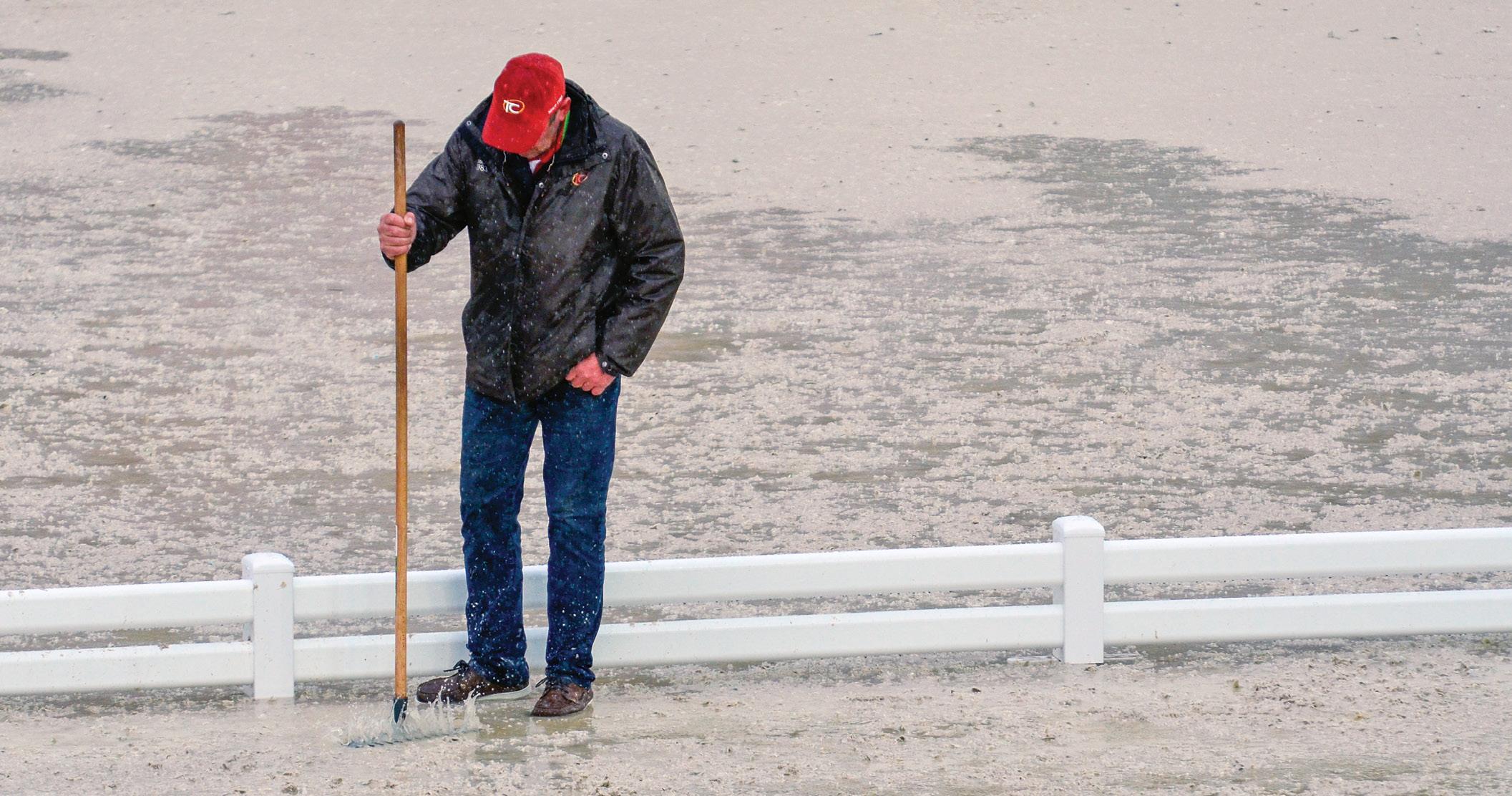
After the devastation at the 2021 NAYC, “The entire staff at GLEF came together to ensure the competition could continue…and had the rings up and running in just under three hours,” USEF dressage staffer Laura Roberts told YourDressage. org at the time.
For dedicated dressage supporters, coping with whatever Mother Nature dishes out is all in a day’s work.
Judy Nauseef is a freelance writer interested in equestrian and gardening topics. She lives on an acreage with her husband, two horses, one dog, and many gardens. Find her at JudyNauseef.com.
Show your support to competitors and event staff as a US Dressage Finals Hospitality Sponsor! Hospitality Sponsors will receive valuable onsite exposure to over four hundred of the top competitors from around the country, as they compete at this showcase event.
Hospitality Sponsorships are available starting at $1,000. Hospitality Sponsors will receive exposure in the event program and through onsite signage at hospitality events throughout the week. Additionally, Hospitality Sponsors have the opportunity to include a promotional gift item in the competitor gift bags. Items must be received by USDF no later than October 13, 2023 to be included in the competitor gift bags.
For more information about Hospitality or other sponsorship opportunities, contact:
Ross Creechrcreech@usdf.org
(859) 971-7038
Support the US Dressage Finals by making a tax deductible gift. Patron gifts will be recognized in the event program, the yearbook issue of USDF Connection, and receive a commemorative gift of appreciation.
Patron levels of giving are:
• Platinum $2,500+
• Gold $1,000 - $2,499
• Silver $500 - $999
• Bronze $250 - $499
• Friends < $250
Gifts received after October 11, 2021 will not be recognized in the event program.
usdressagefinals.com
For more information please contact us at donate@usdf.org or (859) 971-7826
During the 2023 Adequan®/USDF National Convention, November 29-December 2, the USDF Board of Governors will elect three USDF members to serve as atlarge directors, who are members of the USDF Executive Board.
The at-large director (ALD) positions represent USDF’s three councils: Activities, Administrative, and Technical. Classified by type of USDF activity, each council comprises several USDF committees. The Activities Council includes the Adult Programs, Awards, FEI Youth, National Youth Programs, Regional Championships, and Sport Horse Committees. The Administrative Council is the “umbrella” for the Bylaws, Group Member Organizations, Historical Recognition, and Nominating Committees. The Technical Council comprises the Competition Management, Freestyle, Instructor/ Trainer Development Program, Judges, L Program, and Technical Delegates Committees.
The incumbent Activities Council ALD, Sue Mandas, is running unopposed for reelection. Incumbent Technical Council ALD Sue McKeown is also running for reelection; she faces one challenger, Janet Foy, for her seat. And the Administrative Council ALD, Barbara Cadwell, is running against challengers Anne Snipes Moss and Cindi Rose Wylie as she bids to retain her seat.
Like all organizations, USDF needs committed leadership in order to enjoy continued growth and thoughtful direction. The USDF Executive Board functions as a cohesive team and strives to further the
organization’s mission and goals. For the 2023 election cycle, the USDF Nominating Committee asked each ALD candidate to submit a brief biography and to answer a series of questions. Those questions are:
1. Why do you wish to run for atlarge director?
2. If elected, what do you wish to accomplish?
3. With so many diverse committees within your council, how will you support and represent each committee chairperson on the Executive Board?
4. How has your involvement in local, regional, and national USDF activities promoted and enhanced dressage, both regionally and nationally?
Read on for the candidates’ biographies and responses.
Incumbent: Sue Mandas

focusing and specializing in dressage. I have been involved in the sport of dressage for over 50 years, as a competitor, trainer, instructor, and judge. It’s an addiction, really! I have earned my USDF bronze, silver (bronze and silver “with distinction”), and gold medals, as well as silver and gold freestyle bars, all on horses I have trained. My first Grand Prix horse I also bred. I have been champion or reserve at every level from Second through Grand Prix at Regionals, including some before they were Regionals, and made the US Equestrian Team long list twice. I became a judge in 1991 and am currently a US Equestrian (USEF) “S” dressage judge, an “R” sporthorse judge, and a member of the USDF Sport Horse faculty. I joined USDF when it was created and attended my first USDF convention in 1978 in Milwaukee. I have been a member of the USDF Sport Horse Committee since 2004 and currently live in Centerville, Ohio, where I train and teach. I enjoy traveling around the country judging and teaching clinics. I cannot imagine a life without horses!
1. Because I feel I can bring a voice to the Executive Board that represents the committees on the Activities Council.
2. I hope to continue to facilitate communication and the sharing of ideas.
Having been blessed with the world’s best parents (my dad was an “S” dressage judge), I began as a child riding saddle seat, then hunter/jumper, then eventing before
3. With equal respect and consideration to the mission and goals of each.
4. I have been involved at local, regional, and national levels as a
trainer, competitor, coach, and judge for over 50 years. I have conducted many USDF continuing-education programs and benefited from attending many USDF symposiums, Trainers Conferences, and judges’ clinics, which in return has benefited my students and competitors. I am proud to have been a part of the emphasis USDF places on education and rewarding accomplishment, which I feel has enhanced the lives of all participants in the sport of dressage.
Incumbent: Barbara Cadwell

Bylaws Committees.
• Become an L program graduate.
• Bred multiple horses that have earned regional and national recognition. One, Freedom, is a successful Grand Prix competitor with rider Patti Becker and has qualified for the U25 Grand Prix with Alexander Dawson.
• Been active in multiple GMOs in two regions.
• Served and continue to serve on the board of The Dressage Foundation (TDF).
• Sponsored multiple competitive horses, including Freedom and Hope of Rania.
• Served as the USDF’s Administrative Council at-large director.
Responses to questions:
1. Service is a tradition in my family. COVID has presented challenges to our sport. As we emerge from its shadow, I am uniquely qualified to continue to serve the USDF as Administrative Council director.
and teaching sidesaddle. Her background is in Pony Club (graduate “A” from Huntingdon Valley Hunt PC), Western equitation, gymkhana, pleasure driving, eventing through intermediate three-day, Grand Prix dressage, sidesaddle (USDF bronze and silver medals riding sidesaddle), and foxhunting. She is a retired practice manager for her husband’s Brandywine Valley Veterinary Hospital for the past 25 years.
I went to my first dressage show as a spectator in 1962, ten years before the USDF was founded. It was one of Bodo Hangen’s first competitions in this country, and Kay Meredith was riding Blue Jay.
Since then I have:
• Received my USDF bronze and silver medals.
• Attended most USDF conventions, usually as a GM or PM delegate.
• Been a member of the Group Member Organizations, Bylaws, and Nominating Committees, and assisted my mother on the Historical Recognition Committee. I continue on the Nominating and
2. The Administrative Council provides the structure through which the USDF expresses itself as an amazingly democratic organization. My history of service to the USDF and dressage, as well as my legal training and experience, help the committees function.
3. As a result of my current and past involvement in each committee and my long history with the USDF, I am able to represent these committees and communicate their needs.
4. My involvement in local, regional, and national activities promoting dressage speaks for itself.
Candidate: Anne Snipes Moss Anne lives with her husband, John, in Coatesville, Pennsylvania, with two dogs and four horses. She enjoys many horse sports, especially riding

As a young woman, Anne was given the chance to teach local Pony Clubbers, which blossomed into a lifelong passion for sharing the joy she has found with horses with others and running a riding school for five years. The ladder of learning that she was introduced to in Pony Club has continued to this day and fuels her passion to improve herself and those around her.
Hobbies include: pottery, horticulture, historical reenacting (Civil War, Wild West, and Rendezvous), trail riding, open-hearth cooking and baking, traveling, and volunteering. She loves to organize USDF L programs, USEF judges’ programs, and USDF sport-horse seminars.
Anne’s record of service on nonprofit boards and committees includes president of Dressage at
Devon, Delaware Valley Combined Training Association past president, US Pony Clubs national examiner and NE Committee, USDF Historical Recognition Committee, past member of the USDF Sport Horse and Freestyle Committees, International Side Saddle Organization, Cochran Hunt Board.
She is a USEF “R” dressage and Western dressage judge and an “r” sport-horse judge.
Responses to questions:
1. I love USDF and think it has so much potential to improve understanding of dressage principles and riding at all levels, and more important, to improve the quality of life and training for horses. USDF has done a great job of educating lower-level riders and judges with the L program. It is time to expand this concept beyond Second Level and activate the USDF Instructor/ Trainer Development Program to support the needs of the riding community with excellent instruction.
2. To enable more educational programs for riders, instructors, and judges in each region; develop a financial support system for recognized shows to hire more judges for panel judging; and expand membership outreach to build a larger dressage community.
3. I have been a member of all of the branches of USDF: Activities Council (Sport Horse Committee), Technical Council (Freestyle Committee), and Administrative Council (Historical Recognition Committee). I have a cosmic view of the organization and experience within the Administrative Council over the past two decades. My goal is to attend the Administrative Council’s committee meetings and to stay current with chairs’ concerns and challenges, and
bring those issues forward to the Executive Board.
4. I have participated as a member of many GMOs and their activities over the past 20 years. I have organized or co-organized L programs, an “S” program, camps, freestyle programs, clinics, and quadrille exhibitions. As president of Dressage at Devon, I am committed to enhancing the opportunities for up-and-coming FEI riders and educational programs for the larger Mid-Atlantic dressage community.
Candidate: Cindi Rose Wylie
fied instructor (FEI B), and a USDF bronze, silver, and gold medalist with distinction on self-trained horses. I owned and ran a large training operation in Georgetown, Massachusetts, but recently downsized due to time constraints. Currently I teach locally, give clinics, and judge. I live in Florida with my husband, Steve Schubert. We have four adult children and a beautiful granddaughter.
My participation in GMO programs led me to volunteering. It started with my participation on an adult team. Over the years I managed shows and ran clinics, camps, large symposia, and fundraisers. I was elected to the GMO’s board and was a GM delegate at the USDF convention. My first convention was in the late 1990s. I’ve also been a PM delegate for years, served on standing committees, was chair of the Certified Instructor Subcommittee, and have many years on the Group Member Organizations Committee, which I currently chair.
I was born and raised in Massachusetts by two fabulous but non-horsey parents. I started dressage lessons at the local riding school at 16 and got hooked. I graduated Tufts University with a degree in clinical psychology, later working in social services and corporate settings, in positions where I helped people with my listening, problem-solving, and goal-setting skills. I was also a working student when time allowed.
By the time I was 30, I was being offered money to ride people’s horses. Ultimately, I became a full time trainer/instructor. Thanks to GMO educational offerings and support, I’m a USEF “S” judge, a USDF-certi-
1. I feel I could be helpful in problem-solving issues that PM and GM membership and organizations are facing, as well as in helping to identify ways to further promote the growth of dressage in the US.

2. I wish to help develop ways to get more people involved in dressage at local levels, and develop better support systems for those climbing up the levels. I would like to help improve communications between the Executive Board, the committees, and the membership.
3. Using listening and problemsolving skills to help conduct our meetings, and ask the questions that help the committees think together, utilizing their diverse collective experience, and come to conclusions as
a group. I will rely on my communication skills to bring the important points from our meetings to our Executive Board meetings.
4. Locally, I’ve volunteered for or managed fundraisers, adult/ youth camps, certified-instructor programs/testings, clinics, lectures, volunteered at shows and judges programs, and organized large symposia. Nationally, I’ve been a USDF Board of Governors PM and/or GM delegate for many years. Currently I chair the Group Member Organizations Committee. We updated the GMO awards and roundtable programs, created/implemented a recognition program for local-level volunteers, and helped reinstate the GMO educational sessions. I participated on standing committees for the National Education Initiative grant and the Schooling Show Recognition Program. As a rider and trainer, I also volunteer at educational and charity events as a volunteer, clinician, or demo rider, to help promote the sport.
Incumbent: Sue McKeown

secretary and manager, as well as by serving on the USDF Executive Board. I earned my bronze, silver, and gold medals on my two Swedish Warmbloods and truly enjoyed all aspects of training and showing as an adult amateur. I have been a secretary and/or manager for more than 100 shows in the New England area, as well as manager and secretary of the Region 8 Championships and assistant show secretary for the US Dressage Finals. I got involved with USDF first as a participatingmember delegate, then as a member and later chair of the Competition Management Committee. I have served two three-year terms as the Technical Council at-large director. As ALD I have focused on supporting the committees, which is where the real work of USDF is done, and on working with the committee chairs to help them with their jobs. I truly enjoy the dressage community and love being involved at all levels of the sport.
Responses to questions:
1. I want to help and to be part of the future direction of dressage in the United States. I think the way to do that is to represent the committees that are part of the Technical Council on the Executive Board, but also to bring my varied expertise in management and strategic planning to the board.
3. Listening to and understanding the issues of each committee would be key. I would attend as many of their calls and meetings as possible, and discuss with the chairperson any specific concerns they would want taken to the other councils and the Executive Board.
4. I have managed and been secretary for more than 100 recognized dressage shows in the New England area and in Virginia. As chair of the USDF Competition Management Committee, I have organized and helped to teach training sessions at USDF conventions. And I have volunteered at many schooling shows in our region, to encourage growth in dressage starting from the lowest levels.
I have been involved with dressage for over 40 years, first as a competitor and then as a competition
2. I would like to continue to see more shows across the US be well run and managed, and bring the ideas and practices of one area to the visibility of other areas. This would include focusing on meeting the needs of competitors, officials, show management, and the USDF and USEF. I would like to continue the meetings between committee chairs to help with their education and jobs.
Janet is a FEI 5*/Level 4 dressage judge and a US Equestrian (USEF) Senior (“S”) judge. She is a USDF bronze, silver, and gold medalist.
Janet has judged all the major competitions in North America, including several FEI North American Young Rider Championships. She was on the panel for the FEI World Cup Dressage Final in Paris and served as president in Omaha 2023. She judged the Pan American
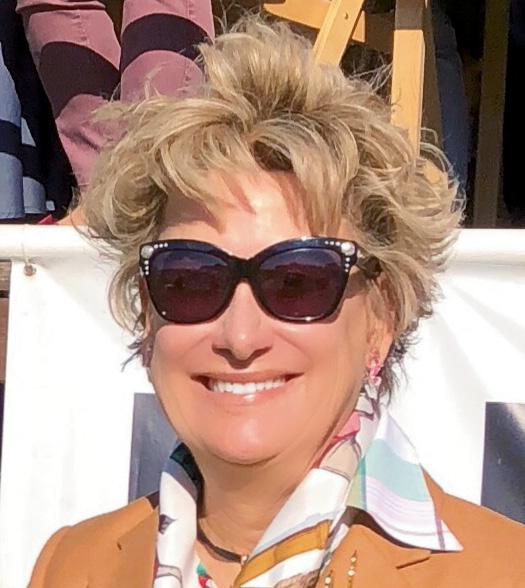
Games in Lima, Peru, and will be the FEI technical delegate (TD) for Santiago, Chile, 2023. Janet judged the 2020 Tokyo Olympic Games, the 2019 European Championships, and the 2018 European U25 Championships, and was the FEI TD for the World Dressage Championships in Herning 2022. She has judged the Bolivarian Games and the Central American Caribbean Games. Janet has done extensive judging in Europe, South America, Australia, and Asia.
Janet is a former member of the Board of Directors for the American Horse Shows Association, USA Equestrian, and the USEF, and served on the International Disciplines Council. She has been a 30-year member of the USEF Dressage Sport Committee and was chair of the High Performance Committee. She is a retired member of the USDF “L” program faculty. Janet is the first vice president for the International Dressage Officials Club.
She has been a volunteer and officer with her GMO and is also a former USDF Region 5 director. She has served on the USDF Competitors, Judges, Young Horse, Test Writing, and Sport Horse Committees; and she chaired the University Committee. Janet has also managed Regional Championships and CDI competitions in Region 5.

Responses to questions:
1. I have served USDF in many capacities and am excited for several projects the board has been developing. I am in a good position now to have the time and to use my expertise to help see these projects through to fruition.
2. I would like to see better communication and shared education among judges, competitors, and
instructors. Having been a judge instructor for the FEI and US and also a coach and trainer to the top levels, I think I have a unique background to see these projects through to a successful launch! Dressage will only grow and succeed in our country if all stakeholders have shared goals and exposure to top educational opportunities. USDF can provide this with the correct leadership.
3. I have been involved in committee work for USDF and USEF for 30 years. I have become a good listener and feel I am a good communicator. The key is finding the right priorities for each group and then a pathway for success in the organization.
4. I have been a volunteer for my GMO and for USDF, and have chaired the USEF High Performance Committee. I am a past show manager, including of CDIs. I have been involved with every aspect of the horse world and the dressage world for 40 years. I also have vast knowledge of dressage around the world. I have seen the good and bad in Europe, eastern Europe, and Central and South America.
I am the first vice president for the International Dressage Officials Club and am its North American board member. I have run judges forums internationally and would love to have seminars at top shows for riders, breeders, and judges. All stakeholders need to be brought into this orb of education.
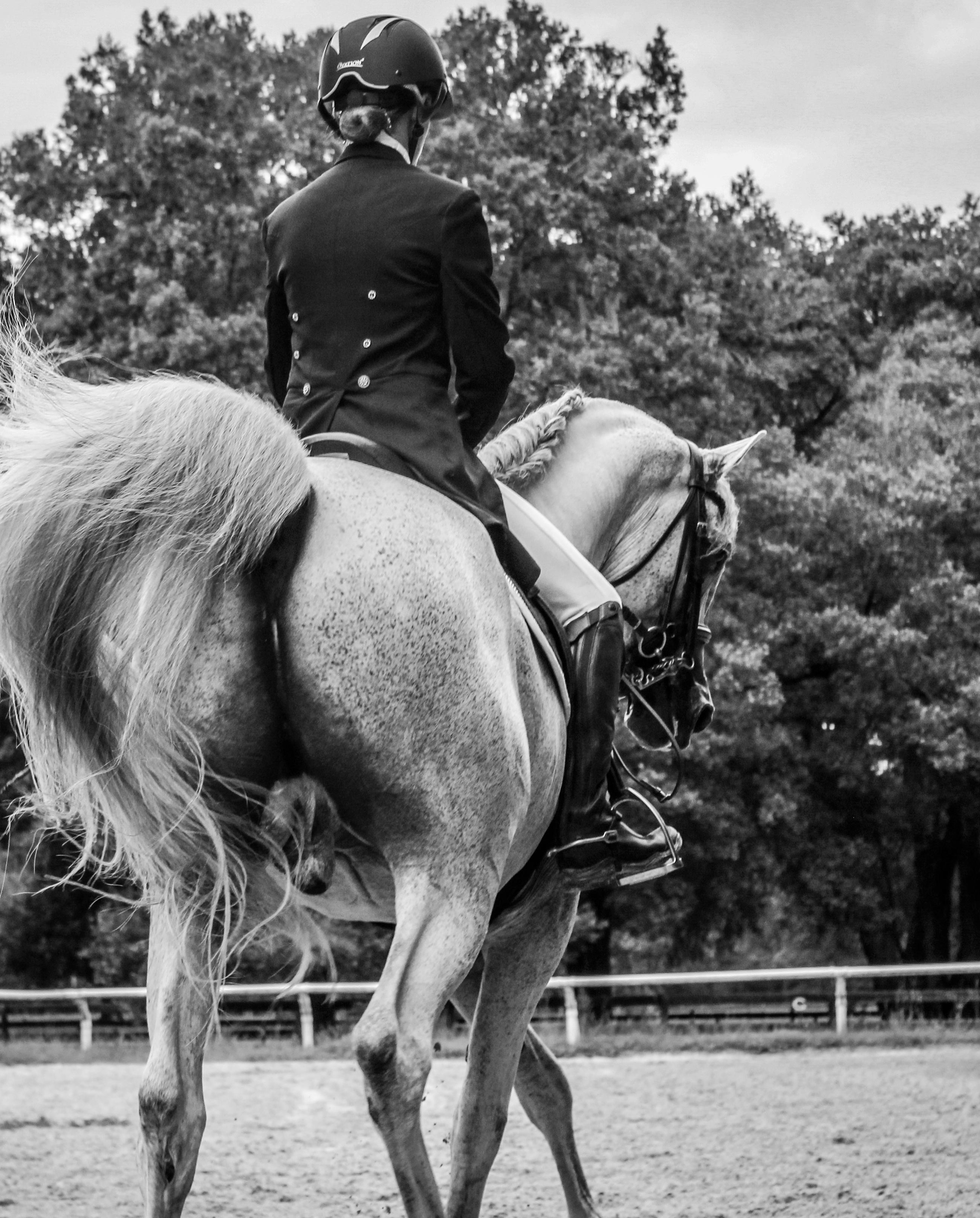
Who better to design products for equestrians than equestrians themselves?
Two USDF members are aiming to shake up the riding-apparel market with their new clothing brand, Canter Culture.
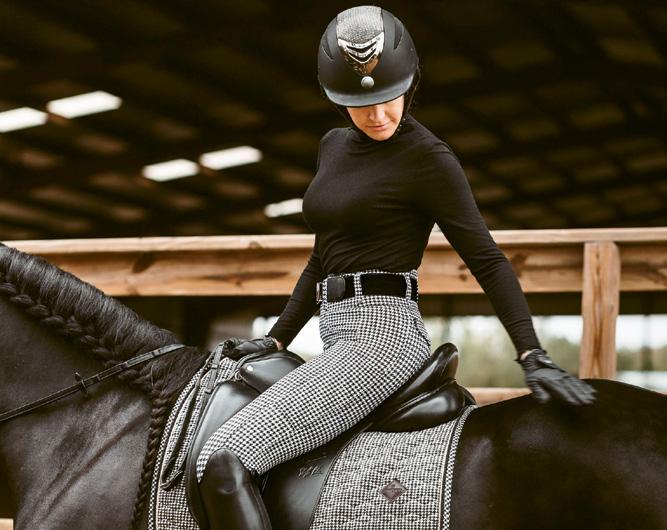
colors or in distinctive prints and patterns, including houndstooth, polka dots, and a leopard print. Learn more: CanterCulture.com.
With much of the US suffering from extreme drought, water conservation has become an urgent need in many areas. Yet there has been little alternative to the water-wasteful traditional method of bathing horses and pets; plus, bathing a horse in the wintertime isn’t feasible in many locales.
damp to the touch, which speeds drying time. Many horses that dislike being sprayed with water enjoy the Anivac’s gentle action, and you won’t be as wet as your horse by the time you finish. The Anivac is used in animal shelters and by groomers on dogs and cats, too, often along with OgenaShield Pure Oxygen Shampoo.
Learn more: OgenaSolutions.com.
Created by a rider, Eques Pante is a revolutionary equestrian undergarment designed to be worn from the gym to the saddle.
Adult-amateur rider Sarah Dahlberg and dressage pro Lauren Baggett launched their line earlier this year with the Canter Culture Athletic Breech. The breech/ridingtight hybrid is made from high-end, soft athletic compression fabric, featuring a pull-on design yet all the detailing of a traditional breech. The fabric is moisture-wicking, quick-drying, and antimicrobial. For great looks and functionality, the Athletic Breech has a high and wide waistband, two large side phone pockets, two-inch belt loops, and a silicone grip full seat. Most fun of all, you can set yourself apart from the arena crowd in an array of solid
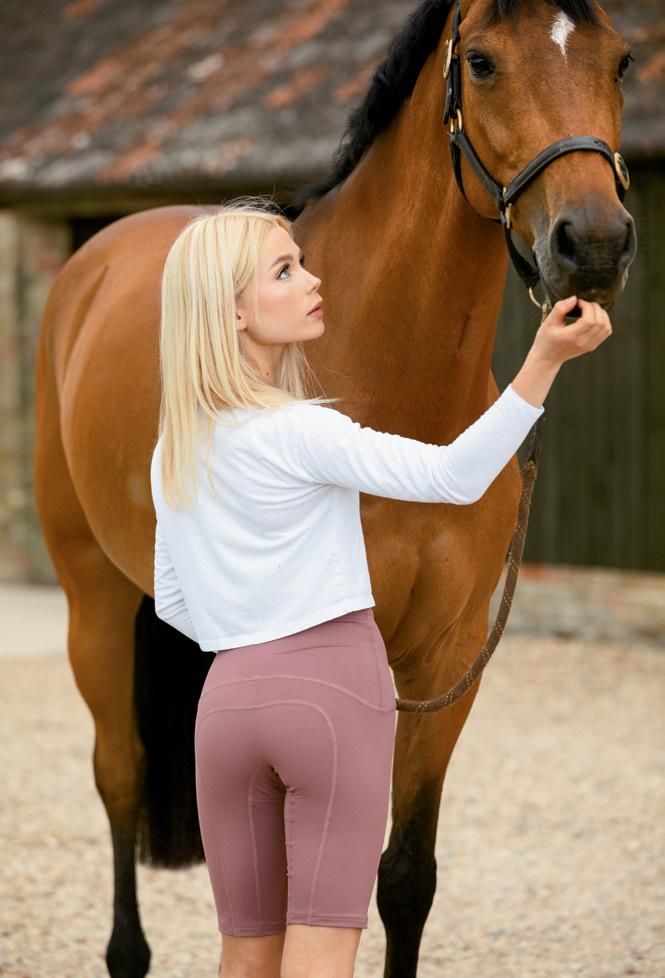
Enter the Anivac 3.5 Animal Bathing System. Manufacturer Ogena Solutions claims its system uses 90% less water than traditional bathing—as little as three gallons per horse—while actually getting the animal cleaner and in less time.

The Anivac cleans from the skin up instead of from the hair down, thanks to special comb-like wash nozzles that flush fresh shampoo solution directly onto the animal’s skin to dislodge dirt, scurf, and loose hair. The vacuum wand with adjustable suction removes dirty water and debris from the coat, ensuring a deeper clean and a nearly mess-free bathing area. The haircoat is left just
The versatile, US-made knickers are made from a specially designed moisture-wicking, breathable, quick-drying performance fabric that even works to keep you cool in the saddle. With a patented seamless gusset area, it’s invisible under breeches (or street clothes),

protects against chafing, and helps to slim and support. The proprietary performance textile is sustainably made. Eques Pante is also designed to be worn on its own as an exercise garment. It’s available in sizes XS to XL and comes in a variety of colors (we’re told the gray works well under white breeches).
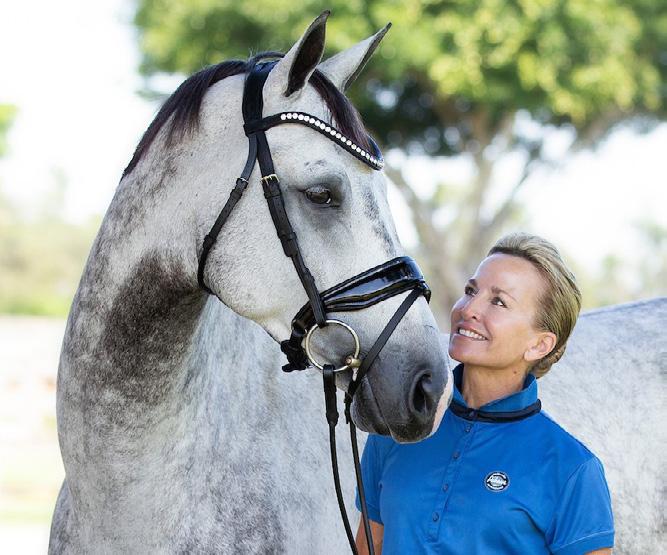
Learn more: EquesPante.com.
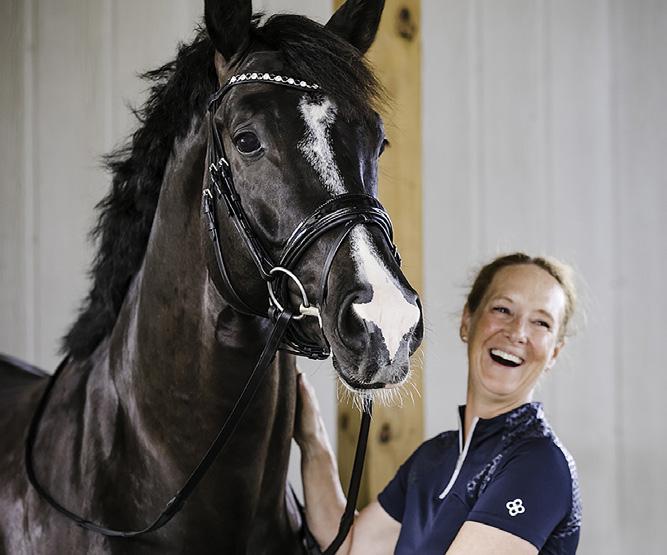
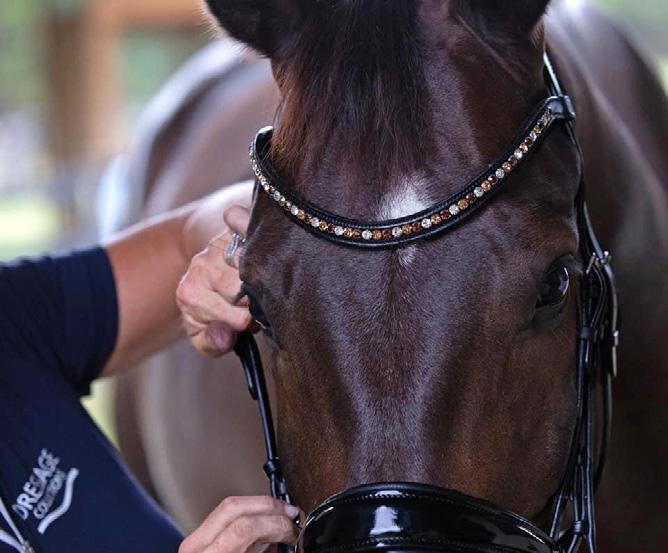
Ohio-based USDF FEI B certified instructor/trainer Jennifer Truett and her engineer husband, Dr. Lenny Truett, were working to de sign a sturdy, safe, mobile hay floor feeder for her FEI dressage horse, to mimic horses’ natural grazing stance and to avoid the potential neck torquing and hay waste that may
accompany wall-mounted slow feed ers. Their problem was solved when they discovered that someone had already created the better mousetrap they were seeking—and now the Truetts own the company.

It’s called Savvy Feeder. Weighing 25 pounds, it’s light enough to be portable but hefty enough not to tip over in the wind. It won’t freeze to the ground and has excellent drainage. The poly material is kind to horses’ teeth, lips, and gums. The feeder grate is designed to flex


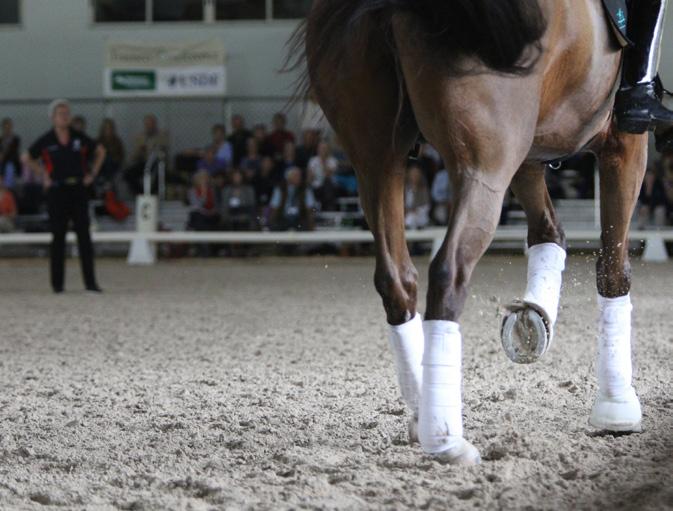
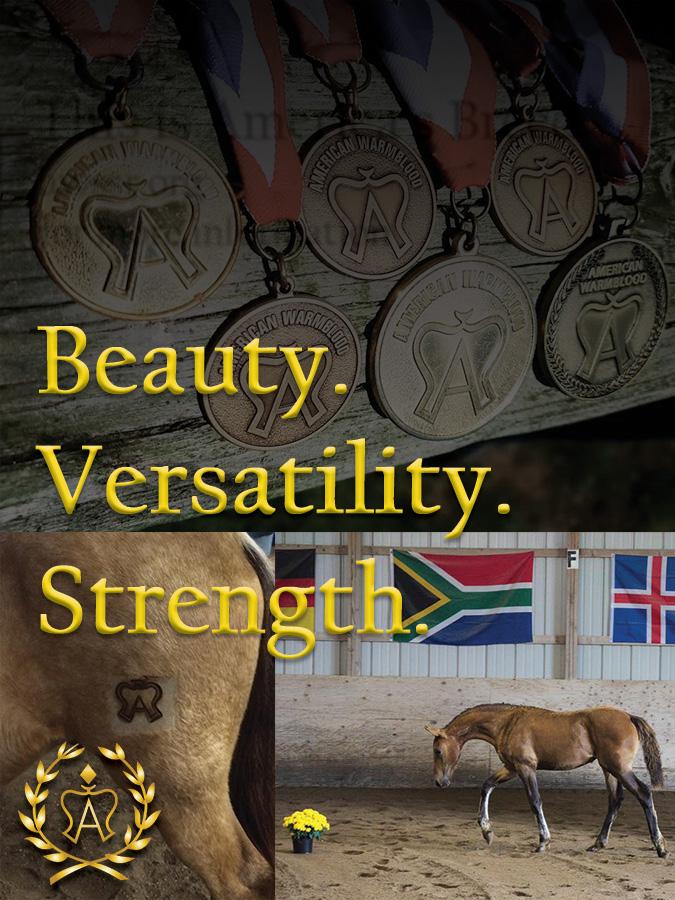










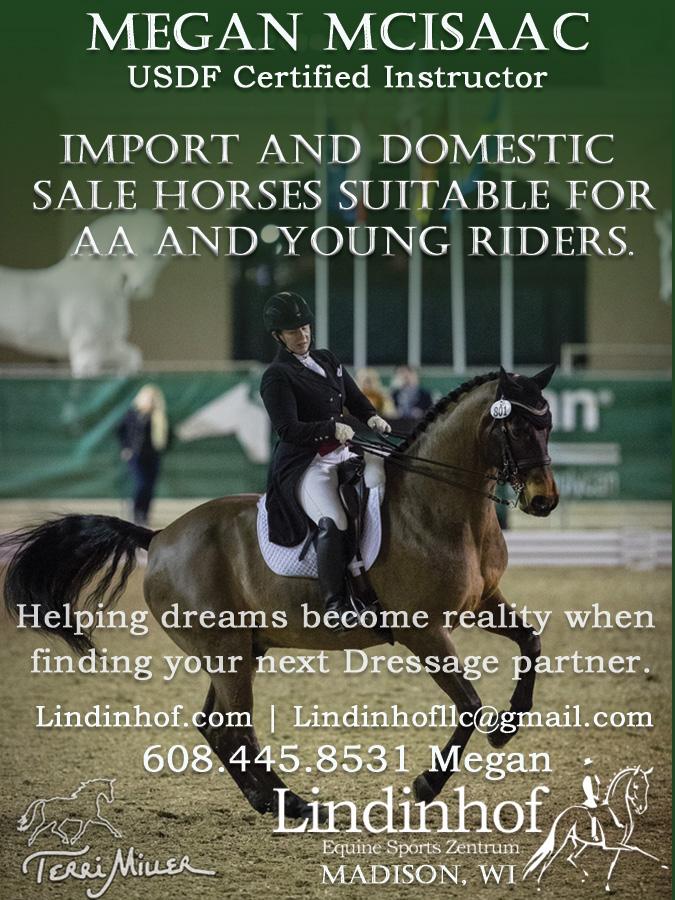


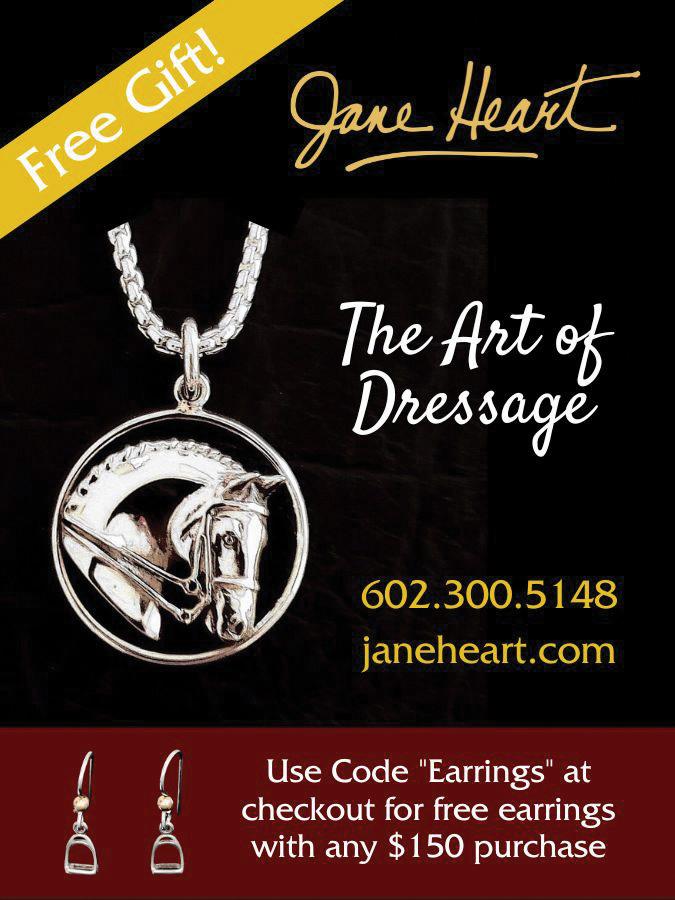


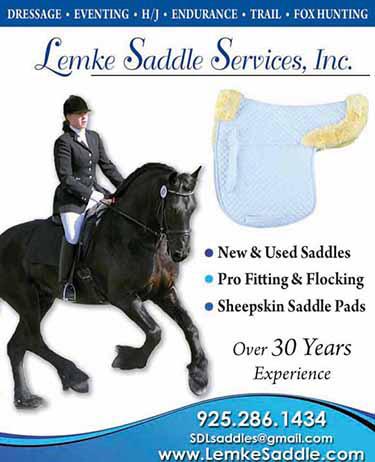
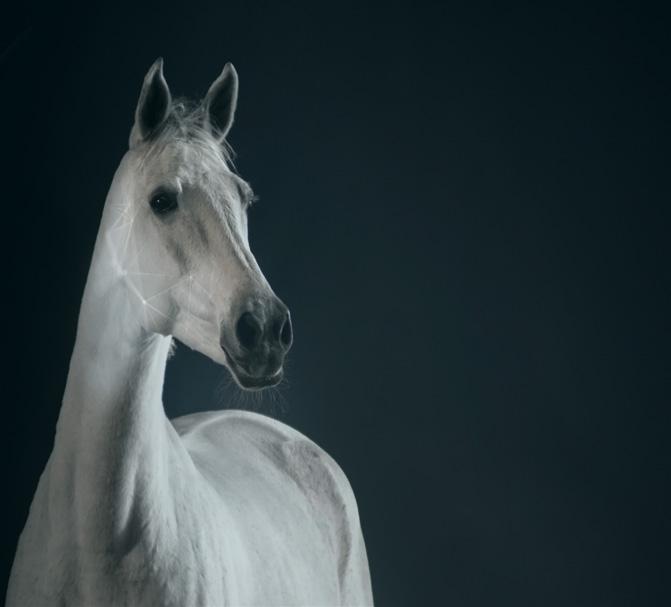

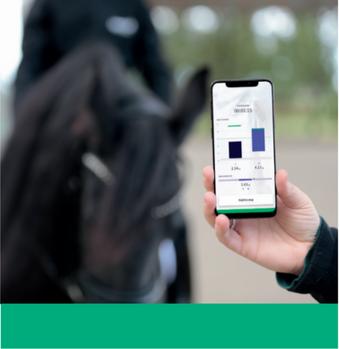
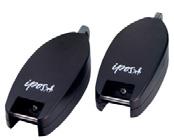


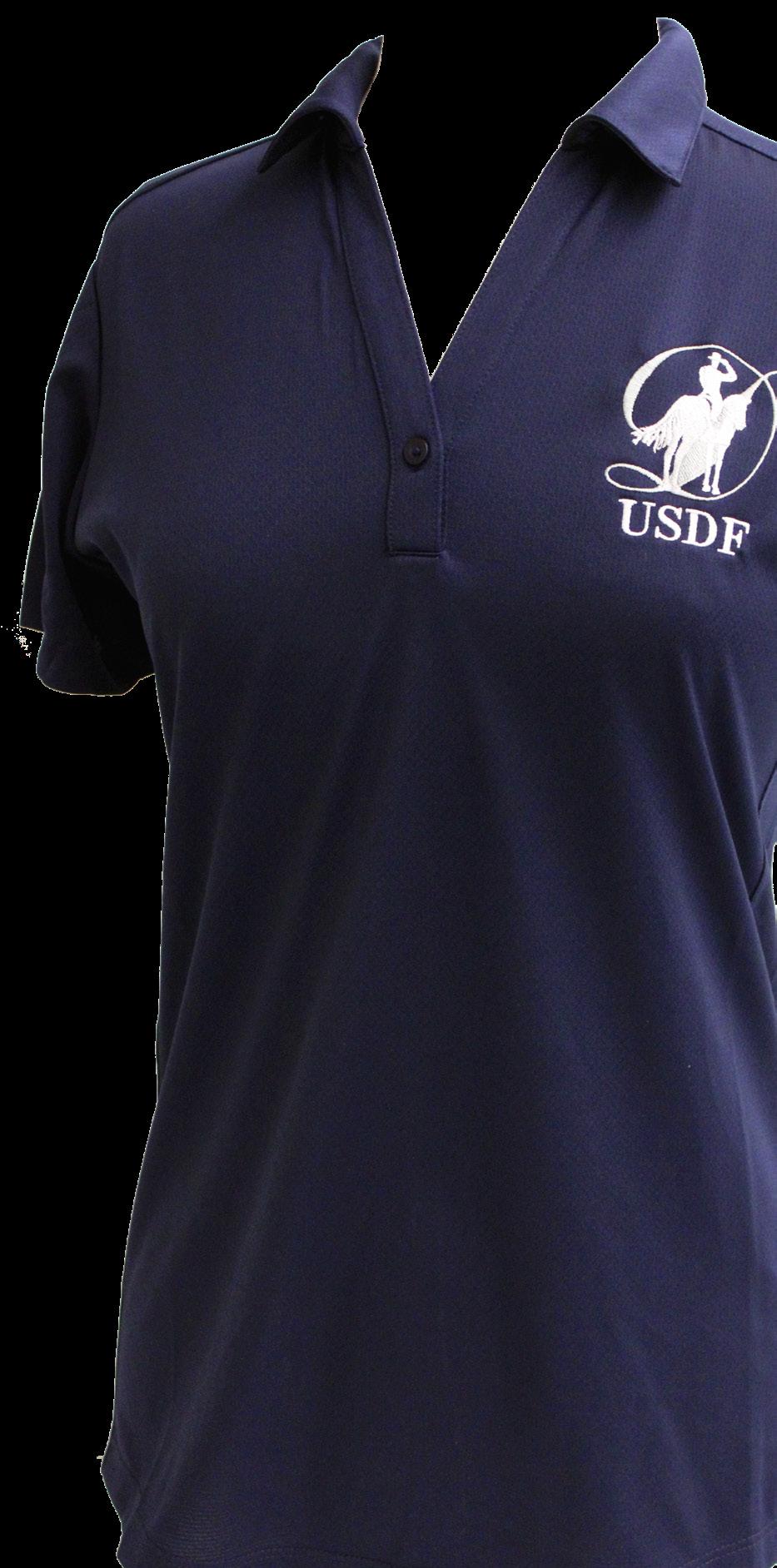

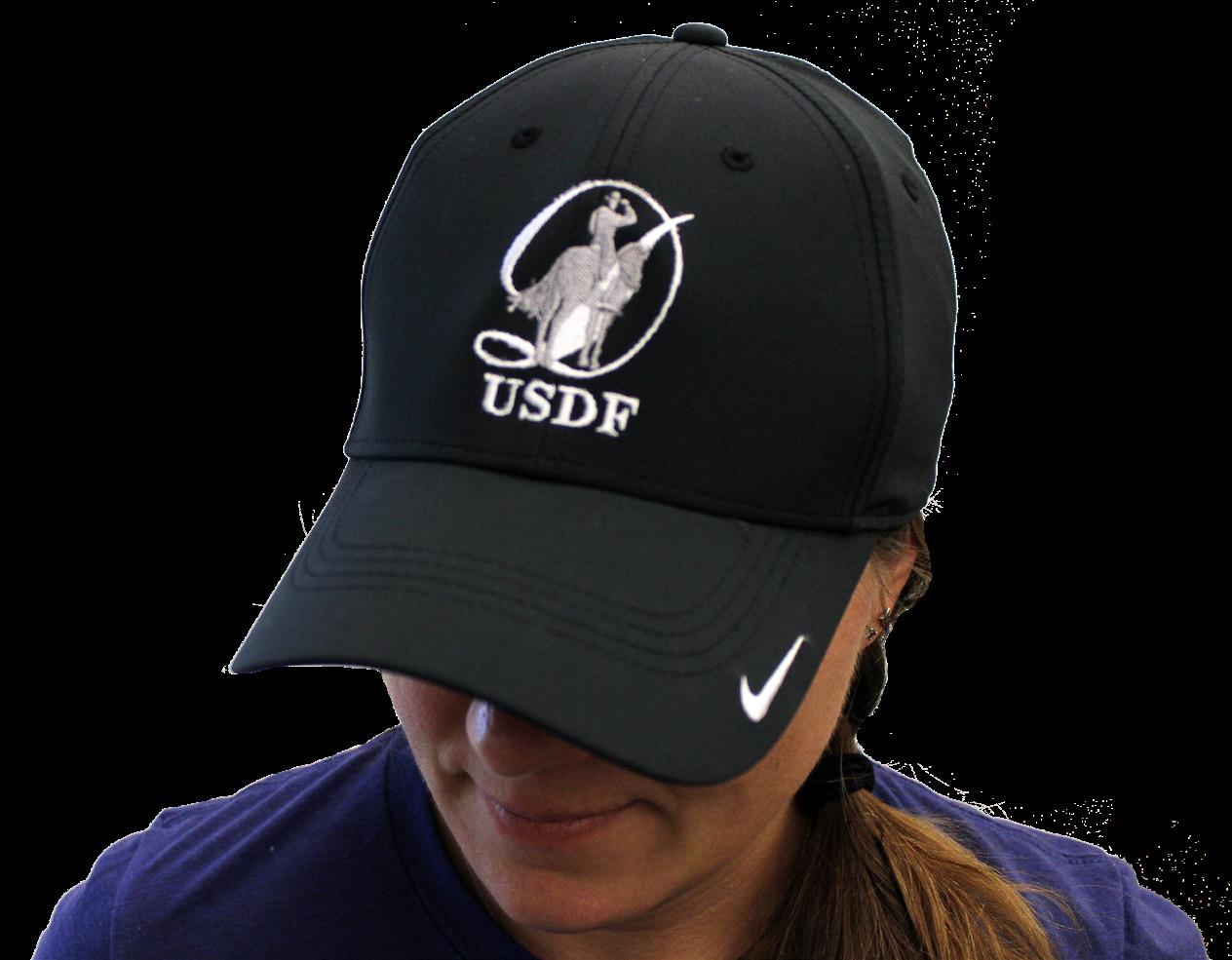
For specific staff contacts visit the USDF Web site.

USDF Connection wants YOU to be a contributor.
Here’s how.
Air Your Views
USDF Connection welcomes letters to the editor. Please send your digital submission by e-mail to jbryant@ usdf.org. Please include your hometown, state, and daytime telephone number. We’ll publish letters as space allows; all submissions are subject to editing. Unsigned letters will not be considered, although writers may request that their names be withheld. All letters become the property of USDF.
Do you have a dressage- or USDFrelated question? Send it to “FAQ” and you may get an expert response in a future issue of USDF Connection.

Send your question, along with your full name, hometown, state, and daytime telephone number to editorial@usdf.org. Include “FAQ” in the subject line of your message.

In 2000, then-USDF Region 9 director Sarah Jane Martin stepped up in an extraordinary way when the organization was in crisis.
Still in its original location of Lincoln, Nebraska, the USDF headquarters had become something of a revolving door. In September, as Martin was nearing the end of her second term on the USDF Executive Board, the board dismissed a second USDF executive director in a row, leaving the organization rudderless.
of three. She was 13 when her family moved from the Houston area to La Porte, Texas, to run a marina.
“I said I wouldn’t go unless I could get a horse,” Martin recalls. “We had four acres on Galveston Bay, and [my father] let me buy a horse. I’ve never not had a horse since then.”
At the marina, Martin and her father gave sailing lessons to customers who bought boats. When Lawrence David Martin came to take his lesson in July 1976, his instructor was a bikini-clad Sarah Jane. They were married that same year.
Sadly, Martin’s father died in March 1985, followed that August by her husband. In 1986 the family sold the marina and moved back to Montgomery, Martin with her two young children in tow. She’s run Seabreeze Gelbvieh ever since, raising the breed that she calls German warmblood cows.
computer-systems analyst. For a while, she owned a tack shop. Today, she is an enrolled agent with the IRS and does income tax.
Officially hired as USDF’s executive director in January 2001, Martin dealt with continued turbulence in the office. Employees quit and were rehired. She put in long hours. Even so, “I really enjoyed my time at USDF. I really did,” she says.
The major initiative during Martin’s tenure was the USDF’s decision to relocate its offices to Lexington, Kentucky, and it fractured the relationship.
“I said, ‘Who’s gonna run the place?’” Martin recalls in her Texas drawl. There was talk of a talent search, but Martin kept pressing. “I said, ‘Who’s gonna run it this week?’”
A widow, Martin was at the time operating her family’s cattle ranch, Seabreeze, in Montgomery, Texas, with her two children. But she said to the board: “I’ll go up there for a couple weeks and run it ’til you can get somebody.”
On October 8, 2000 (Martin remembers the date well because it is her wedding anniversary), she moved to Lincoln to become USDF’s acting executive director.
The daughter of a cavalryman, Martin was put on a horse at the age
Like many dressage riders of the era, Martin started out as an eventer, but “I couldn’t get above third place because my dressage was so lousy.” She began taking lessons with area pro Lurena Bell. But “back then, you did dressage to do other things,” Martin explains. “It wasn’t the main focus.”
Martin has dabbled in a variety of breeds and disciplines. Her barn currently houses Welsh ponies (she’s bred them for 40 years), a couple of warmbloods, a half-Arabian/halfWelsh pony, and a Quarter Horse that Martin refers to as her guest horse. She is a US Equestrian dressage technical delegate and an FEI dressage steward, and she holds USEF licenses to judge Friesians, Connemaras, Welsh ponies, and Western dressage.
Martin’s professional experience is equally diverse. She taught high-school chemistry for four years, then worked at Exxon as a
“Most of the board wanted to move, and I probably did too; I just didn’t think it was the time to do it,” she explains. The office ship had been righted, and “I wanted to get a better deal, and we were really doing pretty good in Lincoln,” she says. Martin resigned in January 2002. But “in less than 24 hours, I was hired back on to hire somebody to do the computer system,” she says. Back in Texas, she worked from home for “well over a year.”
Since that time, Martin, now 75, has focused on supporting dressage at the local and regional levels, including serving as a regular USDF Board of Governors delegate. For many years she has chaired the Southwest Dressage Championships, a regional dressage competition.
Health issues have kept Martin out of the saddle, so she’s doing more driving these days. But she hasn’t lost her passion for dressage, and the USDF owes her a debt of gratitude for helping to chart its course through a very choppy period in its history.
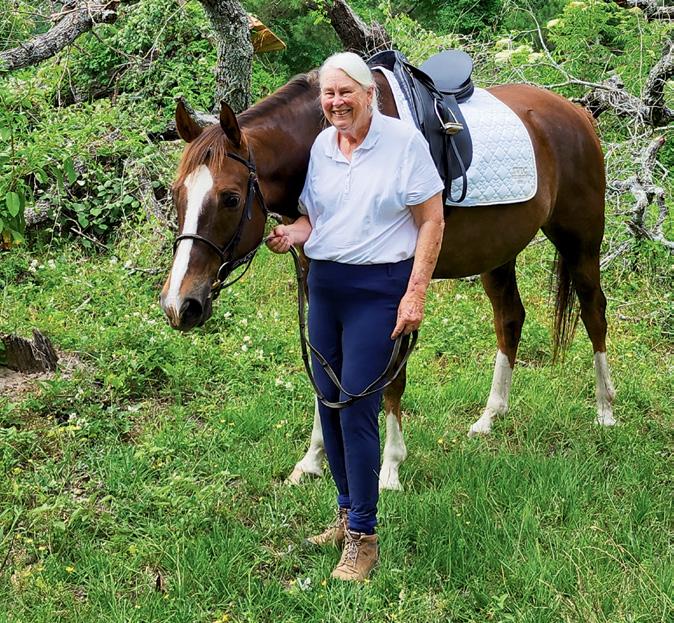


SARAH TUBMAN
This 2019 Pan American Games
Individual Gold Medalist recognizes the power of nutrition. She’s been a Platinum client since 2012.
A gold medal doesn’t happen overnight. It takes passion, dedication, hard work and the right nutrition to reach your goals. For over 25 years, Platinum Performance® has been improving the lives of horses by impacting health, from the inside, through advanced nutrition. No matter the level of achievement we seek, the love and care for our horses start from a place deep inside of us all.
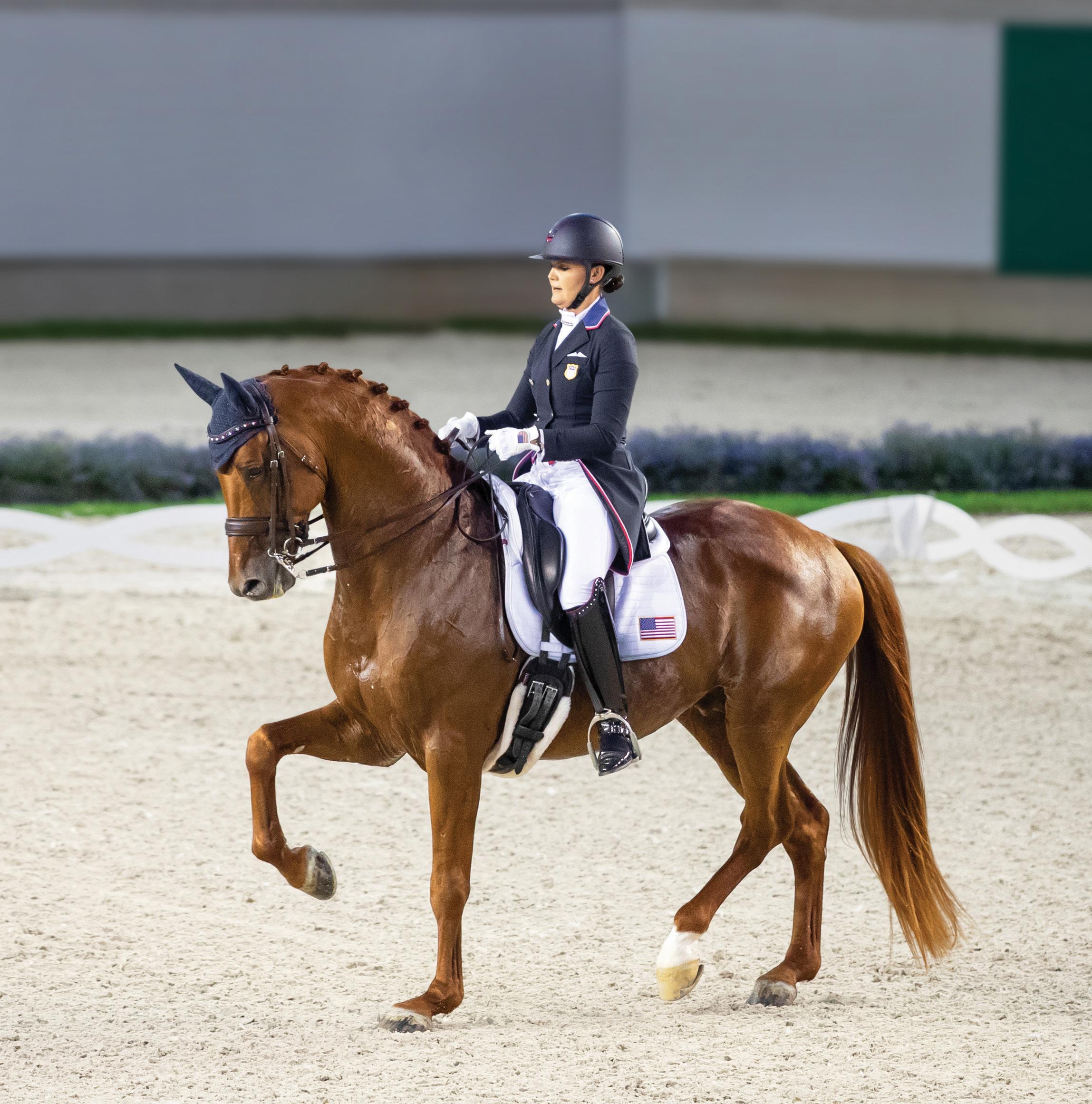
THE POWER OF NUTRITION STARTS WITHIN.
The nutrition supporting Sarah’s team includes: Platinum Performance®
• Healthy Weight Sarah Tubman is a sponsored endorsee and actual client.
